

Enrol in Rotana Rewards Select and save 10% off room rates Book a stay at any Rotana hotel or resort in the region and receive 10% off all public room rates with flexible cancellation, 10% off dining, as well as access to exclusive VIP amenities, late check-out and more. Book now via rotanarewards.com and download our Rotana Rewards Mobile App, or call us at +971 (0) 2 811 9777.
Managing director
Joumana Dammous-Salamé
Publication manager
Randa Dammous-Pharaon
Publications deputy manager
Rita Ghantous
Sub-editor
Miriam Dunn
Account managers
Maha El-Khoury, Josette Hikri advertise@hospitalitynewsmag.com
Subscription executives
Houayda Haddad-Roumman, Mirna Maroun
subscribe@hospitalitynewsmag.com
Circulation coordinator
Rita Nohra-Kejijian
Graphic designer
Ibrahim Kastoun
To advertise advertise@hospitalitynewsmag.com
Published by Hospitality Services
LEBANON
Borghol Building, Dekwaneh Tel: +961 1 480081
UAE HSME Tel: +971 585098057
info@hospitalitynewsmag.com www.hospitalitynewsmag.com
All the information disclosed in the magazine was provided by the parties concerned by each publication and checked to the highest possible extent by the editors. However, the magazine cannot ensure accuracy at all times of all information published and therefore could in no case be held responsible should any information reveal to be false or insufficient.
We welcome views on any subject relevant to the hospitality industry, but request that letters be short and to the point. The editor reserves the right to select and edit letters.
Hospitality News ME is distributed to trade professionals in the catering and lodging industry in the Middle East.
Most importantly, chefs should accept that in this continuously changing world, they should be lifetime learners. They should learn how to adapt to the transformations happening around them and be open to widening their knowledge base.
Nouhad Dammous (December 2020)
Late editor-in-chief
Docteur Honoris Causa

AN EXCITING, EVOLVING REGIONAL GASTRONOMY SCENE
Award-winning industry expert Thomas A. Gugler, president of Worldchefs and vice-president of Culinary at Catrion, KSA, gives an insightful overview of the hospitality sector's current state of play.
The path to excellence
The key to culinary excellence begins with a robust and intensive apprenticeship. Being prepared to take up the ample training opportunities available across all culinary segments is a crucial next step, with at least five or six months needed in each section. In terms of essential qualities, a commitment to going the extra mile, dedication and motivation are among those that are pivotal. Others include self-drive, a readiness to take on challenges, the ability to accept criticism and a willingness to embrace corrective measures. Aspiring chefs should actively seek out diverse experiences in various industry segments, from hotels and restaurants to fastfood establishments and hospitals. This breadth of experience opens doors to countless opportunities.
A flourishing culinary scene
As Worldchefs’ continental director for the Middle East and Africa, I worked to increase membership, successfully bringing in 15 new countries. The recent surge of interest in cooking across the region is extremely promising, with chefs now motivated to represent their country on a global scale. The Eastmeets-West fusion trend and the blending of global artisan touches with local traditions are also contributing to the culinary scene’s current success. I can truly say that my journey of serving the region for 23 years fills me with immense pride.
Industry trends
Current industry trends include a move to give local, ethnic food a global, artisan touch. The global chefs’ network is also leading the way in setting new trends. These and other industry developments remind me of how proud I am to be a chef, contributing to people’s health and happiness through good food.

Thomas A. Gugler President of Worldchefs and VP of Culinary at Catrion, KSA worldchefs.org
OPINION
MAY-JUL 2024 | HOSPITALITY NEWS ME 3
HORECA NETWORK
6 SAUDI HORECA Jeddah marks success
8 HORECA Lebanon embraces the future of hospitality
10 HORECA Oman unveils exciting new features
EVENTS
SEEN AND HEARD
12 Future-focused agenda for FHS Saudi Arabia 2024
13 ‘Own the Change’ theme for SIAL Paris 2024
BUSINESS INTERVIEW
14 Duncan O’Rourke on creating memorable, meaningful moments in the Middle East OPINION
16 How to strategize in uncertain times INFLUENCERS
18 4 experts unwrap the secrets of chocolate’s sweet success MARKET UPDATE
24 The UAE: positive indicators and plenty more in the pipeline TRENDS
26 How to harness the power of the metaverse F&B
28 Cross-culinary exchange: gastronomy goes global EYE ON THAILAND
32 A Southeast Asian symphony of flavors TECHNOLOGY
34 New technologies: today's essential tools for hoteliers
36 Today's balancing act: automation vs. personalization
38 The AI takeover in hotel advertising ARCHITECTURE
40 Adaptive reuse: an architectural game-changer
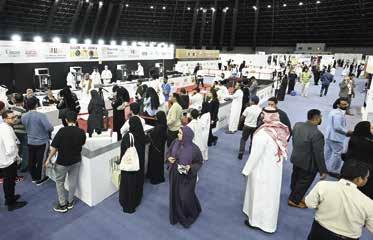
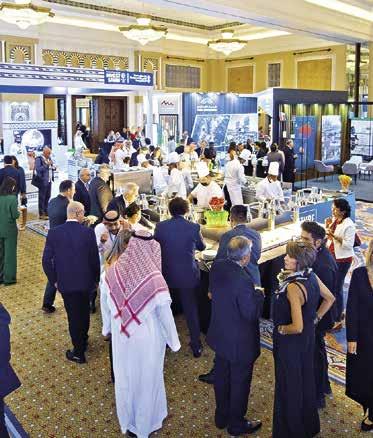
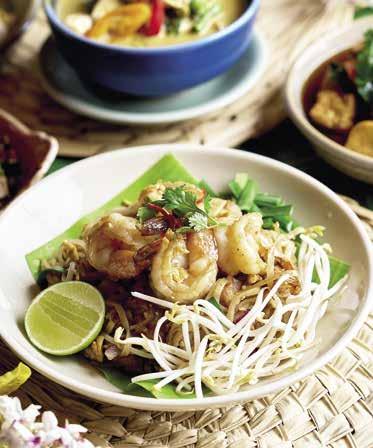
In this issue MAY - JUL 2024
12
6
FHS Saudi Arabia
32 A Southeast Asian symphony of flavors
Saudi HORECA Jeddah
FOR UP-TO-THE-MINUTE NEWS FROM THE HOSPITALITY INDUSTRY, VISIT HOSPITALITYNEWSMAG.COM HospitalityNewsME @Hospitality_Mag Hospitality-news-middle-east HOSPITALITY NEWS ME | MAY-JUL 2024 4
Special report: COFFEE
44 12 steps to building a world-class coffee brand
46 What’s in store: coffee with a designer touch
48 Why the coffee value chain needs a major rethink
50 8 ways that smart coffee chains are transforming the industry
52 5 coffee-tech talking points
53 Coffee innovations
SOLUTIONS
54 Going global: 7 ways to boost exports
56 How to convert clicks into bookings
57 How to unleash the power of tech in HR GREEN
58 8 Ways F&B businesses can prioritize sustainability


62 Essential kit for the
Pasta: a staple for the table
70 4 experts on what's shaking up the cocktail scene
74 Gold and pecan mousse tarte
- OCT 2024
• Special report New hotel projects and investments
• Influencers Hoteliers
• Equipment Online booking portals
• Food Cheese
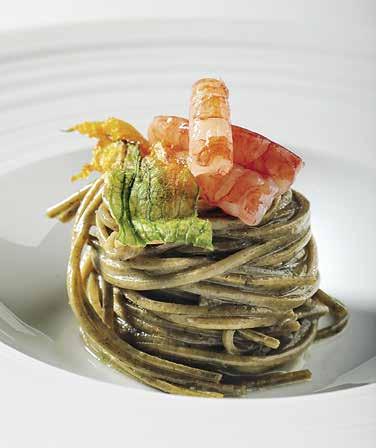
66
ZONE ON THE MARKET
New products EQUIPMENT
kitchen FOOD
BEVERAGE
Pasta: a staple for the table
PRODUCT
60
66
CHOCOMANIA
• Beverage Milk Coming issue AUG
42 Coffee 57 How to unleash the power of tech in HR
MANAGEMENT
MARKETING
HUMAN RESOURCES
MAY-JUL 2024 | HOSPITALITY NEWS ME 5
SAUDI HORECA JEDDAH MARKS SUCCESS
Dedicated to food, beverage and hospitality, SAUDI HORECA Jeddah marked another successful edition at Jeddah Superdome from February 5-7. Championing the Kingdom's burgeoning hospitality landscape, the event brought together a vast network of industry experts, leaders and innovators. We take a look at some of the many highlights.
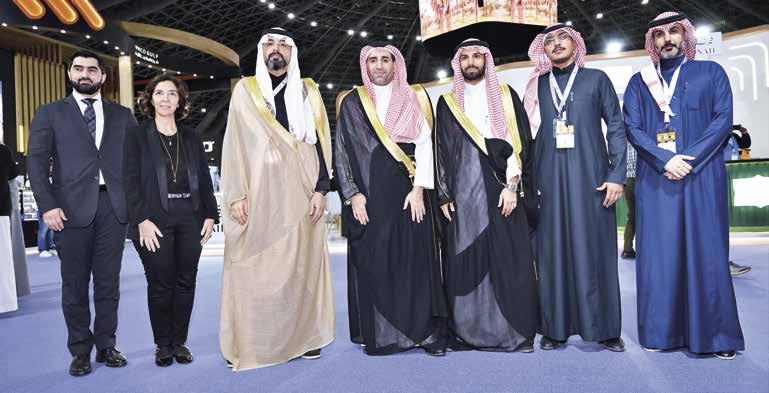
Organized by the Saudi Event Management and Marketing Company (SEMARK Group) in partnership with Hospitality Services, Saudi HORECA Jeddah featured a series of exciting competitions and live demonstrations. These included the Hospitality Salon Culinaire, which showcased live cooking competitions for Saudi, oriental and dessert dishes, a mocktail competition and the Saudi Barista Competition, where over 20 participants contested for the title of Best Barista in Saudi Arabia.
In addition to the engaging competitions, SAUDI HORECA Jeddah offered a lineup of inspiring workshops and seminars, addressing key topics in the hospitality and foodservice sectors. Thought-provoking and interactive panel discussions brought together inspiring leaders from the hospitality, food, culinary and technology realms, allowing attendees to gain valuable insights and perspectives on future challenges and opportunities.
SAUDI HORECA Jeddah welcomed over 15,000 visitors to explore over 12,000 innovative products, cutting-edge technologies and services from more than 150 leading local, regional and international companies, set out across an expansive 16,000 square meters of exhibition space.
The third edition of SAUDI HORECA Jeddah is taking place from April 21-23, 2025, at Jeddah Superdome. saudihoreca.com
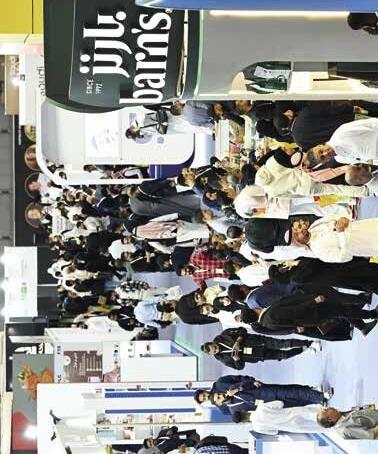
REVIEW HORECA NETWORK HOSPITALITY NEWS ME | MAY-JUL 2024 6
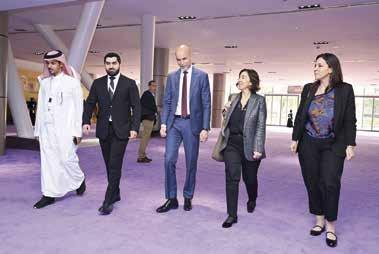


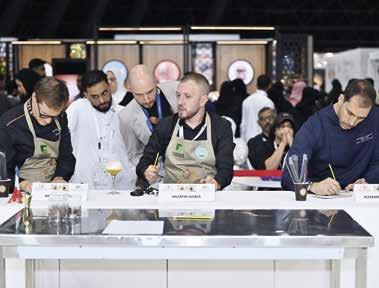
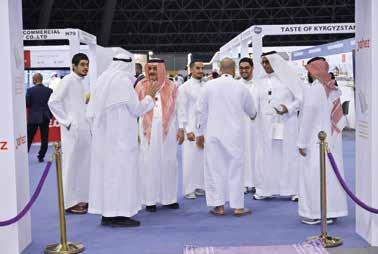

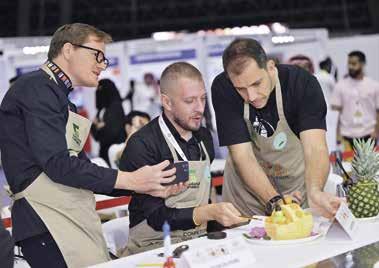
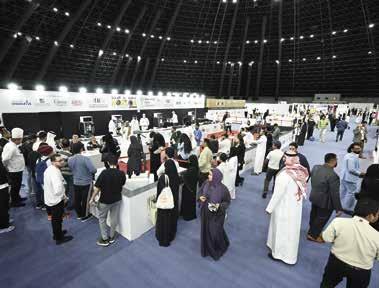
MAY-JUL 2024 | HOSPITALITY NEWS ME 7
HORECA LEBANON EMBRACES THE FUTURE OF HOSPITALITY
HORECA Lebanon, the annual meeting place for the hospitality and foodservice industries, closed its doors on April 19 after an exhilarating four days at Beirut’s Seaside Arena. Showcasing cutting-edge innovations and trends, the event was hailed a remarkable success, attracting over 19,000 visitors and gathering together 350 exhibitors, from food and beverage producers to labeling and packaging, agri-food startups, heavy machinery manufacturers and more.
The opening ceremony of HORECA Lebanon, which took place on April 16, welcomed Beirut Governor Marwan Abboud, Lebanon's Minister of Tourism H.E. Walid Nassar and Minister of Industry H.E. George Boujikian. Ambassadors, presidents of associations, industry leaders and a multitude of media representatives were also present.
'Embrace the Pace of Hospitality' was the guiding theme of this year's HORECA Lebanon, symbolizing the event’s commitment to honoring the great strides that are being made in the region’s hospitality and foodservice sectors.
HORECA Lebanon boasted a vibrant program of demonstrations and competitions at the HORECA Theatre and HORECA Stage. These included the Hospitality Salon Culinaire, the Junior Chef Competition, the Lebanese Bartenders Competition, Mocktail Competition and Lebanese Barista Competition. Additionally, culinary enthusiasts enjoyed a variety of activities, namely masterclasses with renowned chefs from Lebanon and abroad.
Moreover, the event included an engaging series of panel discussions at HORECA Talks, which delved into the hottest industry topics. Meanwhile, at HORECA Innovations, 30 of the best Lebanese import substitutes and innovative products were showcased. Carefully chosen by an advisory board, the curated selection included items such as black garlic, pepper paste and vegan hummus.
Elsewhere, HORECA’s Hosted Buyers’ Program — organized in partnership with QOOT and the Association of Lebanese Industrialists (ALI) — brought together more than 450 Lebanese companies and 20 international buyers with an aim to boost Lebanese exports and ensure their successful promotion abroad.
In addition, HORECA Lebanon paid tribute to two remarkable individuals whose contributions have left an indelible mark on the culinary and hospitality sectors. Hala Matar Choufany, president of HVS Middle East, was presented with the Industry Excellence Award, while chef Thomas A. Gugler, president of WORLDCHEFS/WACS, was honored with the Lifetime Achievement Award.
Joumana Dammous-Salame, managing director of Hospitality Services, HORECA organizer, said: "As we mark the end of this special edition, let us carry forward the spirit of unity and innovation that has defined us. Together, we are not just reimagining the industry; we are shaping its future, setting new standards and inspiring generations to come. The best is yet to come, and we are ready for it."
The 29th edition of HORECA Lebanon will be held at Seaside Arena from April 8-11, 2025.
horecashow.com



REVIEW HORECA NETWORK
HOSPITALITY NEWS ME | MAY-JUL 2024 8
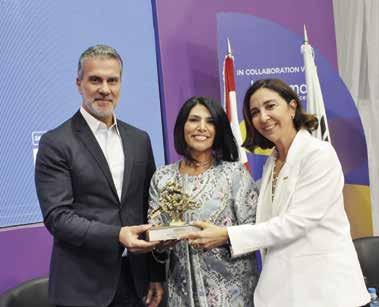
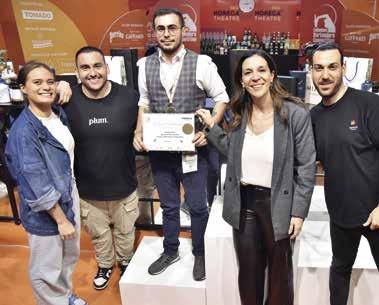


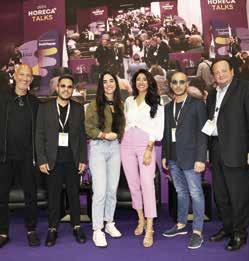



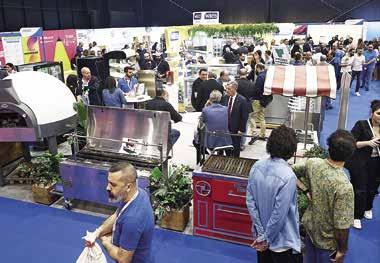
MAY-JUL 2024 | HOSPITALITY NEWS ME 9
HORECA OMAN
UNVEILS EXCITING NEW FEATURES
HORECA Oman, the annual meeting place for the hospitality and foodservice industries, is taking place from June 4-6 at Oman Convention & Exhibition Centre. This year's event promises to be even more captivating, offering a diverse array of activities, competitions and events. Here's everything you need to know.
With over 200 local and international exhibitors spread across 5,000 square meters, HORECA Oman — co-organized by Hospitality Services and Al Nimr Expo — is set to welcome more than 5,000 local and international professionals and buyers, offering them the opportunity to explore thousands of products and services.
Salim Al Hashmi, CEO of Al Nimr Expo, said: "Partnering with Hospitality Services for HORECA Oman's third edition is a thrilling opportunity. This event promises to showcase the best of Oman's hospitality and foodservice sectors, offering a vibrant platform for connections, insights and business growth."
According to Maha El Khoury, project and sales director of HORECA Oman, the event aims to spotlight every facet and trend within the hospitality and foodservice industries, which it achieves through its jam-packed program. She said: "HORECA Oman serves as a live platform for connections, insights and business opportunities, featuring a vibrant daily schedule of competitions, masterclasses and networking sessions. The Hospitality Salon Culinaire, Barista Competition, Mocktail Competition and Bed Making Competition are all dedicated to celebrating and rewarding local talents and rising stars in Oman."
The Marketplace will facilitate exhibitor-visitor interactions, while the Hosted Buyers’ Program will bring global buyers to Oman, creating new opportunities for local industrialists and SMEs.
Joumana Dammous-Salame, managing director of Hospitality Services, said: "HORECA Oman serves as a vibrant hub for the nation's hospitality and foodservice sectors, embodying Oman's rich cultural heritage and its progressive spirit in the culinary arts. We are confident that this year's edition will be memorable and encourage all hospitality and foodservice professionals to register to attend on the website."
horecaoman.com
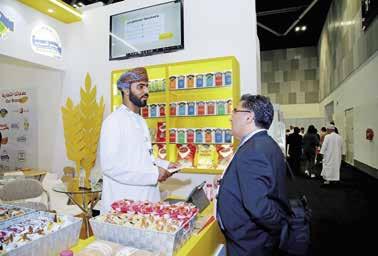
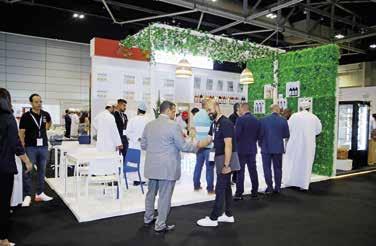

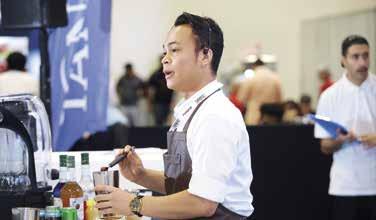
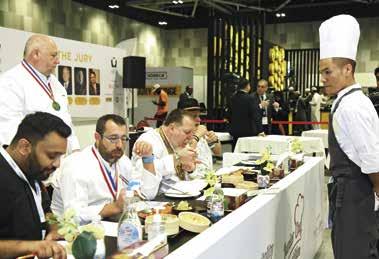
PREVIEW HORECA NETWORK
HOSPITALITY NEWS ME | MAY-JUL 2024 10
BRINGING OUT THE BEST IN BURJ ON BAY


What do you regard as your key career milestones?
Over the 25 years I’ve worked in hospitality management, I’ve had the privilege of achieving several significant milestones. These include spearheading the successful openings of multiple hotels and resorts, and concepts in various locations, implementing innovative operational strategies that have enhanced guest satisfaction and profitability, and cultivating a culture of excellence, elevated standards and teamwork within my teams.
What are your top responsibilities and objectives in your role as director of operations at Burj On Bay Hotel?
My primary responsibilities revolve around ensuring the smooth and efficient functioning of all hotel departments, maintaining high service standards, optimizing operational processes and maximizing revenue generation, while controlling costs. My objectives are to elevate guest experiences, drive operational excellence, foster a positive work environment and contribute to the hotel’s overall success and growth. In addition, there are daily brainstorming sessions for new experiences to be implemented at the hotel from all parts of the world.
How do you plan to harness your expertise to enhance the guest experience and overall operations at Burj On Bay Hotel?
Leveraging my extensive experience in hospitality management, I plan to implement best practices, streamline
Nicolas Broumana, seasoned hospitality leader and director of operations at Burj On Bay Hotel, Société Cordon Bleu Liban, shares his vision for positioning the 5-star hotel as a regional beacon of luxury, hospitality and innovation.


processes and introduce innovative initiatives to enhance both operational efficiency and guest satisfaction at Burj On Bay Hotel. By focusing on personalized service, staff training and empowerment, and staying attuned to evolving guest preferences and industry trends, I aim to elevate the overall guest experience and establish Burj On Bay Hotel as a premier destination for hospitality.
What leadership principles do you consider essential for successful management?
In managing hotel and all outlet operations, I consider several leadership principles essential for success. These include effective communication, leading by example, fostering a culture of collaboration and accountability, empowering and developing team members, adaptability to changing market dynamics and a relentless commitment to delivering exceptional service and experiences. Achieving success is always down to the entire team and I am a firm believer in ensuring that everyone involved feels recognized and appreciated for their efforts.
What plans are in place for Burj On Bay Hotel under your guidance?
I envision positioning Burj On Bay Hotel as a beacon of luxury, hospitality and innovation in the region. My plans include: investing in staff training and development; implementing sustainable practices; enhancing technological capabilities to streamline operations and improve guest interactions; forging strategic partnerships to expand our reach and offerings; and continuously striving for excellence in all aspects of hotel operations.

Do you have any new projects in the pipeline?
The NEST Restaurant & Lounge Bar, which we opened last year, enjoyed tremendous success both locally and regionally, offering an exceptional dining experience from early sunset through late clubbing hours. As we prepare to reopen this season, we’re thrilled to be introducing several enhancements that will elevate the overall ambiance. These additions will include curated food items and drinks, accompanied by elevated music, promising a fresh experience for our guests and aficionados of sophisticated concepts.
We’re also delighted to announce our upcoming winter project: a French lounge and club boasting an eclectic design and ambiance. This endeavor aims to cater to enthusiasts of lounge settings and fine dining, providing them with an opportunity to enjoy breathtaking winter views in a classy and exhilarating atmosphere. Our project will seamlessly blend elements of French and English styles, promising a memorable experience even after the season concludes.
In addition to these developments, we’re currently in the process of renovating our upper-floor rooms and suites. These renovations aim to provide luxury and ample space, ensuring a 5-star experience for our discerning guests.
burjonbay.com nbroumana
burjonbay nestlb
Advertorial
MAY-JUL 2024 | HOSPITALITY NEWS ME 11
FUTURE-FOCUSED AGENDA FOR FHS SAUDI ARABIA 2024
RIYADH SUMMIT HIGHLIGHTS KSA’S HOSPITALITY AND TOURISM POTENTIAL.

With a stellar lineup of 185 industry speakers, an action-packed agenda and 1,500 hotel investors, Future Hospitality Summit (FHS) Saudi Arabia 2024 took place at the Mandarin Oriental Al Faisaliah Hotel in Riyadh from April 29 to May 1, 2024 to great acclaim.
This year’s event brought together an impressive mix of government leaders, hospitality investors, owners and operators looking to expand their networks, gain critical industry insight and influence the industry’s future.
Held under the banner ‘Invest in Tomorrow: Today, Together,’ FHS Saudi Arabia 2024 explored a range of topical, industry-related issues, including sustainable development, investment opportunities, industry entrepreneurship and human capital across Saudi Arabia’s hospitality and tourism sectors.
The three-day event showcased a rich and varied program, which ranged from engaging presentations, panel discussions and fireside chats to case studies, keynotes and workshops. In addition, delegates had the opportunity to immerse themselves in a host of carefully curated networking activities and event experiences.
Investor-friendly initiatives
Following welcome remarks from Khalid Saud Abu Haimed, chief executive officer, Al Khozama Investment Company, the conference program began with a keynote presentation by Mahmoud Abdulhadi, deputy minister, Destination Enablement,
Ministry of Tourism Saudi Arabia, in which he explained how the investment opportunities available in the Kingdom’s hospitality sector aligned with Vision 2023.
Commenting ahead of the event, Abdulhadi highlighted key initiatives that were already reaping rewards, such as the introduction of the e-visa in 2019, which has helped the country to already record impressive annual visitor numbers of 100 million. He highlighted two major initiatives of interest to investors: the Tourism Investment Enablers Program (TIEP), a one-stop-shop set to make investing in Saudi Arabia more seamless and cost-friendly for business leaders; and the Hospitality Investment Enablers initiative, which aims to incentivize investors and make key destinations in Saudi even more competitive.
Technology in the spotlight
Technology was a key focus at FHS Saudi Arabia 2024, with industry leaders discussing AI, the Metaverse, AI-IT-human touch intersection and tech stack investment tips for owners and operators. Tech-led highlights included a live Q&A and Fireside Chat with humanoid robot lead vocalist of the Desdemona Dream Band, Desdemona (Desi) and Janet Adams, chief operating officer, SingularityNET.
Another key, first-time attraction was ‘Destination Tomorrow: Unveiling of Investment Opportunities,’ an exclusive platform showcasing innovative and emerging destinations in Saudi Arabia’s hospitality and tourism sector.
Topical talks, campaigns and forums
Also new on the agenda were the TENX Leadership Talks, short, powerful presentations by industry leaders on hot industry topics. Other firsts at the summit included Speakers Corner, which provided an opportunity for attendees to share personal narratives of overcoming challenges and achieving success in the industry, and a #FHSWomenPower campaign, championing gender diversity and women empowerment in the industry.
Initiatives back by popular demand, meanwhile, included the Global Restaurant Investment Forum (GRIF), bringing together the restaurant investment community for a future-focused program of main stage presentations, F&B workshops, culinary and concept tours, and a dedicated networking dinner. Topics at GRIF included insights on the future demands of the hospitality consumer; the changing F&B landscape; the importance of leveraging industry data to maintain a competitive edge; and the critical role of F&B in enhancing the bottom line. The popular Startup Den and FHS Site Tours also made a welcome return.
Reaffirming the annual summit’s status as the region’s largest hospitality investment event, FHS Saudi Arabia 2024 was organized by The Bench, with the support of host sponsors Al Khozama Investments and the Mandarin Oriental Al Faisaliah Hotel.
futurehospitalitysummit.com
SEEN AND HEARD EVENTS
HOSPITALITY NEWS ME | MAY-JUL 2024 12
‘OWN THE CHANGE’ THEME FOR SIAL PARIS 2024
Over 7,500 exhibitors expected for 60th anniversary food industry event.

The leading food innovation exhibition SIAL Paris will mark its 60th anniversary with a landmark edition from Saturday, October 19 to Wednesday, October 23, 2024, at the Parc des Expositions, Paris Nord Villepinte, France.
Featuring several exciting new highlights, this year’s five-day milestone event will offer industry professionals an opportunity to reflect on six decades of groundbreaking innovations and explore what the future of the food sector looks like.
Embracing transformation
The 2024 edition of SIAL Paris takes place under the banner ‘Own the Change,' reflecting the organizers’ broader aim to encourage attendees to embrace the ongoing transformations underway in the industry and tackle global food challenges. As part of this collective drive, SIAL Paris 2024 will be showcasing exhibitors’ corporate social responsibility (CSR) projects and their expertise in this field through a range of initiatives, including: SIAL Insights, a biennial analysis of industry trends; SIAL Innovation, offering a glimpse into future developments; and SIAL Start-Up, which will feature twice as many promising new businesses as in the previous edition, including early-stage concepts.
Organized by Comexposium, SIAL Paris is the largest food industry trade fair in the world. A business generator and part of the global SIAL Network, it provides unique insights into trends and opportunities in the sector on a biennial basis.
In this anniversary year, the organizers expect to host over 7,500 exhibitors, from more than 130 countries, displaying more than 400,000 products. With estimated
attendances of 285,000 professionals, including 8,000 major buyers wielding a combined purchasing power of Euro 50 billion, SIAL Paris offers unparalleled visibility and business opportunities on the global stage.
Significantly, an impressive 75 percent of attendees are routinely international visitors. Data also reveals that in previous editions, 83 percent of purchasers agreed to transactions on-site or after the trade show.
Global representataion
In terms of international representation, France and Italy are currently vying for the top spot at SIAL Paris 2024, with mainstays, such as the US and Spain, also set to have a strong presence. At present, Italy has the edge in exhibition space, with over 16,000 square meters. A returning rising star, China is set to be back in force, showcasing more than 6,000 square meters of pavilions, while Ukraine and India will be reaffirming their growing influence on the global stage. Several countries from Africa are also scheduled to feature prominently, with the Ivory Coast and Senegal having already confirmed their participation. First-time participants, meanwhile, include Uganda, Libya and Iraq.
In a significant development and following feedback from the last event, the exhibition will also showcase a new floor plan, with stands this time organized by product type in order to facilitate visitor rounds.
Food of the future
Always a popular attraction, SIAL Innovation will once again run concurrently with the main trade show. Now recognized as a top showcase and
JUNE 2024
4-6 Jun. OMAN
HORECA OMAN
Al Nimr Expo & Hospitality Services horecaoman.com
8-11 Jun. IRAN IRAN AGRO FOOD Fair Trade iran-agrofood.com
AUGUST 2024
12-15 Aug. KINGDOM OF SAUDI ARABIA SAUDI FOOD EXPO
International Arabian Exhibition saudifoodexpo.com
SEPTEMBER 2024
2-5 Sep. AUSTRALIA FINE FOOD AUSTRALIA
Diversified Communications Australia finefoodaustralia.com.au
18-20 Sep. DUBAI SALON DU CHOCOLAT DUBAI Hospitality Services salonduchocolatdubai.com
17-19 Sep. KINGDOM OF SAUDI ARABIA THE HOTEL SHOW SAUDI ARABIA Dmg: Events Middle East & Asia thehotelshowsaudiarabia.com
30 Sep.-2 Oct. DUBAI FHS MIDDLE EAST Bench futurehospitalitysummit.com
OCTOBER 2024
1-3 Oct. JORDAN
HORECA JORDAN
Laurence & Husseini Consult & Expo Jordan horeca-jordan.com
competition for the food of the future, SIAL Innovation presents some 2,500 new products at each edition and is known for rewarding the best food innovations worldwide. Companies will once again be recognized with Gold, Silver and Bronze awards, with several other accolades also up for grabs. These include popular awards across the sectors and other new prizes, including four exciting first-time awards and a special accolade introduced to mark the 60th anniversary celebrations. Applications for the awards are now open. Winning entries will be displayed at the show and awards presented at a ceremony on the opening day, Saturday, October 19.
Aside from the activities at the convention center, visitors can expect to see culinary activities and related attractions in and around parts of Paris, further enriching the SIAL experience.
sialparis.com
CALENDAR
WHERE TO BE SEEN MAY-JUL 2024 | HOSPITALITY NEWS ME 13
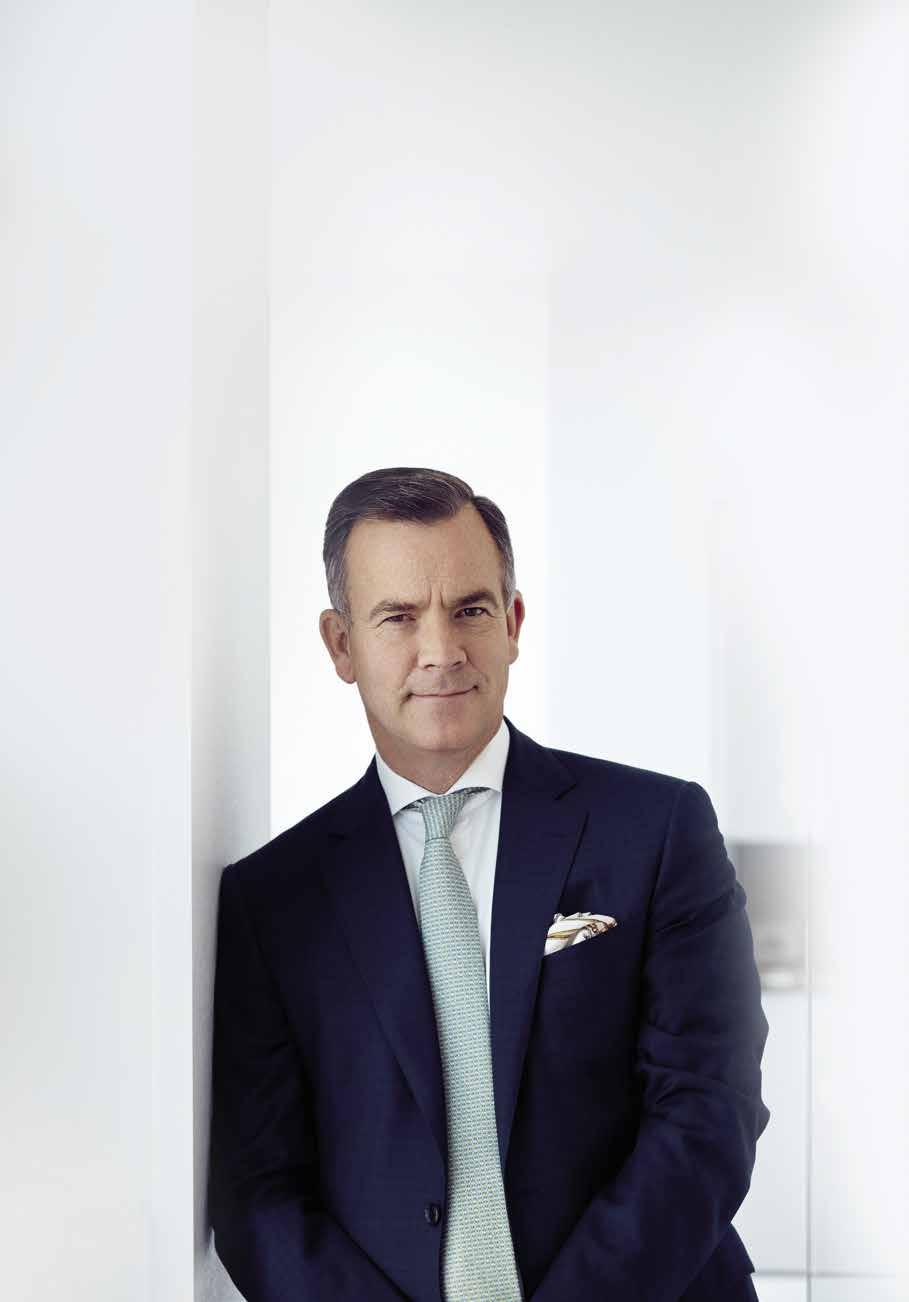
DUNCAN O’ROURKE
ON CREATING MEMORABLE, MEANINGFUL MOMENTS IN THE MIDDLE EAST
With the region’s hospitality industry currently flying high, Duncan O’Rourke, CEO of Accor’s Premium, Midscale & Economy Division, Middle East, Africa & Asia Pacific, tells HN how the company plans to strengthen the footprint of its brands and drive growth through strategic expansion.
INTERVIEW BUSINESS
HOSPITALITY NEWS ME | MAY-JUL 2024 14

What do you regard as your career highlights to date?
Guiding our teams through the pandemic was a defining moment in my career. This experience shed light on the incredible resilience, flexibility and unity within Accor. Seeing everyone come together with innovative ideas and a firm commitment to supporting our teams, owners and communities was truly inspiring.
At the beginning of the pandemic, Accor moved quickly to establish the ‘ALL Heartist Fund’ to assist our teams. This fund was designed to help Accor team members who were facing financial hardships due to the impact of Covid-19.
This time wasn’t just about overcoming obstacles; it also encouraged deeper connections and camaraderie within our Accor family. Navigating through these tough times strengthened our resolve and personally taught me valuable lessons in leadership and teamwork.
How would you describe your leadership style?
As the CEO of the Premium, Midscale & Economy Division, Middle East, Africa & Asia Pacific (MEA APAC), I lead a region of more than 130,000 team members across 40 countries and embrace a transformational leadership style characterized by empowerment, encouragement and guidance. I believe in empowering individuals within our organization and nurturing a culture where everyone feels valued and capable of making meaningful contributions. I am passionate about stretching the limits of what our team can achieve.
Central to my leadership philosophy is coaching - actively mentoring and supporting our teams, to enable them to excel in their roles. I prioritize open communication and collaboration, creating an environment where ideas are encouraged and feedback is welcomed.
With this team, Accor has witnessed positive transformations, both in terms of business growth and team satisfaction. This inclusive and supportive leadership style inspires a sense of unity and purpose within the organization, driving us toward shared success.
How are Accor hotels performing in the Middle East?
As a world leading hospitality group, Accor currently counts 275 properties (75,000 keys) across all brands in the Middle East with 136 properties (more than 38,000 rooms) within the ‘Premium, Midscale & Economy’ brands. Accor hotels in the Middle East, particularly in the UAE and Qatar, are thriving due to the region’s robust travel and tourism prospects. With prime locations, diverse amenities and unwavering dedication to quality, they consistently draw visitors, boosting the region’s tourism goals. Saudi Arabia’s Vision
2030 plan also offers further promising prospects for hospitality expansion, enhancing the region’s allure for both corporate and leisure travelers.
We are deeply grateful to our tourism partners across the Middle East and Africa, for their unwavering support as we expand our presence in the region and contribute to the growth of local communities.
As we continue to invest in the region, we are committed to upholding Accor’s values of hospitality, sustainability and innovation. Together with our partners, we look forward to welcoming guests from around the world and creating unforgettable moments in the Middle East.
Maintaining a balance between tradition and progress is crucial to preserving the unique charm of the region.
How do you evaluate the overall hospitality industry in the Middle East? Where do you see room for improvement?
The hospitality industry in the Middle East is undeniably one of the strongest in the world, marked by remarkable growth and innovation.
Across the region, the quality of F&B offerings is consistently high, reflecting the diverse culinary heritage and commitment to excellence. Moreover, the industry has shown a commendable dedication to sustainability.
However, there are always areas for improvement. Promoting cultural authenticity and preserving local heritage is one such example. While modernization is essential for growth, maintaining a balance between tradition and progress is crucial to preserving the unique charm of the region.
Furthermore, there is a need to focus on enhancing accessibility and inclusivity in the hospitality sector, ensuring that travelers of all backgrounds and abilities can fully enjoy their experiences in the Middle East. By addressing these areas, the industry can continue to thrive, while enriching the overall travel experience for visitors from around the globe.
Which global hospitality trends are causing a stir the MENA region?
In the ever-evolving landscape of hospitality, several global trends are making waves in the region, reshaping the way we welcome and take care of our valued guests.
A significant trend is the integration of AI technology, particularly in personalizing guest experiences. By harnessing the power of AI, hotels can tailor services and offerings to meet the unique preferences and needs of each guest, creating more satisfying stays. Increasingly, travelers are seeking authentic, immersive experiences and value sustainability and social responsibility. Hotels in the
region are adapting by offering innovative experiences that resonate with younger travelers, from eco-friendly accommodations to curated local experiences.
There’s a growing emphasis on wellness and well-being, with travelers increasingly prioritizing health-conscious amenities and activities. Hotels are responding by integrating wellness offerings, such as spa treatments, fitness facilities and healthy dining options, into their services.
Amidst these trends, one thing remains constant - the warm hospitality and rich cultural heritage that define the region.
Sustainability, inclusivity and responsible tourism are topical issues.
How do they fit into the Accor offering?
At Accor, sustainability, inclusivity and responsible tourism are guiding principles that shape everything we do. We are dedicated to making a meaningful difference in the world, while providing exceptional hospitality experiences for our guests. We recognize our responsibility to minimize our environmental footprint and contribute positively to the communities where we operate. Through sustainability initiatives, we are committed to reducing energy consumption, waste generation and water usage across our properties.
Inclusivity is also paramount at Accor. We believe that everyone deserves to feel welcome and valued, regardless of their background or identity. Our diverse workforce reflects this commitment.
Moreover, responsible tourism is central to our approach. We work closely with local communities to promote cultural preservation, support economic development and minimize our impact on fragile ecosystems. By engaging in sustainable practices and supporting social initiatives, we aim to leave a positive legacy for future generations.
What’s on the horizon for Accor?
Our vision is to strengthen the footprint of our brands and work toward our ambition to develop the largest and best performing integrated hospitality ecosystem in the world.
In MEA APAC, we will continue to grow through strategic expansion, stakeholder value enhancement and investment in our people. We will prioritize operational excellence and remain committed to supporting growth markets in MEA and APAC. Innovation and technology optimization will be central to our approach as we adapt to evolving industry landscapes and guest expectations. Together, we will continue to elevate the guest experience, while maximizing returns for our investors and creating meaningful opportunities for our teams.
accor.com
MAY-JUL 2024 | HOSPITALITY NEWS ME 15

HOW TO STRATEGIZE IN UNCERTAIN TIMES

The business outlook both globally and for Europe, the Middle East and Africa (EMEA) is a difficult one to read, marked by mixed, even conflicting messages. On the one hand, we’re greeted by pockets of sunshine hinting at an economically resilient tourism industry and green shoots of growth. And yet, storm clouds linger, casting long shadows of uncertainty and signaling potential headwinds.
Analyzing this complex good-news-badnews scenario will help hotels operating in the EMEA region to navigate 2024’s choppy waters and also emerge on the other side in a position of strength.
The good news: a glimmer of hope There are several small, but positive signs across the economic landscape, led by the following:
Resilient consumer spending - despite inflationary pressures, consumer spending in the EMEA has remained surprisingly resilient. Ongoing travel has sustained spectacular occupancies level in many markets.
Emerging market growth – emerging markets, with their younger demographics and growing middle class, present lucrative opportunities for expansion. Over 300,000 rooms are coming on-stream in Saudi Arabia alone, for example.
The green revolution - Europe’s ambitious green agenda, coupled with growing consumer demand for eco-friendly products, is opening up new markets and attracting investment in renewables and green technologies in hotel developments.
Digital transformation - from e-services to the adoption of cloud computing and AI supporting productivity, digital transformation is improving operational efficiency and driving innovation across industries, including hospitality.
In a year when the economic outlook is uncertain to say the least, building on strengths and implementing strategies has never mattered more. Bastien Blanc, CEO and board member at TroKadero Hospitality Global, has advice on how to read mixed economic messages and emerge stronger on the other side.
The bad news: the looming shadows
Unfortunately, the grey clouds continue to hover and cast shadows. High on this list are:
Inflationary pressures - rising energy costs and supply chain disruptions are pushing up prices, squeezing business margins and impacting purchasing power. Central banks, meanwhile, are expected to continue raising interest rates to help tame inflation.
Geopolitical tensions - the war in Ukraine and its ripple effects on global energy and food security have introduced uncertainty. Rising geopolitical tensions worldwide pose further risks to supply chains and business confidence.
Labor market challenges - while unemployment remains low in some parts of the EMEA region, skilled labor shortages are sparking bottlenecks for many hotels.
Climate change - the increasing frequency and intensity of extreme weather events poses new risks for hospitality businesses, highlighting the need for operators to adapt and build resilience.
Despite inflationary pressures, consumer spending in the EMEA has remained surprisingly resilient.
Strengths and strategies
Despite the headwinds, the EMEA region continues to offer significant potential as home to many of the world’s key destinations and feeder markets. Its strong infrastructure, skilled workforce and diverse economies offer fertile ground for business growth. However, navigating this complex landscape requires both agility and strategic foresight.
Target areas for businesses should include: Embracing resilience - build flexible business models that can adapt to changing economic conditions and market disruptions, such as investing in niche hotel products.
Investing in innovation - focus on developing new products, services and business models that address emerging market needs and capitalize on technological advancements.
Skilling and upskilling - invest in training and development to ensure your team has the skills and knowledge to thrive in the digital age.
Sustainability from the get-go - integrate sustainability into your core business strategy and operations to reduce environmental impact long term and appeal to eco-conscious consumers. This is a must!
Geopolitical awareness - stay informed about geopolitical developments and their potential impact on your business operations and supply chains, enabling you to adapt and be ready with your plan B. tkh.global


OPINION BUSINESS In collaboration with
HOSPITALITY NEWS ME | MAY-JUL 2024 16


EXPERTS UNWRAP THE SECRETS OF
CHOCOLATE’S SWEET SUCCESS 4
While sweet treats come and go, chocolate’s popularity never seems to wane. Four industry leaders tell HN why they believe chocolate remains our go-to indulgence and share some of their mouthwatering creations. Prepare to have your taste buds tickled.
INFLUENCERS BUSINESS
18 HOSPITALITY NEWS ME | MAY-JUL 2024

NADIM KRONFOL
Owner of Alpina SARL alpinachocolate.com nadimkronfol

Tech meets artisanship
Over the decades, chocolate production has evolved in ways that have made processes faster and more efficient, including the introduction of fully electronically controlled tempering machines. New techniques and the use of simple ingredients to prevent chocolate fillings from spoiling have also helped to prolong the shelf-life of chocolates. However, I believe that maintaining an artisanal and human touch is key for core quality. One of the things that makes me proud is that I have been able to retain an artisanal feel, while running a profitable business.
Moderation is key
If consumed in moderation, I regard chocolate as a healthy snack. Some manufacturers have replaced sugar with artificial sweeteners, which is helpful for consumers with certain health conditions. But for a healthy person, I believe that a smaller piece of chocolate is better than a 100-gram bar or artificially sweetened
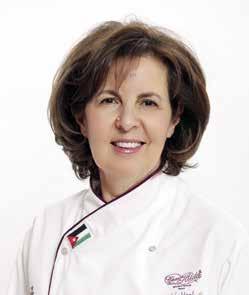
HILDA HANNA ISSA AL MASRIEH
CEO and owner of Chez Hilda Patisserie chezhilda.com
hildahosh; chezhilda
Changing preferences and demands
The chocolate industry’s remarkable transformation can be attributed to several factors, including shifts in consumer tastes, advancements in technology and a growing emphasis on quality and sustainability. One of the key drivers is the changing preferences of consumers. With growing awareness about health and wellness, there has been a rise in demand for premium and artisanal chocolates made from high-quality ingredients. Consumers are also increasingly concerned about the environmental and social impact of chocolate production, leading to greater transparency and accountability throughout the supply chain. This has resulted in initiatives aimed at promoting fair trade practices, reducing carbon emissions and supporting cocoa farmers in developing countries.
High quality ingredients
The shift toward mindful and healthy indulgence in the chocolate industry represents a positive step toward creating a more holistic and responsible food ecosystem. This movement reflects a growing awareness about the importance of balancing enjoyment with well-being, as well as the broader societal and
chocolate. It’s important not to fall into the trap of ‘healthy chocolate’ labeling from manufacturers. I encourage people to savor authentic flavors in moderation rather than in quantity.
Sensory journeys
I find inspiration everywhere in the world around me. Everyday experiences can trigger a sensation that inspires new flavors, from the sight of a young child to the kiss of a loved one. If I wake up in the middle of the night with an idea, I immediately make a note of it and, come morning, go to my lab and turn that flash of inspiration into reality. A good chef can always taste a mixture of ingredients in the head before they reach the palate of the mouth. Our portfolio features hundreds of chocolates, each with a distinctive flavor. From decadent truffles to delicate bonbons, they all tell a story of meticulous craftsmanship and culinary ingenuity, inviting exploration of their depth and complexity.
environmental impacts of food production and consumption. By choosing highquality ingredients, such as organic cocoa beans and natural sweeteners, chocolate producers can create products that taste delicious and also contribute to well-being. Incorporating functional ingredients like antioxidants and vitamins into chocolate formulations further enhances their nutritional value.
Jordanian inspiration
One of our creations, Jameed chocolate, represents an innovative fusion of traditional Jordanian cuisine with the world of confectionery. Inspired by the Jordanian dish Mansaf, Jameed chocolate combines savory and sweet elements in a single indulgent treat. The process of developing Jameed chocolate involves careful consideration of flavor profiles and ingredients to ensure a harmonious balance between the savory notes of Jameed (dried yogurt) and the sweetness of chocolate. By blending these contrasting flavors, our chocolate offers a unique and memorable taste experience that pays homage to Jordanian culinary traditions, while embracing creativity and experimentation.
MAY-JUL 2024 | HOSPITALITY NEWS ME 19
 ROAA SAUD SABER
ROAA SAUD SABER
CEO and master chocolatier at Feionkah Chocolate feionkah.com missfeionkah
Innovative flavors
Over the years, the chocolate industry has undergone a significant evolution. Changes include an increasing emphasis on the origin and quality of cacao, driven by a growing consumer awareness of ethical sourcing and sustainability practices. This shift has led to a surge in artisanal chocolate producers, particularly in Saudi Arabia, where the market for premium chocolates is rapidly expanding. Consumers are also seeking out unique flavor profiles and high-quality ingredients. As a result, artisanal chocolate makers are experimenting with innovative flavor combinations and sourcing cacao beans from diverse regions to create distinctive products.
Mindful indulgence
Today’s consumers are increasingly prioritizing health-conscious choices in their diets, prompting chocolate manufacturers to respond with innovative products that cater to these preferences. There is also a growing demand for chocolates with reduced sugar content, alternative sweeteners and the inclusion of functional ingredients, such as
 EVGENIYA SOKOLOVA Founder, chocolatier and general manager of Golden Gazelle Chocolate ggcqatar.com
EVGENIYA SOKOLOVA Founder, chocolatier and general manager of Golden Gazelle Chocolate ggcqatar.com
jsopatisserie

Quality ingredients and craftsmanship
Initially, chocolate was predominantly linked with sweetness. However, in recent times, there has been a shift toward accommodating diverse dietary preferences and health-conscious consumers. The industry now provides options such as sugar-free, gluten-free and dairy-free alternatives, catering to individuals with specific dietary requirements. There is also an emphasis on the health benefits of dark chocolate, renowned for its rich antioxidants and associated health perks. Additionally, we’ve seen a growing fascination with single-origin chocolates, showcasing their unique flavors and characteristics. This evolution mirrors a broader trend toward mindful consumption and an appreciation for quality ingredients and craftsmanship. As consumer awareness continues to grow, chocolate producers are adapting to meet the demand for healthier and more diverse options.
Prioritizing flavor
We believe that chocolate should be a feast for both the eyes and the taste buds, so we strive to create products that are
nuts, berries and spices, known for their health properties. This trend has led to the creation of a diverse range of healthier chocolate options that taste delicious and also offer various health benefits. Additionally, manufacturers are employing transparent labeling and marketing strategies to communicate the nutritional value of their products.
Food meets art
In my work, I begin by selecting the highest quality beans, then explore how various flavors can synergize with or elevate the chocolate. My creations include a line of chocolates infused with local flavors and ingredients, such as Saudi dates, mint and Arabic coffee. This unique blend offers a taste of the region’s rich culinary heritage, while showcasing chocolate’s versatility. I have also ventured into sculptural chocolates, creating edible art pieces. These sculptural creations engage the senses, blurring the lines between food and art, helping me in my aim to elevate chocolate to a cultural experience that celebrates the diversity and creativity of the culinary world.
both delicious and Instagram-worthy. Our attention to detail begins with the finishing touches of each chocolate creation, paying close attention to presentation, texture and color. However, flavor is always our top priority. We use only the finest ingredients and innovative flavor combinations to create chocolates.
Nutritious and delicious
Today, consumers are increasingly conscious of what they eat and seek products that not only satisfy their tastebuds but also contribute to their overall well-being. Consequently, there’s a significant demand for products that offer both taste and well-being benefits. One of our innovations is our Healthy Gym Chocolate, a special blend of dry fruits and nuts, covered in chocolate. Developed in collaboration with gym coaches and nutritionists, this product is designed to be a delicious treat that also supports overall health and well-being. Packed with essential nutrients, vitamins and antioxidants, our Healthy Gym Chocolate provides a nutritious energy boost to fuel workouts and keep consumers feeling their best.
INFLUENCERS BUSINESS
HOSPITALITY NEWS ME | MAY-JUL 2024 20

FACT NO. 1: 100% OF OUR COCOA COMES FROM A PARTNERSHIP WITH AN AVERAGE TERM OF MORE THAN 8 YEARS. Why is that game-changing? Because these long-term commitments, agreed on a case-by-case basis with each of our partners, give cocoa producers security by guaranteeing fixed prices, minimum purchase quantities or even zero-interest advance funding. These conditions enable them to look to the future with confidence and benefit from a stable income, which is not commonplace in our industry. FOR THE SECOND TIME
we e B
C p
QATAR SEALS ITS GLOBAL TRAVEL DESTINATION STATUS
RECORD-BREAKING VISITOR NUMBERS WELCOMED IN 2023
Qatar is fast emerging as one of the most exciting global travel destinations, featuring a mix of rich Arabian tradition and heritage that has delighted guests around the globe for decades. In 2023, the country crossed the 4-million visitor mark, exceeding annual arrival numbers for the past five years. During the first quarter of 2024, Qatar welcomed nearly 1.7 million visitors, with January alone witnessing a remarkable influx of 700,000 visitors, setting a new record for single-month arrivals. Among these visitors, 44 percent hailed from the GCC region, with Saudi Arabia comprising the largest share at 28 percent, followed by Bahrain, Oman, Kuwait and the UAE.
Key role for tourism
These impressive numbers come with the State of Qatar having recently launched its Third National Development Strategy 20242030. The strategy outlines the plan for the next phase of Qatar’s development journey toward realizing Qatar National Vision 2030. It identifies the tourism sector as a major

sector within the economic diversification clusters earmarked to contribute to achieving sustainable economic growth. In line with Qatar National Vision 2030, Visit Qatar’s efforts are focused on enhancing the country’s tourism infrastructure, promoting sustainable development and fostering cultural exchange.
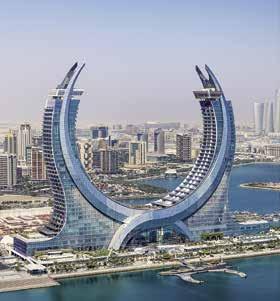
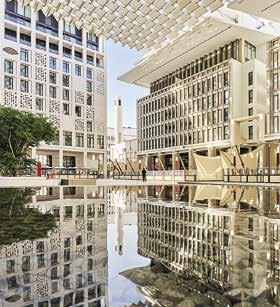
Visitor-friendly processes
Qatar’s growth is also due to its awardwinning national carrier, which connects Doha to more than 177 key business and leisure destinations across six continents. Qatar Airways has won Skytrax’s Airline of the Year title numerous times and boasts unmatched service and network coverage,


22 HOSPITALITY NEWS ME | MAY-JUL 2024
making it the airline of choice for today’s business travelers. Hamad International Airport has also been voted as the World’s Best Airport at the Skytrax World Airport Awards, winning the title for a third time. In addition, Qatar is recognized as the most open country in the Middle East and the eighth most open in the world in terms of visa facilitation, with citizens from 102 countries granted visas on arrival. The digital ecosystem for travelers has also been enhanced. The country continues to work on Qatar’s National Tourism Strategy 2030, aiming to make it one of the fastestgrowing tourist destinations in the region. The goal is to increase the tourism sector’s contribution to GDP by 12 percent by 2030 and to increase domestic tourism spending three or fourfold, aligning with Qatar’s National Vision 2030.
Two countries, single trips
Visit Qatar and the Saudi Tourism Authority have joined forces to launch an exciting new campaign, titled Double the Discovery. This collaborative effort aims to also promote tourism in neighboring GCC countries, offering residents and international visitors the chance to explore the rich cultural and historical wonders of Qatar and Saudi Arabia in a single trip. As part of the campaign, tourists will be provided with extensive city guides, offering
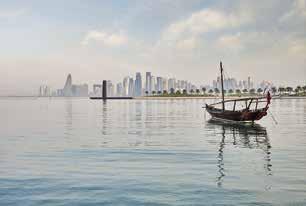

relevant and detailed information about the top attractions, things to do, shopping venues and restaurants in both Qatar and Saudi Arabia. These guides aim to assist travelers in making the most of their visit and experiencing the best each country has to offer. Visit Qatar is also working with government entities for stopover packages for visitors, which include 24-hour check-in facilities, enabling guests to make the most of their time in Qatar, and which can be tailored to accommodate add-on options, including airport assistance, transfers and a range of tours and experiences, enhancing their stay.
A successful cruise season
Qatar is a premium cruise destination, with a host of world-class cruise ships visiting the country. It is home to a new Grand Cruise Terminal, located in the center of the capital, which offers unparalleled connectivity to the city’s most prominent tourist attractions. These include the Corniche, the Museum of Islamic Art, National Museum of Qatar and Msheireb Downtown, as well as the traditional standing market, or Souq Waqif. The 2023/24 cruise season got underway in October 2023 and ended in April 2024. Doha Port hosted 73 cruises with 347,000 passengers. Cruise ships such as Norwegian Dawn and Star Legend made


their debut in Qatar this season, with both ships operating as full homeporting vessels embarking from Doha. In January 2024 alone, Doha Port welcomed 19 cruise visits. The total number of cruise visitors reached 199, 863 over the season. The next cruise season 2024/25 will begin in October 2024.
Exciting new attractions
Several new attractions were launched in 2024, including Our Habitas Ras Abrouq, an award-winning and sustainable resort, located at the edge of the UNESCOprotected Al-Reem Biosphere Reserve, making it ideal for a relaxing stay. The partnership between Our Habitas and Qatar Airways allows luxury travelers seeking new experiences to discover the natural wonders of Qatar. Visit Qatar will also closely collaborate with Our Habitas to deliver transformative travel experiences through art exhibits, unique pop-up dining experiences, film screenings, concerts and more. Meryal Waterpark is another newly opened Qatar attraction. The park is located on the recently developed Qetaifan Island in Lusail and is home to the 85-meter high Icon Tower, which offers visitors an abundance of exciting attractions, including 36 waterslides. visitqatar.com



Advertorial 23 MAY-JUL 2024 | HOSPITALITY NEWS ME
THE UAE:
POSITIVE INDICATORS AND PLENTY MORE IN THE PIPELINE

Since the 1990s, the UAE’s economy has been on a constant rate of ascent and is now leading the region, along with Saudi Arabia. With an estimated GDP of around USD 509.2 billion in 2023, up from USD 507.6 billion in the previous year, the UAE now represents nearly 14.9 percent of the Arab GDP, according to the Arab League’s Inter-Arab Investment Guarantee Corporation (IAIGC). And this year the rating agency S&P expects the country’s GDP to expand by over 5 percent, with strong growth in the non-oil sector. From Abu Dhabi Economic Vision 2030 to Dubai Industrial Strategy 2030, the UAE has launched a series of plans to diversify its economies. Authorities are also
When it comes to regional high achievers, the Emirates undoubtedly rank high on the list. Years spent developing the tourism offering and other non-oil sectors of the economy are now paying off, and there’s more on the horizon, as Nada Alameddine, managing partner at Hodema Consulting Services, explains.

integrating new technologies via the Dubai Economic Agenda D33 and the UAE’s Net Zero 2050 strategy. While oil remains the cornerstone of the economy, diversification efforts are starting to pay off. The Emirates have successfully built strong hospitality, wholesale and retail, and financial services sectors in recent years.
Financial stability
Dubai and Abu Dhabi’s stable banking sectors have also managed to shield them from the global economic headwinds, as interest rates and inflation have been kept under control and new monetary policies put in place. Banks reported exceptional profits in 2023, and S&P Global highlights
their substantial liquidity reserves. While the European estate market was significantly affected by higher interest rates and stricter mortgage policies, the number of transactions has gone up in the Emirates, since most deals still take place in cash. Meanwhile, the country has witnessed a growing number of Russian buyers, who became the largest investor groups in Dubai last year. The city has been attracting investors for years and remains the economic powerhouse of the UAE.
Ras Al Khaimah, the fourth-largest emirate in the UAE, has a different profile from its powerful neighbors; while it does not produce oil or gas, it has a strong mining
MARKET UPDATE BUSINESS
24 HOSPITALITY NEWS ME | MAY-JUL 2024
industry. The boost in new construction projects in the region, and also those in India and Bangladesh, is bolstering the sector. Stevin Rock, one of the largest limestone quarrying groups in the world, is owned by the RAK government.
A roaring tiger
One of the pillars of the UAE diversification strategy is tourism. Over the past decade, the UAE has established itself as a popular holiday destination, ideally located halfway between Eastern and Western countries. In 2023, Dubai even hit a new record, attracting 17.15 million international overnight visitors, marking impressive year-on-year growth of 19.4 percent. With its large hotel offering and popular leisure, sporting and business events, the Gulf Tiger draws thousands of travelers all year round. Its success story was acknowledged by the industry itself at the Tripadvisor Travelers’ Choice Awards 2024, where it was selected as the No.1 Global Destination for the third year in a row. Dubai, however, isn’t resting on its laurels. Next, the emirate wants to go greener. The Dubai 2040 Urban Master Plan is set to change the city’s face, with 60 percent earmarked to become nature reserves. The Dubai Master Plan for Public Beaches is another ambitious scheme, this time aimed at increasing the length of public beaches by 400 percent by 2040. And last July, authorities launched Dubai Sustainable Tourism, a stamp to rate hotels according to sustainability standards. Under the Urban Master Plan, the space dedicated to hotels and tourist activities will also increase by over 100 percent.
Broad-based tourism drive
Abu Dhabi's tourism project permits surged by more than 20 percent last year, with investors benefiting from high oil prices. The emirate also signed new deals with international travel brands to meet its 2023
24-million visitor target. But the most notable change comes from Ras Al Khaimah. Traditionally in the shadow of its glitzy neighbors, the smaller emirate is looking to up its tourism game and reach five million visitors by 2030. Last year, it struck a deal with Las Vegas-based Wynn Resorts for a USD 3.9 billion beach-integrated complex which would include a casino. The mega resort is expected to open in 2027. Another 19 hotels, with 5,867 rooms, are also in the pipeline, representing a 70 percent increase on the current supply. The hospitality sector currently represents 4 percent of Ras Al Khaimah’s GDP, but new projects in the works are expected to increase this contribution. The small emirate of Ajman has also launched a charm offensive toward foreign visitors. It recently organized a roadshow in the UK to attract British tourists.
A packed calendar
The UAE member states have now become highly experienced hosts for international conferences, festivals and events. Thousands are expected to attend a diverse range of events scheduled for this year, including: UAE Innovates 2024; the WTO’s 13th Ministerial Conference; the UNESCO World Conference on Culture and Arts Education; the Abu Dhabi Grand Prix; the Dubai Shopping Festival; the Polo Gold Cup; Taste of Dubai; and Art Dubai, to name just a few. Other initiatives include the extension of Yas Island’s water park to add 18 new rides
Over the past decade, the UAE has established itself as a popular holiday destination, ideally located halfway between Eastern and Western countries.


and attractions in 2025, and the recent collaboration between Dubai and the Real Madrid football club. Dubai Parks and Resorts will host the first Real Madridthemed Park, named Real Madrid World.
To transport all these visitors to the UAE, the country is moving to strengthen its transportation offer. Flydubai recently launched four new services to expand its European network to 43 destinations. Emirates Airline has also introduced a pre-approved 14-day single-entry visa on arrival for Indian travelers. Yacht and cruise tourism is another UAE specialty. Dozens of marinas and hundreds of support facilities for pleasure boats, super yachts and even giga yachts are available across the country.
Positive indicators
Meanwhile, efforts are underway across the hospitality industry to keep pace with the constant increase in visitor numbers. Dubai’s occupancy rate attained a 77.4 percent peak last year, with the number of room keys reaching 150,000. All other indicators, such as ADR and RevPAR, surpassed pre-pandemic levels and reached record highs. Other emirates witnessed the same trend, although not to the same extent.
Restaurants are also doing well. The thriving gastronomy scenes of Dubai and Abu Dhabi offer a wide range of cuisines and concepts, and new outlets are opening every day. The Michelin Guide published its second edition on Dubai in 2023, alongside the UAE Gault & Millau, celebrating UAE-based restaurateurs. On the fast-food scene, we are witnessing the rise of homegrown outlets, such as Pickl, BonBird and Drip Burgers. hodema.net
In collaboration with
25 MAY-JUL 2024 | HOSPITALITY NEWS ME
HOW TO HARNESS THE POWER OF THE METAVERSE

In a world where the boundaries between reality and the digital realm blur, the metaverse emerges as a powerful force, reshaping how we experience travel and tourism. Planning a vacation will be seamless. Selecting destinations, booking accommodations and choosing activities will be guided by decentralized platforms offering authentic, up-to-date information. Through digital twin technology, travelers will immerse themselves in the culture and attractions of destinations.
A new era for travel and tourism
In 2023, Stelios A.K. Ioannidis and Dr. Kontis Alexios-Patapios described how the metaverse can benefit tourism. For the tourist, it will impact: the way they select their vacation destination; book accommodation; select which activities to participate in; the way they check-in/checkout in airports and hotels; and the way they retain anonymity in all their interactions with tourism providers. It will also change communication as meta-word-of-mouth (m-WoM) becomes a way to share real-time information with other tourists.
For destinations, disintermediation will transform the landscape, enabling direct interactions between tourists and service providers. Remote, yet in-person interactions blur geographical boundaries, offering personalized experiences regardless of distance. Tourism destinations will leverage new marketing channels and brand engagement strategies to captivate audiences and remain relevant in a competitive landscape. In this dynamic interplay between demand and supply,
The metaverse and Web3 are poised to revolutionize the hospitality industry, transporting us into a world of personalized, decentralized experiences and limitless possibilities, as Dr. Jane Thomason, emeritus chair of the World Metaverse Council, author and influencer, explains.

tourists embark on journeys of discovery. At the same time, tourism destinations evolve to meet their ever-changing needs.
Boosting brand engagement
Metaverse technology, with its digital twin capabilities, enables creating and enhancing communities, fostering destination awareness and coordination. Virtual visits allow consumers to immerse themselves in the culture and attractions of a place, inspiring authentic travel experiences.
Existing Web2 travel networks like Marriott Bonvoy, Hilton Honors and World of Hyatt, with millions of members, stand to leverage the potential of Web3 and the metaverse. Platforms such as Booking.com, Airbnb and TripAdvisor also hold promise, with their large user bases, decentralized models and community engagement features. Web3 technology facilitates the creation of decentralized communities, providing gated spaces for like-minded individuals to connect and forge deeper relationships. Influencers who successfully navigate this landscape can cultivate trust and provide meaningful utility to their followers, fostering a more intimate and engaged network.
Brand engagement will drive enthusiasm and loyalty, through meta-events, gamification, token rewards and NFT avatar accessories. Web3 and the metaverse disrupt the current centralized model in tourism, offering decentralized and personalized options. The tokenization of assets like hotels will empower fractional ownership, enhancing liquidity and engagement.
Avatar-to-avatar advantages
The use of avatars in the metaverse has the potential to transform how tourists interact with each other and tourism providers. With avatar-to-avatar communication, tourists can directly engage with hotel staff to address issues or make requests, reducing reliance on online reviews and ratings. Marriott is exploring blockchain technology to enhance security and efficiency in travel with the Known Traveler Digital Identification program. In hospitality and tourism management, the metaverse offers innovative applications, such as NFT-based booking systems, virtual tours and digital twins of destinations. These advancements reshape how travelers book, explore and experience destinations, while also promoting sustainability and enhancing the overall visitor experience through real-time data optimization and predictive maintenance of tourist facilities.
Metaverse
use cases
Real-world use cases of metaverse in travel and tourism include:
• Pre-travel exploration: metaverse supports digital twins and immersive interfaces for consumers to explore travel alternatives before embarking on their journey.
• Virtual tours of real-world destinations: Decentraland offers virtual tours of realworld destinations, such as museums and historical sites, allowing visitors to explore and interact with exhibits.
• Metaverse operations at airports: SITA predicts that by 2030, metaverse operations will be commonplace at leading airports,
TRENDS BUSINESS
26 HOSPITALITY NEWS ME | MAY-JUL 2024
optimizing processes, facilitating intuitive control and providing immersive training experiences for staff.
• Revenue-generating opportunities: metaverse activations, AI and NFT collections offer revenue-generating opportunities in the travel sector by attracting a younger demographic, enabling global sales of properties, transforming marketing and customer service, and revolutionizing membership systems through token-based memberships.
• Luxury brand engagement: luxury brands are entering the NFT space with limited-edition collections. Hotels like Le Bristol in Paris have launched their own NFT programs.
• Token-gated experiences and loyalty programs: private clubs, such as the Drunken Monkeys Members Club in London, and loyalty programs create token-gated experiences and perks, offering lifetime access to luxury concierge services through NFT-based memberships.
• Fractional ownership and governance: CitizenM is pioneering decentralized autonomous organizations (DAOs) for fractional hotel ownership and communitydriven governance through its ‘We Are CitizenM’ project, allowing token holders to participate in hotel design and guest offerings’ decision-making.
• Web3 tourism ecosystem: Shanghai aims to generate revenue by establishing a comprehensive Web3 tourism ecosystem, including digitizing cultural artifacts and loyalty programs, and providing secure travel services while promoting sustainable tourism practices and safeguarding cultural heritage through metaverse projects. China has a broader initiative to attract tech-savvy travelers to curated and personalized travel experiences using Web3 technologies.
Industry trailblazers
• Norwegian Cruise Line has joined the NFT game by launching its own NCL NFT marketplace, offering travelers and loyal NCL customers the opportunity to own a piece of its newest vessels, Norwegian Prima and Norwegian Viva. Claiming to be the first in the cruise industry to enter the NFT marketplace, Norwegian Cruise Line collaborated with Italian artist Manuel Di Rita, who designed the hull art on both ships.
• Disney, renowned internationally for its leadership in tourism and hospitality, boasts an extensive portfolio of physical parks and virtual entertainment content worldwide. Complementing its physical parks, Disney’s virtual game, Play Disney Parks, utilizes augmented reality (AR) technology to engage visitors. By completing tasks with
Tourism destinations will leverage new marketing channels and brand engagement strategies to captivate audiences and remain relevant in a competitive landscape.

family and friends based on Bluetooth beacon settings and the phone camera, players can activate hidden AR elements around them. While waiting in line for rides, visitors waiting to board a spaceship ride may see the rocket ‘flying’ overhead through the game, for example.
• Singapore-based start-up Vizzio has crafted a 1:1 replica of Gardens by the Bay for an event in under three days. Utilizing AI and a patent-protected algorithm, Vizzio’s models were generated from satellite imagery to create normalized digital surface models. This innovative approach enables Vizzio to stream events over the network to any browser without requiring app installation, showcasing the exciting enterprise applications of metaverses.
The metaverse, with its immersive virtual experiences, virtual tours and advanced features, promises to revolutionize the hospitality industry, offering personalized and decentralized experiences that strengthen business processes and engage customers uniquely. Travel and tourism will be redefined for a new era in which the possibilities are limitless.
27 MAY-JUL 2024 | HOSPITALITY NEWS ME
CROSS-CULINARY EXCHANGE:
GASTRONOMY GOES GLOBAL

The culinary world has witnessed a dynamic shift in recent years, resulting in an ever-increasing contrast between traditional cuisine and global trends. International culinary influences are producing a growing taste for fusion cuisine, which is helping to create a fascinating contemporary F&B landscape, marked by the coexistence of old, new and plenty of innovation in between.
Something old: traditional cuisine
Links to the past
Traditional cuisine is deeply rooted in the cultural and historical aspects of a specific region or community. A prime example is Italy’s rich culinary heritage, where the true essence of our all-time favorites, such as pasta, pizza and risotto, lie in the regional variations that showcase the diversity of Italian culture.
Traditional cuisine serves as a link to the past, evoking a sense of nostalgia and reflecting a location’s heritage, traditions and customs. Significantly, it is often associated with specific rituals, ceremonies and celebrations, especially in the Middle East, where certain dishes may be reserved for special occasions and religious events.
From firm favorites to fantastic fusion dishes, the ‘something old, something new’ mantra is taking kitchens by storm, as chefs switch up traditional recipes and play with flavors from across the globe. Chirine Salha, board member of the Syndicate of Owners of Restaurants, Cafes, Night-clubs & Pastries in Lebanon, unpacks the culinary trends that are traveling through time and across borders.
All about authenticity
The use of locally sourced and seasonal ingredients is a hallmark of authentic cuisine. This not only adds unique flavors, but also reflects the availability of resources in a particular area, highlighting its unique culinary identity.
Traditional cuisines will be aligned with the local climate and resourcing challenges. Regional variations can be found within the traditional cuisine of a country or culture. Different areas may have unique ingredients, spices or cooking styles that contribute to the diversity of the overall culinary tradition.
A strong social side
Authentic dishes often make use of traditional cooking techniques that have been preserved and passed down through generations within families or communities. This can include specific ways of preparing, cooking, storing and presenting food. There is a strong social aspect to authentic cuisine, often involving communal cooking and shared meals, which reinforces a sense of comfort and familiarity. In addition, traditional culinary experiences have become a key draw for tourists seeking authenticity during their trips, which has led to a renewed interest in preserving and showcasing local cuisines.
Something new: global/fusion cuisine
Integrating flavors
In contrast, global cuisine stands out as an ever-evolving phenomenon. An increasingly interconnected world has led to culinary boundaries blurring, giving rise to what we commonly refer to as fusion dishes and the integration of diverse flavors. These trends bring a sense of excitement and innovation to the food world. They reshape the way chefs and food enthusiasts approach cooking and dining, sparking new levels of creativity and experimentation, and the blending of numerous culinary traditions.
Cross-cultural cooking exchanges
Cooking has become a celebration of diversity, reflecting the global exchange of ingredients, cooking techniques and culinary traditions. One example is the popular dish sushi burrito, which is a fusion of Japanese and Mexican cuisines, marrying the delicate art of sushi with the bold flavors of Mexican ingredients. Recipes are travelling across borders, galvanized by this increase in cross-cultural exchanges.
F&B BUSINESS
HOSPITALITY NEWS ME | MAY-JUL 2024 28

A flavorful discovery
Global F&B trends are also being fueled by the changing tastes of consumers, who are increasingly keen to explore and experiment with food from around the world, while simultaneously revealing an appreciation of different cuisines and diverse flavors. As the number of people traveling farther afield continues to rise, so, too, does the trend for challenging the traditional notions of taste, encouraging chefs to push boundaries and innovate. Cross-cultural living and the coexistence of diverse communities in cosmopolitan cities has seen chefs draw inspiration and creativity from their immediate surroundings, resulting in fusion cuisine that reflects the multicultural fabric of the melting pots that define their communities.
Another notable trend is the demand among travelers for unique experiences, whether in their hotel stays or when dining, which also offers chefs plenty of opportunities to experiment with unconventional flavors and culinary techniques. In addition, we are seeing collaborative ventures between chefs from diverse culinary backgrounds, which is fostering new levels of creativity, resulting in ever-evolving fusion dishes that benefit from a blend of expertise
From molecular gastronomy to hightech cooking methods, cutting edge innovation is enabling chefs to push the boundaries of fusion cuisine.
Industry leaders are also adapting both traditional and fusion cuisine to accommodate evolving consumer preferences for health-conscious options. An increased focus on health and wellness has led to rising interest in plant-based diets, organic ingredients and healthier versions of classical dishes. Chefs have also become mindful of sourcing ingredients responsibly and reducing food waste, resulting in more sustainable practices.
Social media, culinary shows, blogs and digital platforms, such as YouTube, have helped to heighten the hype around diverse cuisines and culinary trends, and make them more popular. These powerful mediums have provided an incentive for chefs to increase the visibility of fusion cuisine by sharing aesthetically pleasing culinary innovations. In turn, inspired food bloggers are only too keen to replicate these dishes and contribute to a culture of digitally interconnected culinary exploration.
Balancing old and new
Traditional and global cuisines are two sides of the same coin, each offering a distinct perspective on the culinary world. Traditional cuisine serves as a testament to the deep roots and cultural identity of a location, while global cuisine reflects the dynamic nature of our interconnected world. As societies evolve and interact, culinary traditions inevitably also adapt and change to reshape the gastronomic landscape. Creating genuinely new fusion dishes is far from challenge free, however. Balancing different culinary elements to produce a harmonious and palatable dish in which the integrity of the ingredients is retained requires skill and an in-depth understanding of the diverse flavors involved.
Chefs and restaurants have a responsibility to ensure that they retain the traditional flavors that are culturally significant and make each cuisine special, when innovating in the kitchen. Finding a balance in the kitchen between tradition and culinary creativity is key. In this way, diners are able to appreciate the array of global cuisines available, while the culinary heritage of locations and destinations remains deservedly protected,

MAY-JUL 2024 | HOSPITALITY NEWS ME 29
In collaboration with
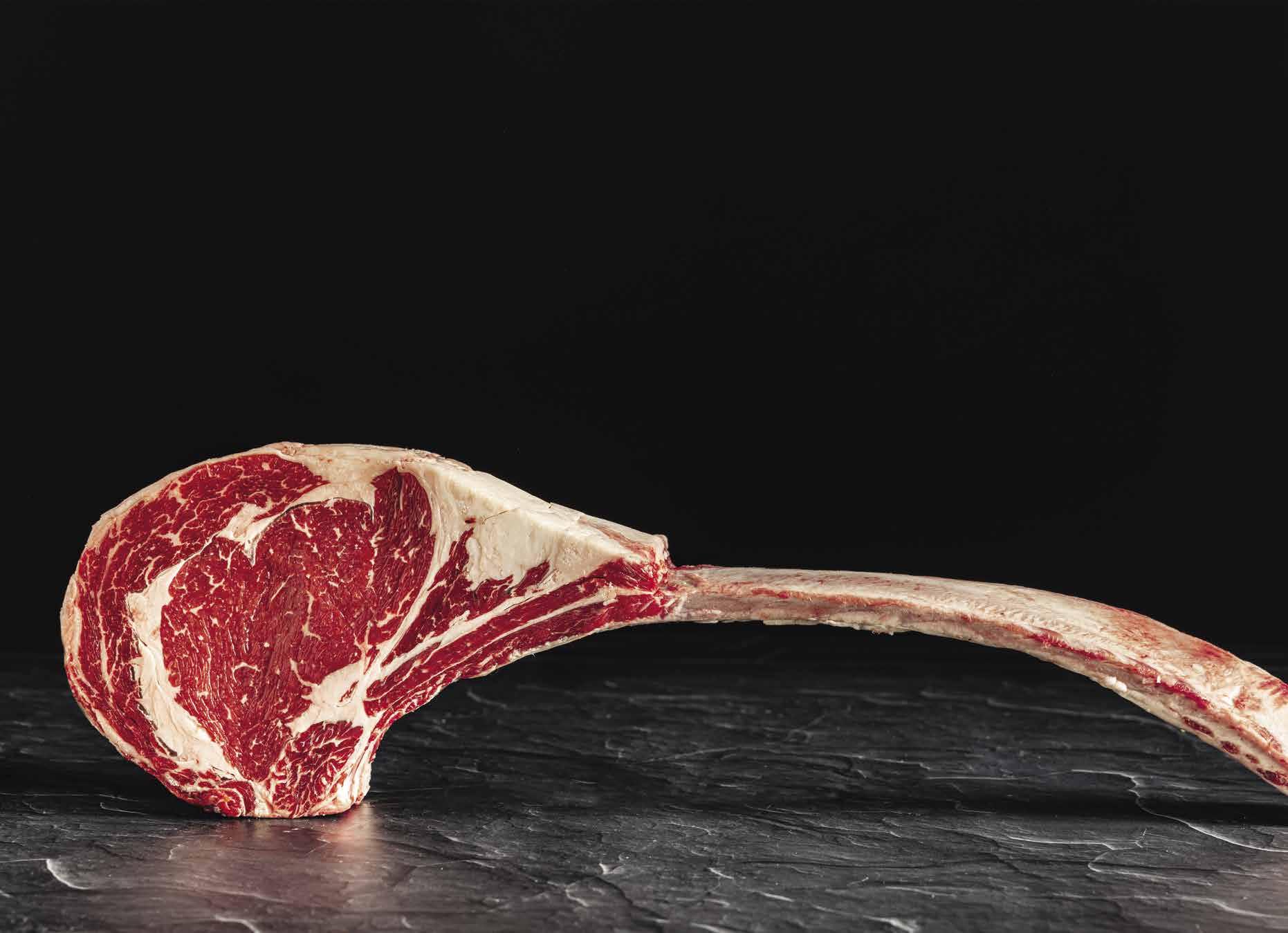
Contact your sales representative today.

Bahrain: Fine Foods
Egypt: AM Foods
Jordan: Frozen Food House Co.
Kaylani Food Center
Kuwait: Alyasra Foods
Azzad Trading Group
Legion
United Supply Food Services
Lebanon: Societe Jabra
Morocco:
Stellar International Enterprises
Oman:
Chef Middle East Oman
Qatar: Chef Middle East Qatar
Deliopolis
Qatar National Import & Export Co
Saudi Arabia:
Arabian Food Corporation
Gulfwest Company Riyadh
Gulfwest Company Jeddah
UAE: Aramtec
Chef Middle East Abu Dhabi
Chef Middle East Dubai
Faisal Al Nusif Trading Company
Rastelli Global Middle East
Transmed Overseas Incorporated


Contact us now Scan to see the best beef
A SOUTHEAST ASIAN SYMPHONY OF FLAVORS

Thai cuisine differs from other varieties for several reasons, ranging from its complex flavor profile to the use of fresh ingredients. Its distinctive and harmonious blend of perfectly balanced sweet, sour, salty and spicy flavors create a symphony of tastes in every dish.
Fresh and flavorsome
The famous Tom Yum soup is a perfect representation of the complexity of Thai cuisine. Sour and spicy, it also has a hint of sweetness from the lemongrass and a salty umami flavor from the fish sauce. The combination of these flavors creates a unique, unforgettable taste.
Thai cuisine relies heavily on fresh ingredients that are readily available in local markets. The use of fresh herbs and spices is what gives Thai food its vibrant, bold flavors. These ingredients are usually chopped, grated or pounded to release their natural oils and flavors. Thai basil, lemongrass and galangal are commonly used in many Thai dishes, adding a unique flavor and aroma. The use of fresh ingredients ensures that flavors are intense and the dishes nutritious.
Importantly, Thai cuisine is all about balance. Each dish is carefully crafted to ensure that no single flavor is overwhelming.
With its beautifully balanced blend of sweet, sour, salty and spicy flavors, it’s no wonder that Thai cuisine is so popular among foodies worldwide. Drawing on both his professional expertise and familial roots, Bon Cheang, head chef at The Thai Kitchen at Park Hyatt Dubai, takes us on a fascinating culinary journey into a world of flavor complexities and combinations.

With nothing being coursed, people are encouraged to sample many dishes at once. Food is typically shared and almost always eaten with rice. Due largely to their Buddhist influence, people are eager to share food with other community members, as well as give offerings to the monks daily.
Regional differences
Northern Thailand: the cuisine here is predominantly hot and salty, though more moderate on both counts than food found in other regions. Temperatures tend not to reach the levels needed for coconuts to thrive, so dishes are usually moistened with water or broth rather than coconut milk. Heavy forestation means that fuel for cooking is in abundant supply, making grilling popular, alongside long-cooking and braising. The forest also provides several bitter herbs, lending the cuisine a slightly astringent profile. Pork is popular as a meat, with pork fat also commonly used for frying.
Northeastern Thailand: in contrast, this part of the country has struggled with farming and the effects of deforestation, with the cuisine having adapted to reflect this. The dishes from what is Thailand’s poorest region tend to be extremely hot and pungent, meaning smaller amounts can be used to flavor accompanying rice.
Grilling and boiling are the predominant methods of cooking, with soups made of preserved fish also common.
Southern Thailand: this region’s proximity to the Gulf of Thailand sees seafood playing a huge role in its cuisine, from prawns, crabs and oysters to squid and mackerel. Whatever can’t be eaten immediately is dried in the hot sun. The shrimp paste produced by this method, for example, is the cornerstone of most Southern relishes. Food from this part of Thailand is the spiciest. The flavor profile is primarily hot, sour and salty, while coconut oil and milk are used heavily in curries, as are fresh herbs and fish.
Central Thailand: these dishes are probably the most familiar to Westerners, as most American Thai restaurants serve primarily Central-Thailand-style food. These include the red, green and massaman curries so popular in international Thai restaurants. Proximity to Bangkok allows for a diverse array of available produce, most of which is cultivated. Flavors tend to be highly complex and layered, with the dominating flavors being hot and salty. The primary meats are chicken, duck and pork, with prawns and freshwater fish also readily available. Limes provide sour contrast to curries and brothy soups.
EYE ON THAILAND BUSINESS
32 HOSPITALITY NEWS ME | MAY-JUL 2024
From veg to meat
Vegetables are an essential component of Thai cuisine, whether served raw, stir fried, pickled or fermented. Raw vegetables are usually served alongside highly seasoned meats, salads and dips, creating a wonderful contrast. Typically eaten at the end of a meal, and often throughout the day, fresh tropical fruits are also regarded as highly important and revered in Thai culture. They are also used in drinks, sorbets and savory dishes.
Meat, meanwhile, is usually chopped into smaller pieces and grilled or stewed, or, through Chinese influence, stir fried or deep fried. Chilies, brought by the Portuguese from South America, have essentially replaced green peppercorn as a means of heat. Lack of refrigeration long ago led to the pickling, brining and fermenting of a vast array of meats and vegetables in the name of preservation. Many of these techniques and ingredients remain essentially unchanged to this day.

Thai cuisine is all about balance. Each dish is carefully crafted to ensure that no single flavor is overwhelming.
Diverse cooking methods
Thai cuisine is known for its unique and diverse cooking techniques. The use of different cooking methods, such as stir-frying, grilling, steaming and deepfrying, adds depth and complexity to the dishes. The cooking techniques also help to enhance the flavors and textures of the ingredients. For example, Thailand’s famous Papaya salad is a typical representation of the diverse cooking techniques used in Thai cuisine. Made by shredding green papaya and mixing it with a dressing created from lime juice, fish sauce and chili flakes, the salad is then pounded in a mortar and pestle to release the flavors and produce its renowned texture.
Thai cuisine – the journey
• Thai cuisine can be traced back centuries, rooted in the food of the indigenous peoples and inhabitants of neighboring countries.
• The country’s location along historic trade routes contributed to the exchange of culinary ideas and ingredients. Spices, herbs and cooking techniques from India and China, for example, have all left their mark.
• The royal court of Thailand played a significant role in shaping Thai cuisine.
Royal chefs developed and refined many of the intricate dishes and presentation styles associated with Thai cuisine today.
• Thai street food has a rich history and continues to be a beloved part of local culinary culture.
• Today, Thai cuisine enjoys international popularity, while globalization has led to many adaptations and fusion dishes.
• Thai cuisine is often perceived as healthy due to its focus on fresh ingredients and balance of flavors. Many Thai dishes feature herbs and spices with potential health benefits.
• Latest food trends include the influence of Japanese-inspired elements.
• Looking ahead, plant-based Thai cuisine is expected to grow in popularity, alongside molecular gastronomy.
@boonnit_dincheang
33 MAY-JUL 2024 | HOSPITALITY NEWS ME
NEW TECHNOLOGIES: TODAY'S ESSENTIAL TOOLS FOR HOTELIERS


Emerging technologies are revolutionizing the lodging industry, delivering significant benefits to both operators and guests. Michael Donald, co-founder of Halo Business Consulting, explains why embracing innovation and implementing smart ideas are musts for hotels looking to secure a successful future.
TECHNOLOGY BUSINESS
34 HOSPITALITY NEWS ME | MAY-JUL 2024


The hospitality industry continues to transform as new technologies emerge and guest expectations evolve. Hotels that want to stay ahead of the competition are embracing innovation and offering digital convenience to their guests. In the current scenario, understanding the key trends and challenges that are shaping the future of business lodging has never mattered more. Only by doing so can hotels leverage the emerging technologies that are essential for creating smarter and more efficient properties, and strengthen their position for the future.
Creating digital convenience
One of the main drivers of hotel technology adoption is the demand for digital convenience from business travelers. In a recent Skift survey of over 5,000 consumers, 73 percent of respondents said they would be more likely to stay at a hotel that offers selfservice technology, minimizing contact with employees and other guests. According to a report by Cloudbeds, 66 percent of hotel guests prefer digital check-in, which allows them to skip the front desk lines and submit their information ahead of time. Digital check-in also enables hotels to collect signatures electronically, create custom guest portals and offer keyless entry solutions. These features not only enhance the guest experience, but also streamline hotel operations and help to reduce labor costs.
One of the main drivers of hotel technology adoption is the demand for digital convenience from business travelers.
Conversational commerce
Another aspect of digital convenience is conversational commerce, which refers to the use of chatbots, SMS and voice assistants to communicate with guests and offer personalized recommendations. For example, hospitality venues can use artificial intelligence (AI) to automate common guest queries, such as requesting a late check-out, booking a spa appointment, booking a table in the restaurant or ordering room service. AI can also provide tailored suggestions for tours and activities based on a guest’s preferences and location. Conversational commerce can help hotels increase guest satisfaction, loyalty and revenue.
Emerging technologies unpacked Besides digital convenience, some of the key emerging technologies that are transforming the hospitality industry are explained below.
Internet of things (IoT): this refers to the network of connected devices that can collect and exchange data. IoT is ideal for helping hotels to create smart rooms that can adjust the temperature, lighting and entertainment systems, for example, according to the guest’s preferences. IoT can also enable hotels to monitor and optimize their energy consumption, maintenance and security.
Blockchain: this is a decentralized ledger that records transactions securely and transparently. Blockchain can help hotels improve their payment processing, identity verification, loyalty programs and data management. Blockchain can also facilitate peer-to-peer transactions between guests and hosts, such as in the case of home-sharing platforms.
Virtual reality (VR) and augmented reality (AR): these are immersive technologies that can create realistic simulations or enhance the real world with digital elements. VR and AR can help hotels provide virtual tours, interactive training, gamified experiences and destination marketing. VR and AR can also help guests explore new places, cultures and activities without leaving their rooms.
Mitigating the risks
While technology can bring many benefits to hotels, it also comes with some risks and challenges. One of the main risks is malfunction, which can disrupt the hotel operations and affect the guest experience. For example, if a digital check-in system fails or a smart room device malfunctions, it can cause frustration and inconvenience for both guests and employees. To prevent this, hotels need to ensure that their technology solutions are reliable, compatible and scalable. Hotels also need to have backup plans and contingency measures in case of technical issues.
Another risk is cybersecurity, which refers to the protection of data and systems from unauthorized access or attacks. Cybersecurity is crucial for hotels because they handle sensitive information from guests, such as personal details, payment information, travel plans and preferences. Cyberattacks can compromise this data and cause financial losses, legal liabilities, reputational damage and loss of trust. To avoid this, hotels need to adopt best practices for data security, such as encryption, authentication, firewalls, antivirus software and regular backups. Hotels also need to educate their employees and guests on how to prevent phishing scams, malware infections and identity theft.
Smarter properties, exceptional stays
Technology is changing the way hotels operate and interact with their guests. Hotels that wish to be successful in the future need to embrace innovation and offer digital convenience to their business travelers. However, hotels also need to be aware of the risks and challenges that come with technology adoption. By balancing these factors, hotels can create smarter properties that deliver exceptional guest experiences.
gohalo.co.uk
In collaboration with MAY-JUL 2024 | HOSPITALITY NEWS ME 35
TODAY'S BALANCING ACT : AUTOMATION VS. PERSONALIZATION

The hospitality industry stands on the brink of a transformative era, with Artificial Intelligence (AI) steering unprecedented changes. Today, both restaurants and hotels are expected to integrate AI technologies to enhance customer experience, streamline operations and offer personalized services.
Against this backdrop, there is much to be gained from exploring how key industry players are integrating AI-led initiatives across customer journey touchpoints. Doing so sets the scene for a timely, welcome analysis of the extent of AI’s integration and asking questions that certainly deserve thought. ‘Where exactly should we draw the line between innovation and overreach?’ is one and ‘How far is too far?’ another.
AI is increasingly proving to be an effective and disruptive force in both the dining and lodging segments, delivering results in several, far-reaching ways.
Dining scene disruptors
Automating customer interactions: fine dining restaurants are using AI for reservations and inquiries. This area holds plenty of promise; for example, upscale restaurants in major cities could employ AI chatbots on their websites to handle reservation requests and answer FAQs about dress codes or menu specifics.
Personalizing customer experiences: AI-driven systems are being utilized to
Hospitality industry players are increasingly integrating AI technologies into more of their processes, using cutting edge solutions to enhance the guest experience and maximize efficiency. But is there a point at which we risk entering the realm of innovation overreach? And how far is too far? Ralph Nader , CEO of Amber Consulting, balances the scales.

remember repeat guests’ preferences, such as favorite tables or dietary restrictions, to personalize the dining experience. Restaurants like those with a Michelin star or venues that are part of luxury hotel chains are well suited to be pioneers in this area.
Optimizing back-of-house operations: AI is also being used for inventory management and to predict ingredient needs based on reservation data. This facility is useful for helping to reduce waste and ensure the availability of seasonal and specialty dishes.
Improving staffing and scheduling: premier restaurants are moving to leverage AI to analyze booking patterns and optimize staff scheduling. This is helping to ensure that the guest-tostaff ratio is always ideal for providing personalized service without overstaffing.
Innovative kitchen appliances: these appliances offer smarter, more efficient cooking experiences. They can learn from your preferences to suggest recipes, adjust cooking times and temperatures for optimal results, and even order groceries when supplies are low. Smart fridges can track expiration dates and suggest meals based on what’s inside, while AI ovens can monitor the cooking process and make adjustments in real-time. This technology not only saves time and reduces waste, but also helps in achieving consistently perfect culinary results.
A step further
Today’s fine dining scene is witnessing the entrance of groundbreaking concepts like ‘The AI Cuisine’ from Tokyo, Japan. Bringing innovation and a fresh perspective to the industry, this pioneering platform uses AI to create unique recipes, offer detailed reviews of restaurants that incorporate AI and design dining environments and menus based on AI’s insights. Its goal is to make fine dining more personalized, innovative and aligned with modern trends and sustainability, thereby making high-end dining experiences more widely available.
Leveraging AI for lodging
Automated guest services: AI chatbots and virtual assistants are being widely adopted to handle guest inquiries and requests, offering 24/7 support without human intervention. Marriott International, for example, utilizes AIpowered chatbots on multiple platforms to communicate with guests, enhancing the customer service experience, from pre-arrival to post-departure.
Smart room features: hotels are implementing AI to offer personalized room environments. Hilton’s Connected Room platform allows guests to use their smartphones or devices to control room features like lighting, temperature and entertainment, tailoring their stay to their preferences.
TECHNOLOGY BUSINESS
HOSPITALITY NEWS ME | MAY-JUL 2024 36
Efficient check-in/out processes:
AI-enabled kiosks are streamlining the check-in and check-out processes, making them quicker and more efficient. Premier Inn has introduced automated self-check-in/out kiosks, significantly reducing the time guests spend at the front desk.
Dynamic pricing strategies: AI is revolutionizing how hotels manage revenue through dynamic pricing algorithms. These systems analyze data such as booking trends and market demand to adjust prices in real-time, optimizing occupancy and revenue. The Cosmopolitan of Las Vegas has utilized AI for pricing optimization, significantly increasing their profit margins.
Charting the future
As we integrate AI into the hospitality industry, a pressing question emerges: how far is too far? The balance between technological convenience and the human touch becomes crucial as we consider the long-term impact of AI on hospitality.
The risk of over-automation
While AI can streamline operations and offer personalized experiences, overreliance on technology risks alienating guests who value human interaction.
The personal touch - a warm greeting at check-in, a conversation about one’s stay during checkout - remains irreplaceable. For instance, while automated checkouts and AI-driven
feedback systems offer efficiency, they cannot replicate the genuine concern and immediate response of human interaction.
Customization vs. authenticity
AI’s ability to customize experiences is unmatched, but there’s a fine line between personalization and a lack of authenticity. Guests might enjoy tailored recommendations and services, yet the unique, unpredictable elements of travel and dining - often brought forth by human creativity and spontaneity - could be lost.
Risk of consumer fatigue
The novelty of AI in hospitality may wear off, leading to consumer fatigue, with guests eventually seeking more genuine, human-centric interactions. As technology evolves, what’s cutting edge today might also become obsolete tomorrow, requiring continuous updates and investments.
While AI can streamline operations and offer personalized experiences, over-reliance on technology risks alienating guests who value human interaction.
In collaboration with


A hybrid future?
Perhaps the future of hospitality lies in a hybrid model that leverages AI for efficiency and personalization, while preserving the essence of human interaction at critical touchpoints.
AI could handle repetitive tasks and data analysis, freeing up staff to focus on providing warmth, empathy and personalized care that technology cannot replicate.
Food for thought
• At which points during the customer journey is a human touch irreplaceable?
• How can we ensure that AI enhances, rather than detracts from, the authenticity of the guest experience?
• What strategies can be employed to keep AI in hospitality exciting and relevant for guests over time?
It’s worth remembering that there are moments in hospitality when a human touch is essentially irreplaceable, from the initial greeting at checkin, through personalized concierge recommendations to the empathetic handling of any special request, complaints or emergencies. In these scenarios, the nuanced and caring interactions offered by staff can significantly enhance the overall guest experience. There is a strong argument for suggesting that the solution lies in a delicate balance between automation and personal service, ensuring that AI serves as a tool to enrich the guest experience rather than diminish it.
amber-consulting.com
37 MAY-JUL 2024 | HOSPITALITY NEWS ME
THE AI TAKEOVER IN HOTEL ADVERTISING

The hospitality industry thrives on creating unforgettable guest experiences. Today, amidst ever-evolving customer expectations and a fiercely competitive landscape, hoteliers are constantly seeking innovative ways to stand out. Enter Artificial Intelligence (AI), a transformative technology rapidly reshaping the advertising landscape across industries.
Leveraging AI’s capabilities In the realm of hospitality, AI is no longer a futuristic concept, but a powerful tool poised to revolutionize the way hotels attract and engage guests. By leveraging AI’s capabilities for data analysis, personalization and automation, hoteliers can craft targeted advertising campaigns that resonate deeply with their ideal customers. Key ways AI can do this include:
Analyzing customer preferencesAI-driven analytics play a pivotal role in deciphering the intricate web of customer preferences. By analyzing vast datasets, hotels can gain profound insights into guest behavior, preferences and trends. AI algorithms can analyze online reviews, social media interactions and booking patterns to understand what guests value most, enabling hotels to tailor their advertising messages with precision. To give an example, one luxury hotel identified a growing trend among its guests for sustainable practices through AI
AI is poised to revolutionize how hotels market themselves, enabling operators to reach their ideal guests by creating personalized, targeted campaigns. Lovetto Nazareth , managing director of Prism, explains why industry players need to put this transformative technology front and center of their hotel advertising strategies.

analytics. In response, they crafted advertising campaigns highlighting their eco-friendly initiatives, resulting in a significant increase in bookings.
Driving personalized marketingpersonalization has become the hallmark of successful advertising and AI is the engine driving this customization revolution. According to a study by Salesforce, 84 percent of customers state that being treated like a person, not a number, is highly important as a means to winning their business. By leveraging machine-learning algorithms, hotels can create personalized advertisements that resonate with individual guests. From suggesting individualized travel itineraries to offering exclusive promotions based on past preferences, AI enhances the relevance of marketing messages.
Smart use of chatbots - in an era of instant communication, AI-powered chatbots are elevating customer engagement in advertising. Hotels can deploy chatbots on their websites or through messaging apps to provide realtime responses to customer inquiries, offer personalized recommendations and even facilitate the booking process. For example, one boutique hotel saw a 30-percent increase in direct bookings after implementing a chatbot on its website. The chatbot not only assisted with reservations but also provided local insights and travel tips.
Dynamic pricing optimization - AI algorithms excel in processing vast amounts of data to optimize pricing strategies dynamically. For hotels, this means the ability to adjust room rates based on demand, seasonality and various market factors in real-time. Implementing AI-driven dynamic pricing can lead to increased revenue and enhanced competitiveness. One report by McKinsey found that dynamic pricing can boost revenue by 2-5 percent, and in some cases, even up to 10 percent.
Facial recognition technology - in the realm of advertising, AI extends beyond online campaigns. Facial recognition technology, powered by AI, is transforming the check-in experience. Hotels can use facial recognition to expedite the check-in process, personalize guest interactions and enhance overall satisfaction. One chain of hotels that implemented facial recognition at check-in, reduced wait times by 50 percent, resulting in positive reviews that highlighted the seamless experience.
Predictive analytics - anticipating guests' needs and preferences is a hallmark of successful advertising. AI’s predictive analytics capabilities enable hotels to forecast future trends, allowing them to launch targeted campaigns ahead of the curve. According to a report by Adobe, companies using AI for predictive analytics are 2.9 times more likely to experience revenue growth at rates higher than the industry average.
TECHNOLOGY BUSINESS HOSPITALITY NEWS ME | MAY-JUL 2024 38


Beyond personalization
The benefits of AI in hotel advertising extend beyond personalization, with automation and efficiency high on the list of other advantages. AI can automate repetitive tasks involved in advertising campaigns, such as ad creation, content scheduling and budget allocation. This frees up valuable time and resources for hoteliers to focus on other aspects of their business.
Real-time optimization: AI enables continuous monitoring and optimization of advertising campaigns. Hotels can track performance metrics in realtime and adjust strategies based on data-driven insights, ensuring optimal campaign performance and maximizing advertising budgets.
Enhanced customer service: AI chatbots can provide 24/7 customer service to potential guests, answering queries, addressing concerns and assisting with bookings. This personalized approach improves the overall guest experience and builds trust with potential customers.
Implementing responsibly
While AI holds immense potential for impactful advertising, it’s crucial to remember that responsible implementation is key.
• Hotels must be transparent about how AI is used in advertising campaigns and ensure clear communication of data collection and usage practices.
• Upholding ethical marketing practices, avoiding discriminatory targeting or manipulative tactics that could damage brand reputation is also crucial.
• The need to respect guest privacy by adhering to data privacy regulations and ensuring secure storage and usage of guest data is another must.
Personalization has become the hallmark of successful advertising and AI is the engine driving this customization revolution.
Transformative opportunities
AI presents a transformative opportunity for the hospitality industry, particularly in the realm of hotel advertising. By embracing AI and implementing it responsibly, hotels can create targeted, personalized and data-driven advertising campaigns that resonate with their ideal guests. This approach can lead to increased engagement, higher conversion rates and a more sustainable and cost-effective approach to advertising in an ever-evolving hospitality landscape. As technology continues to develop, we can expect even more innovative and effective applications of AI to emerge, shaping the future of hotel advertising and the guest experience.
prism-me.com
In collaboration with 39 MAY-JUL 2024 | HOSPITALITY NEWS ME
ADAPTIVE REUSE: AN ARCHITECTURAL GAME-CHANGER

The hospitality industry has witnessed a remarkable shift toward adaptive reuse. Significantly, this practice, which involves repurposing existing abandoned structures into vibrant hotels, restaurants and entertainment venues, is breathing new life into urban areas.
New look for neighborhoods Thanks to both public aid and private investments, there are countless examples of pre-existing abandoned structures that have been adapted for new use through redevelopment interventions. Milan is an excellent example. In the last few years, numerous neighborhoods across this city have had an extensive change of face, leading to them quickly becoming highly soughtafter localities. These include, among others, CityLife, Nolo and Porta Nuova. The latter is home to the famous ‘Bosco Verticale’ (Vertical Forest), a complex comprising two residential skyscrapers, designed by Boeri Studio.
Also worth mentioning is the great ‘Regeneration City’ project in Cosenza. As part of this far-reaching initiative, a broad range of abandoned or derelict buildings, including prisons and sports halls, have been converted into cultural centers, co-working spaces and concert halls, among others, giving them a new look and function.
Repurposed restaurants and hotels are amassing a growing fanbase, checking the sustainability and authenticity boxes that are priorities for so many of today’s visitors. Norman Cescut, founder and CEO of Desita, explains why a taste of the past, served with a side of innovation in a restored space, is proving to be a recipe for success.
In sync with sustainability
The ongoing international drive to prioritize sustainability, combined with an influx of funding in recent years, has paved the way for a welcome acceleration in the field of adaptive reuse, while affirming the emergence of new values and fresh social priorities. Adaptive reuse undoubtedly aligns well with current ethical ideas and others relating to urban decorum. However, there is much more to it; this movement has a concrete influence on the attractiveness and positioning of brands. In a positive move, the challenges involved have been embraced with enthusiasm by those leading the way in hospitality across the board, from the strategists to the architects and designers.
Leading by example
An outstanding example of this trend is the Interno Marche Design Hotel, located in Villa Gabrielli. This impressive building was once the residence of the entrepreneur Nazareno Gabrielli, creator of a prestigious Italian fashion brand.
An innovative visionary, distinguished entrepreneur and patron, Franco Moschini transformed this historical site into a unique destination that seamlessly blends hospitality and a niche exhibition.
The hotel’s 30 unique rooms are adorned with bespoke designs, reflecting a harmonious fusion of historic and modern identity.
Similarly, the 14th-century Castle of San Gaudenzio, situated near Milan, epitomizes the adaptive reuse movement. This landmark is part of a circuit of important castles and historic mansions, namely: Mornico Losana Castle; Montesegale Castle; Cigognola Castle; Casale Denari; Robbio Castle; Tenuta Travaglino; and Castello di Santa Giuletta. Today it is a Relais Hotel, equipped with 43 rooms and a restaurant led by Chef Federico Sgorbini. Showcasing the rich culinary heritage of Italy, this grand establishment offers an experience that resonates with tradition, history and local flavors. Exuding centuries-old charm, the castle relays its essence as a noble residence, providing a unique environment steeped in history, where the echoes of tradition harmonize with the landscape.
Thirdly, the launch of Centrale Gourmet on Isola d’Elba represents a breathtaking juxtaposition of history and contemporary rejuvenation. This impressive culinary hub was created inside the island’s abandoned former power plant as part of a comprehensive
ARCHITECTURE BUSINESS
HOSPITALITY NEWS ME | MAY-JUL 2024 40

redevelopment of the Fort St. Cloud. The launch of Centrale Gourmet and metamorphosis of the space not only revived the derelict site, but also paid tribute to the island’s heritage, blending historical elements with modern experiences. The food hall also benefits from a captivating landscape backdrop.
Choosing a hotel or a restaurant that proudly preserves the historical memory of a building, and at the same time has a new story to share, can be highly stimulating for guests.
Old meets new
Indeed, the symbiotic relationship between restaurants, retail food formats and the adaptive reuse trend is flourishing. As diners increasingly prioritize sustainability and authenticity, repurposed eateries offer a compelling proposition: a taste of the past served with a side of innovation, all within the walls of a lovingly restored space. In this
marriage of old and new, restaurants not only feed our bodies, but also nourish our souls, reminding us of the timeless appeal of good food and great company in spaces infused with history and character.
Choosing a hotel or a restaurant that proudly preserves the historical memory of a building, and at the same time has a new story to share, can be highly stimulating for guests. It facilitates the creation of a deeper connection with that specific location.
If, as is often put forward today, we assume that strategy is leading design, the mission that consultants and creatives face is certainly a highly ambitious one. It requires problemsolving and creativity skills to handle the many possible implications involved in balancing heritage, aesthetics and functionality. On top of this, there is today’s broad-based drive to minimize waste, conserve resources and integrate them with eco-friendly technologies by prioritizing flexible layouts and multifunctional spaces to meet evolving needs. It goes without saying, of course,
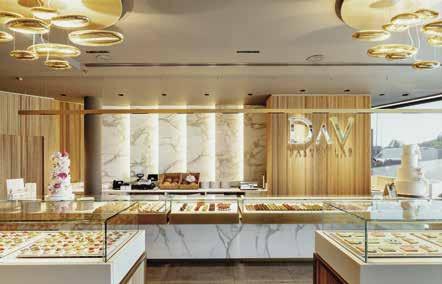
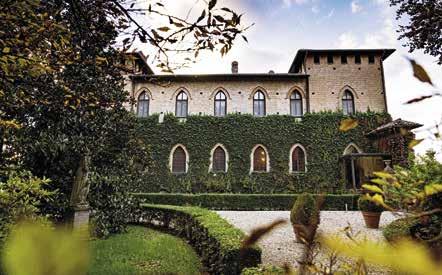
that the business must also function effectively and generate profit.
Unfortunately, there is no shortage of challenges, from conservation regulations and zoning issues, to bureaucratic difficulties and the need for extensive renovations. A collaborative approach between professionals, entrepreneurs and institutions is essential to help address these critical issues, with all involved putting individual issues to one side and staying focused on the common good.
From a personal perspective
On a personal level, I see adaptive reuse as a win-win-win concept. It’s good for the environment, celebrates history and culture, and enriches communities. Adaptive reuse means having the honor and privilege to continue a story and, at the same time, give entrepreneurs, brands and institutions the opportunity to invest in a more sustainable way by prolonging the value of the legacy. It’s a concept that I hope continues to gain momentum and shape the future of urban development for years to come. desita.it
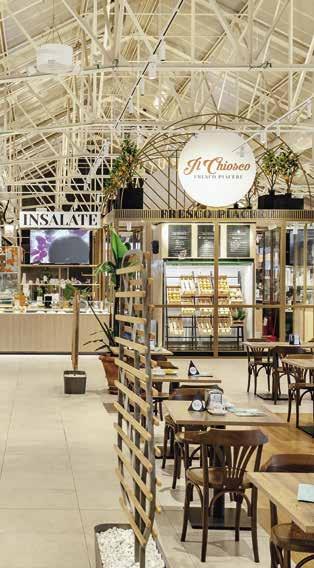
In collaboration with
Da Vittorio Pastry Lab, Italy
Castle of San Gaudenzio, Italy
Centrale Gourmet, Italy
MAY-JUL 2024 | HOSPITALITY NEWS ME 41

FROM BEAN TO CUP:
WHAT’S CAUSING A STIR ON THE COFFEE SCENE
A token of hospitality, an essential component of cafe culture and a welcome pickme-up at home or in the workplace, coffee remains as refreshingly popular today as ever, proudly sitting in third place on the global list of most-consumed beverages.
In our Special Report, five experts spill the beans on all things coffee related, from what’s needed to create a leading coffee brand to the latest industry innovations. Think smart coffee machines, alternative brewing methods, tech-infused ordering and AI-powered recommendations just for starters.
Topical issues, such as the pressing need to find fair, sustainable solutions for the industry at each stage of the value chain, beginning with farmers, are also explored.
Take a coffee break and enjoy the read.
FEATURING
P.44
12 STEPS TO BUILDING A WORLD-CLASS COFFEE BRAND
P.46 WHAT’S IN STORE: COFFEE WITH A DESIGNER TOUCH
P.48 WHY THE COFFEE VALUE CHAIN NEEDS A MAJOR RETHINK
P.50
8 WAYS THAT SMART COFFEE CHAINS ARE TRANSFORMING THE INDUSTRY
P.52
5 COFFEE-TECH TALKING POINTS
P.53 COFFEE INNOVATIONS
SPECIAL REPORT HOSPITALITY NEWS ME | MAY-JUL 2024 42
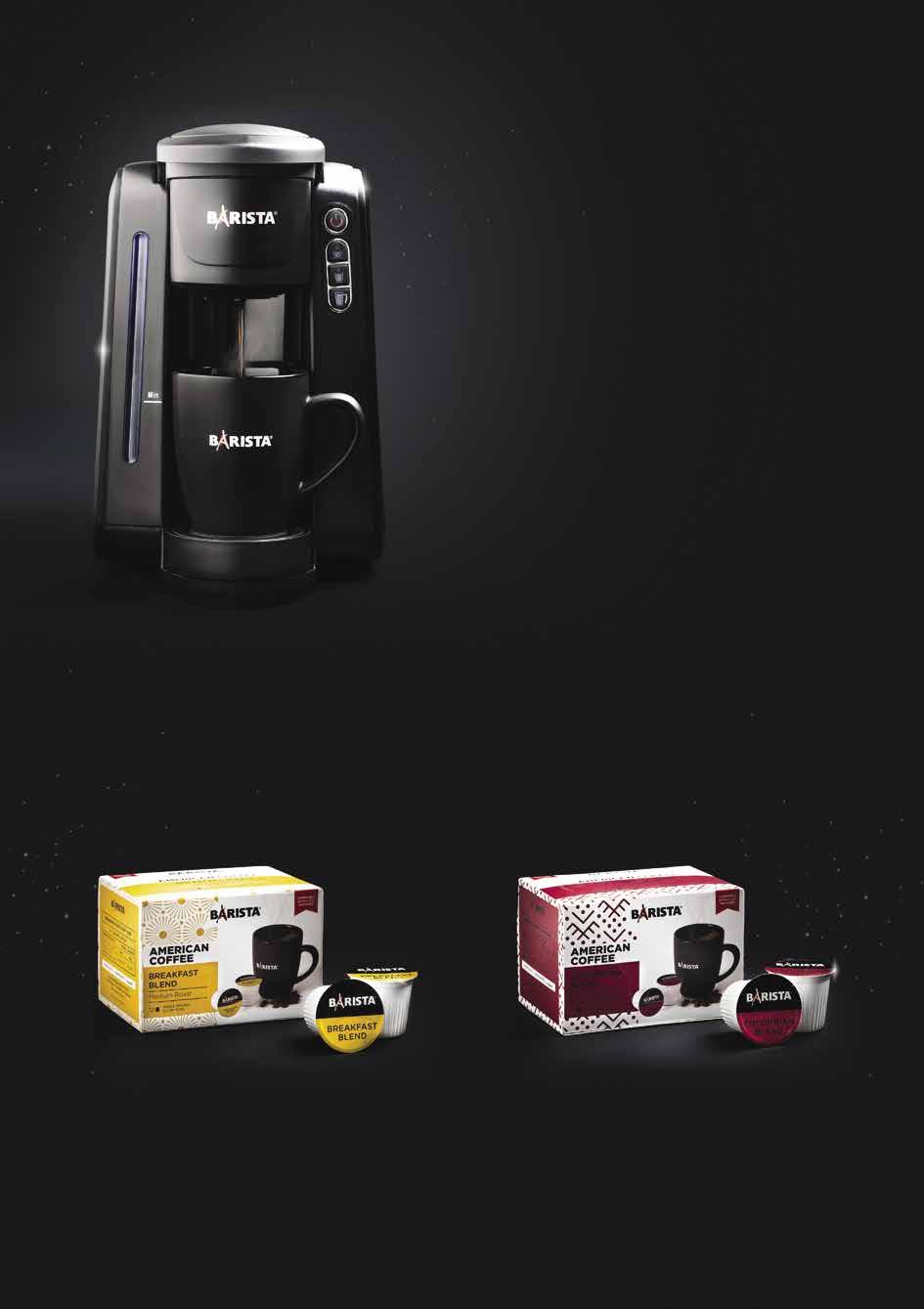
STEPS TO BUILDING A WORLD-CLASS COFFEE BRAND

In a world that runs on caffeine, the coffee industry has witnessed unprecedented growth and innovation. However, building a world-class coffee brand and standing out in a competitive market require much more than simply offering customers a good cup of joe. These essential steps, spanning bean to brew, offer an excellent place for industry hopefuls to start.
1-Use quality beans
The foundation of any great coffee brand is the quality of its beans. Sourcing premium coffee beans from reputable growers ensures a distinct and superior flavor profile. Building relationships with coffee farmers from different origins, investing in sustainable and ethical practices, and understanding the nuances of different coffee regions contribute to the authenticity of the brand.
2-Craft a compelling brand story
Consumers are increasingly drawn to brands with a compelling narrative. Share
While the coffee industry is undoubtedly booming, competition remains fierce, with customers spoilt for choice when it comes to choosing their brew. Against this backdrop, Christian Salloum, managing director of BrandPortunity F&B Consulting, shares an essential step-by-step checklist for business leaders looking to create a top-notch coffee brand.

the journey of your coffee beans, the passion behind the roasting process and the commitment to sustainability. A strong brand story helps create an emotional connection with customers, turning them into loyal advocates.
3-Select distinctive packaging
Visual appeal plays a crucial role in brand recognition. Invest in a unique and memorable brand logo, design and packaging. The packaging should not only protect the freshness of the coffee but also convey the brand’s personality and values. Consider environmentally friendly packaging options to align with current consumer preferences.
4-Adopt a timeless approach
Think about incorporating a vintage element into your branding strategy. Vintage aesthetics evoke a sense of nostalgia and authenticity. This timeless approach can set your coffee brand apart by giving it a unique and memorable
identity. From retro-inspired logos to vintage-themed packaging, infusing a touch of the past into your brand can resonate with customers seeking a connection to tradition and craftsmanship.
5-Research your location
The location of your coffee establishment can significantly impact its success. Consider the demographics of the area, foot traffic and competition when choosing a location. A bustling urban area may well attract a different clientele than a cozy suburban neighborhood spot. Additionally, proximity to offices, universities or cultural hubs can influence the customer base and the overall atmosphere of your coffee brand.
6-Know your target audience
Understanding your target audience is crucial for tailoring your brand to customers’ preferences. Conduct market research to identify the demographics, interests and behaviors of your potential
COFFEE SPECIAL REPORT
12 44 HOSPITALITY NEWS ME | MAY-JUL 2024
customers. Are you targeting busy professionals seeking a quick caffeine fix or perhaps students looking for a cozy study spot? Knowing your audience allows you to align your brand, menu and marketing strategies accordingly.
7-Create an inviting, unique space
The ambiance of a coffee shop is as vital as the quality of the brew. A clutter-free, minimalistic layout fosters a calming atmosphere and allows customers to focus on the true star of the show: the coffee. By choosing carefully considered decor, comfortable seating and functional design elements, you’re also helping to create a memorable in-store experience without breaking the bank. Consider adding unique features, such as coffee tastings, educational sessions or collaborations to differentiate your brand and keep customers coming back.
8-Take care of the team
Behind every thriving coffee brand is a team that shares the passion for delivering excellence. From skilled baristas to enthusiastic staff creating a welcoming atmosphere, the people behind the scenes are the true architects of success. Building a world-class coffee brand requires talented individuals, but also a solid management team overseeing daily activities, implementing strategic decisions and fostering a positive work culture. The synergy between a dedicated team and effective management forms the backbone of a successful coffee brand, ensuring that every aspect of the business operates seamlessly. By investing in the training and well-being of your team, you are creating a brand that will be known for its commitment to both customers and employees alike.
9-Prioritize consistency
Consistency is key in the coffee industry. Customers expect the same quality from every cup, from the flavor profile to the brewing process and the presentation. Establishing rigorous quality control measures and training staff to maintain consistency across all outlets, whether physical or online, is imperative for building trust and loyalty.
10- Embrace technology
In the digital age, leveraging technology can set a coffee brand apart. Utilize social media platforms to engage with customers, share behind-the-scenes content and gather feedback. An online presence not only enhances brand visibility, but also provides a platform for building a community around your coffee brand.
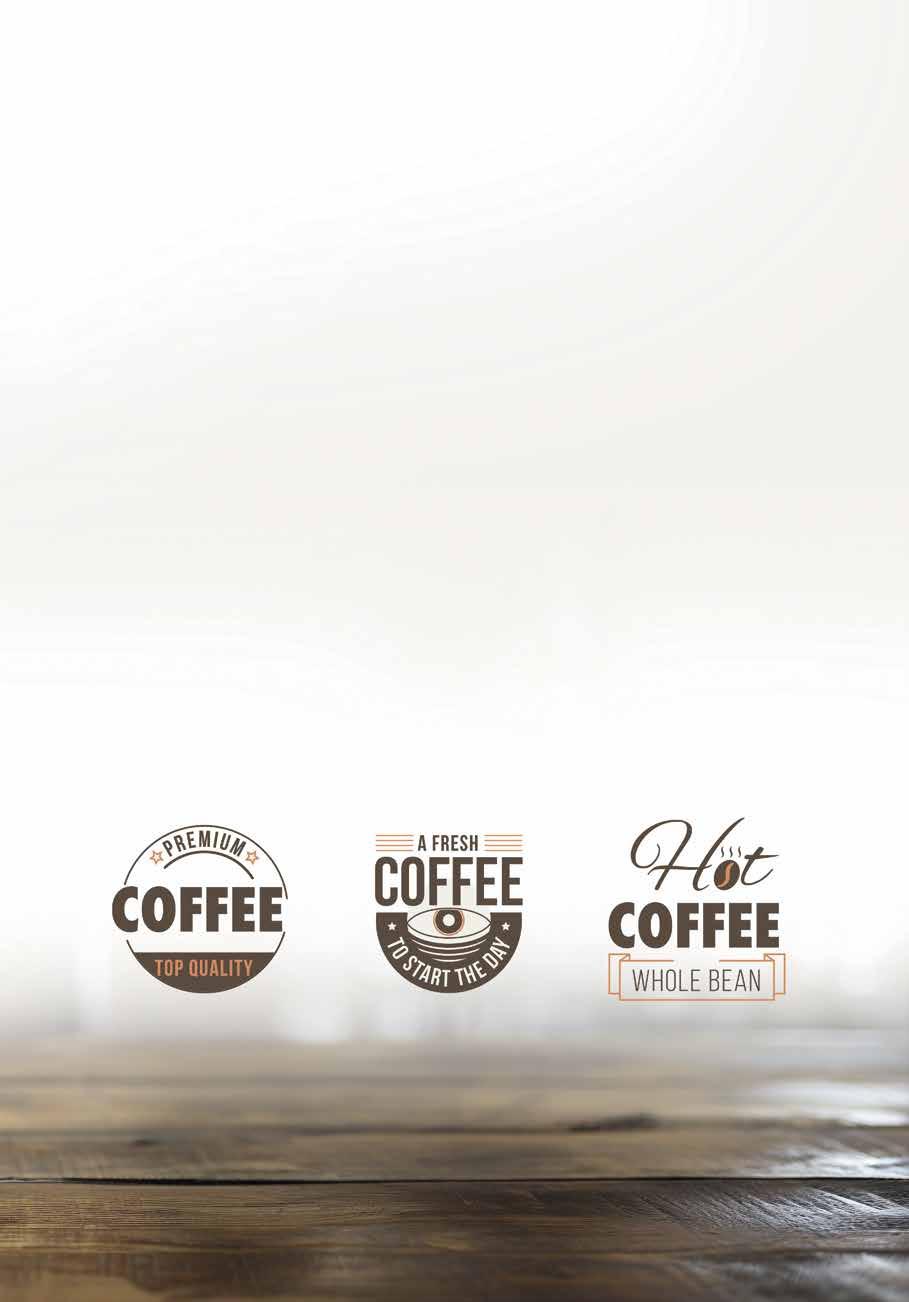
Consistency is key. Customers expect the same quality from every cup, from the flavor profile to the brewing process and the presentation.

11-Keep the menu fresh
Beyond the coffee itself, the quality and selection of the F&B menu play a pivotal role in establishing a worldclass coffee brand. Consider offering a variety of options, including both cold and hot coffee varieties. Experiment with unique flavor combinations and seasonal offerings to keep the menu fresh and exciting. Incorporate highquality ingredients and consider dietary preferences, such as vegetarian and vegan options, to appeal to a broader customer base.
12-Share your journey
From the moment of creation, the story of your brand is being written. Document the journey, challenges and triumphs. Share the evolution of your coffee brand, whether it’s a family legacy passed down through generations or a visionary start-up fueled by passion. Authentic storytelling creates a narrative that customers can relate to, fostering a deeper connection and loyalty.
Building a world-class coffee brand requires a harmonious blend of quality, storytelling, branding and customer engagement. By focusing on these key elements, while also thinking about location and target audience, a coffee brand can rise above the competition, creating a lasting impression on coffee enthusiasts worldwide. From the first sip to the last drop, the journey of building a world-class coffee brand is an exciting and rewarding endeavor that encompasses every aspect of the coffee experience.
brandportunity.com
In collaboration with
45 MAY-JUL 2024 | HOSPITALITY NEWS ME
WHAT’S IN STORE: COFFEE WITH A DESIGNER TOUCH

Luxury brands continue to flourish, selling their customers the dream with glitz and glamor. Food is an ideal medium for channeling creativity, with hospitality well placed to offer a one-of-a-kind experience that’s usually more affordable than designer clothes or accessories. Perhaps we shouldn’t be surprised, then, that luxury brands are trying their hand at culinary art.
High-end coffee shops, in particular, are proving to be a popular option for brands looking for a platform to convey their distinctive stamp. If you’re wondering where to find these luxury branded cafes, a good starting point is inside or next to designer stores, or in the stomping ground of their elite and cosmopolitan clientele.
A winning Italian formula Italy is synonymous with major fashion brands and good food - a winning combo that makes the country an ideal location to open a coffee shop with luxury couture. Armani was a pioneer and spotted the potential of this marketing opportunity as far back as 2000, when the luxury brand opened its Emporio Armani Caffè and Ristorante via Croce Rossa in Milan. Open from dusk till dawn, it also has a lounge and a champagne bar. The venue underwent a full makeover in 2019, redesigned by Giorgio Armani himself, while the menu has Mediterranean influences, in keeping with the designer’s personal food tastes. In 2017, the brand also opened a branch of its Caffè in Bologne. Milan is also Prada’s place of birth and, since 2015, when its mastermind Muccia Prada opened her contemporary Art Fondazione, Bar Luce has been welcoming art, fashion and cinema lovers. Inspired by typical Italian cafes with Formica furniture and wood panels, the decor was conceived by the American director Wes
With so many of today’s shoppers displaying an insatiable appetite for luxury brands, perhaps it was only a matter of time before more high-end labels began offering coffee and culinary delicacies in their stores or at standalone cafes. Nagi Morkos , founder and managing partner at Hodema Consulting Services, takes us on a luxury coffee shop global tour.
Anderson, who described the venue as a great “place to write a movie.” Visitors to Florence, meanwhile, should look out for the Gucci Giardino 25 in the dreamy Plaza della Signoria. The latest addition to Gucci Garden, the cafe offers a selection of highend specialty blends, before transforming into a cocktail venue when night falls. Parisian style in a cup Paris and stylish luxury fashion go hand in hand, so it should come as no surprise that nestled in the heart of the City of Lights, facing the river Seine, Le café Maxime Frédéric at Louis Vuitton can be found. The young chef, awarded the highest pastry nod by Le Gault & Millau in 2022, offers sugary delicacies in a tropical setting. A lunch menu is also available for those seeking something savory. Heading over to the iconic fashion boulevard Avenue Montaigne, visitors will find not only the Dior flagship store, but also its cafe and restaurant. The patisserie, located on the ground floor, provides a chic pitstop for those visiting the nearby museum. In contrast, Yves Saint Laurent has introduced a more underground take on the cafe concept, having attached to its shop a small and edgy chair-free coffee corner with red and neon lights. Located on the Saint-Germain-des-Prés crossroads and opened in 1998, visionary brand Armani’s Emporio Armani Caffè & Ristorante is still going strong, while Ralph Lauren operates a typically American café, named Ralph’s Coffee, which combines authentic style with gourmet treats. Maison Kitsuné, the fashion-forward French-Japanese luxury streetwear label, has found a successful cafe formula, with 18 outlets worldwide, including one located next to the Louvre, which unsurprisingly exudes a classic Parisian bistro vibe.

London: shops and coffee stops
In London, the luxury coffee shops lie at the heart of busy shopping districts. Some are even inside department stores, such as American jewelry brand Tiffany & Co.’s Blue Box Cafe at Harrod’s. The chic corner is now also home to a Prada Caffè, following in the steps of Fendi, which opened a pop-up caffe in 2019. In Belgravia, meanwhile, the quirky designer Anya Hindmarch has transferred her imaginative designs to food. Visitors to Anya Cafe will find a menu that includes monster cakes, chubby hearts and caterpillar tarts. Flagship stores are also proving to be popular spots for brands looking to open cafes. Located at Burberry’s Regent Street address, Thomas’s Café pays tribute to its founder. The company also briefly opened the pop-up Norman’s Cafe in 2023. New Bond Street - another iconic London location - has been home to Ralph’s Coffee since 2014, attracting fashionistas with its typical Ralph Lauren décor. And coffee purists will be delighted to hear that Prada has brought the historic Milanese Cafe Marchesi 1824 to Mayfair.
Asia’s ideal fanbase
Asia is undoubtedly offering luxury coffee shops, given the passion there for high fashion. An early bird, Armani opened its Emporia Armani Caffe in Tokyo, Japan, followed by a second in Osaka. The Japanese capital is definitely the go-to location; Cafe Dior has partnered with Ladurée in the popular Ginza district, while in the same area, Le Café V, by Louis Vuitton, offers flavors of Paris. Bulgari, meanwhile, brings glamor to Il Café, situated near the Italian house’s jewelry shop in Omotesando. Gucci Café
COFFEE SPECIAL REPORT HOSPITALITY NEWS ME | MAY-JUL 2024 46

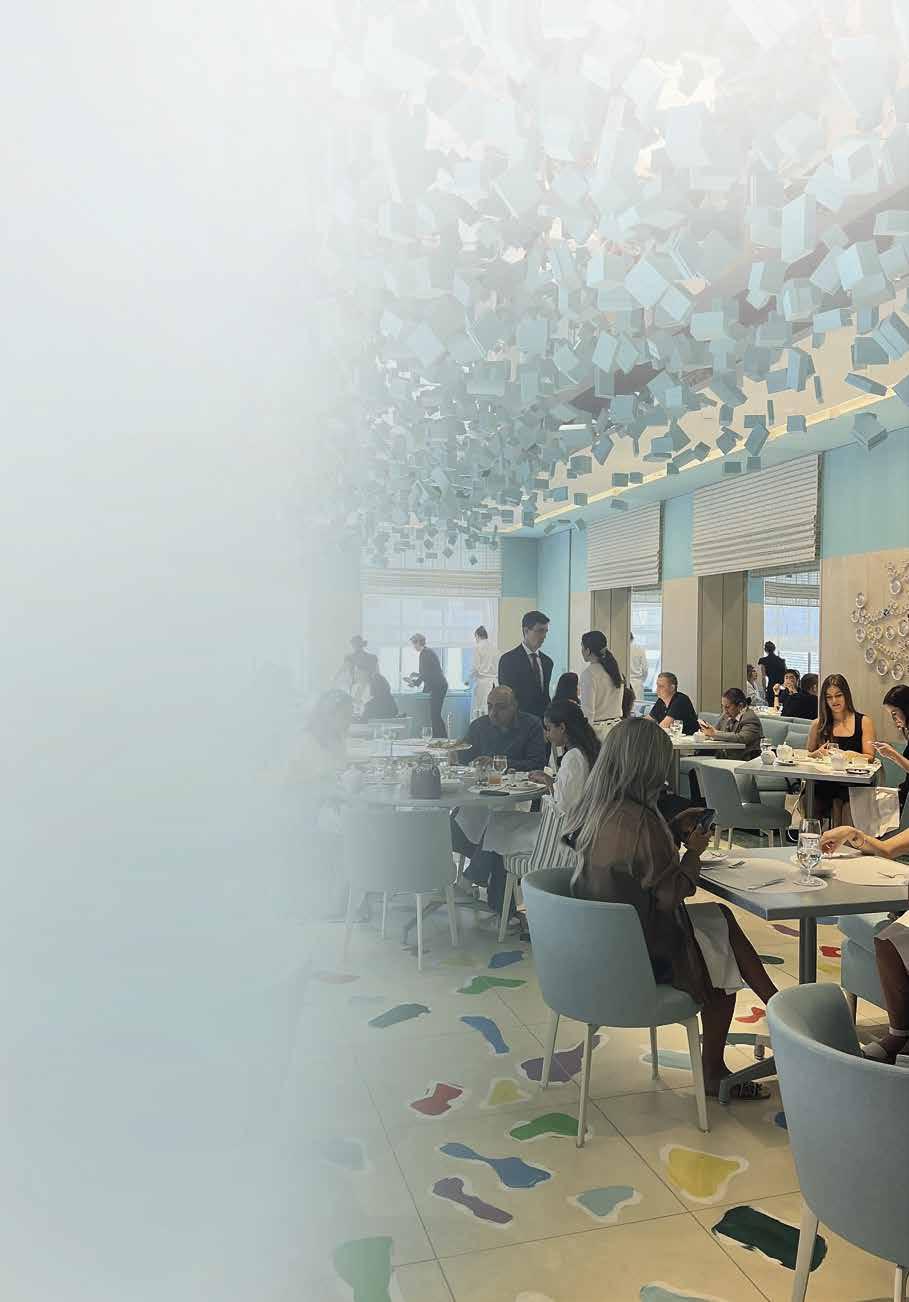
Luxury branded cafes are often inside or next to designer stores, or in the stomping ground of their elite and cosmopolitan clientele.
takes things to the next level, offering chocolates stamped with the brand’s logo, while Ralph’s Coffee has put down roots in both Tokyo and Kyoto. The US fashion company’s coffee shop can also be found in Beijing, in a sign that things are booming in China, another fashionloving nation, too. Burberry has opened a branch of its Thomas’s Cafe in Shenzhen and, in recent years, several pop-ups have also made the headlines, from the Prada Garden at Jiya Gathering to the Fendi Caffe in Changbaishan. Other luxury brand cafes drawing in fashionistas include Vuitton at the Yuyuan Shopping Center and the Qixi Festival, the Maison Margiela and Seesaw Coffee pop-up. On the other side of the strait, Hong Kong is proving to be a firm designers’ favorite. The Tiffany Blue Box Cafe has opened a branch there, alongside Ralph Lauren’s Ralph’s, with Vivienne Westwood and Agnès b. also taking the plunge.
Designer cafe life from Dubai to Egypt It didn’t take long for Dubai to become a destination associated with luxury and marketing. Today, the emirate is firmly established as home to both money and luxury brands, so it was only a matter of time before high-end cafes opened their doors there. Armani, again a trailblazer in the industry, opened its first cafe in 2006, before expanding to Egypt and later to Doha. It has two branches at the Mall of the Emirates and Dubai Mall. Two familiar names - Tiffany Blue Box Café and Ralph’s – can also be found there. In addition, Valentino briefly launched a pop-up at Atlantis the Royal toward the end of 2023. hodema.net
In collaboration with
47 MAY-JUL 2024 | HOSPITALITY NEWS ME
The Tiffany Blue Box Café
WHY THE COFFEE VALUE CHAIN NEEDS A MAJOR RETHINK

Coffee - a word that means a stock market commodity, a bean, a drink and a social event.
On average, over 2.25 billion cups of coffee are consumed daily throughout the world - that is 93.7 million cups every hour of every day. If one takes a moment to zoom out and think about how much coffee we are consuming, and how many coffee beans that involves, the numbers are impressive.
There are a total of 70 coffee-producing countries in the world, 50 of which export their beans. From these, the 10 major producers are Brazil, Vietnam, Columbia, Indonesia, Ethiopia, Uganda and Honduras.
The global coffee market was valued at approximately USD 134.85 billion in 2023. It is expected to continue growing at a CAGR of 6.4 percent between 2024 and 2032 to reach a value of USD 236.98 billion at the end of this forecast period.
A tale of two halves
The coffee industry is undoubtedly a lucrative one; however, the reality is less glamorous. The coffee value chain comprises four steps that can be split into two categories, each with its own sets of complications:
The need to find holistic, fair, sustainable solutions for the coffee industry is becoming increasingly urgent. Daniel During, principal and managing director of Thomas Klein International, explains why the search for answers has to start with the farmers and not with the cup.

• labor-intensive: cultivating and processing, in labor-abundant countries
• capital intensive: roasting and branding, in northern hemisphere, industrialized countries.
If we trace the journey of the coffee you are probably drinking while reading this article, the chances are that it begins in countries like Vietnam or Uganda. Here, farmers laboriously farm, cultivate and process the beans that find their way into your morning Americano or afternoon espresso in Europe or the Americas.
It’s crucial to recognize and bear in mind that coffee isn’t just a beverage, but a source of income for between 20 million and 50 million families worldwide. Astonishingly, smallholder farmers account for 60 percent of the world’s coffee production. Yet, despite their indispensable role, the uncomfortable truth is that half of these farming families grapple with poverty. In fact, one-quarter endure extreme poverty.
Challenging work, difficult conditions
Consider this; for every kilo of coffee beans harvested, most farmers receive a mere USD 2.20. Just think about that for a moment – a meager USD 2.20 in exchange for hours of intense labor, often
endured amidst harsh weather conditions and in less-than-ideal safety environments.
To say that all coffee farmers are working in these conditions would be wrong. However, when the vast majority are getting the short end of the stick, it raises questions. The job of a coffee farmer is an unpredictable one, with challenges faced ranging from climate change and environmental degradation to price volatility.
Rising temperatures and unpredictable rainfall are altering coffee-plant growing conditions. These factors are contributing to decreased yields, with crops at higher risk from pests and diseases. Coffee farmers face increased production costs which, in turn, take them down the route of child labor. This downward spiral then continues, leading to lower attendance and attainment in education and, ultimately, generational deficiencies.
An at-source disconnect
Every stage of the coffee supply chain claims its portion of coffee’s value. From the hands of growers to traders, processors, exporters, roasters and retailers, each entity plays a role in shaping the journey of the coffee beans until they culminate in the brew poured into your coffee cup. However, for many smallholder farmers, there exists
COFFEE SPECIAL REPORT HOSPITALITY NEWS ME | MAY-JUL 2024 48
a profound disconnect. They often lack insight into where their coffee goes, the price it commands in the market and the identity of the end consumer.
This lack of transparency makes it difficult for smallholders to understand the value of what they’re creating and certainly limits their ability to fight for their living income. Meanwhile, others in the chain are making millions off this trade.
Welcome changes
On the positive side, consumer interest in ethical business practices is constantly increasing, sparked by the rise in popularity of specialty coffee and growing collective awareness around sustainability and transparency issues. Light is being shed on the malpractices taking place in key
Many smallholder farmers lack insight into where their coffee goes, the price it commands in the market and the identity of the end consumer.
industries, including the coffee segment, which have been largely monopolized.
As a result, businesses and brands have started investing millions in key, targeted programs, amidst concern about their image in relation to climate change and fair trade. These initiatives are teaching farmers about sustainable and safe practices, as well as how to grow coffee in warmer climates and use soil management practices to alleviate the negative impacts of climate change on soil quality.
Finding long-term solutions
However, focusing solely on supporting individual farmers only provides a partial solution. Key players can drive more far-reaching improvements by investing in the broader communities where these farmers reside. By doing so, they will not only be addressing the immediate needs of agricultural producers, but also contributing to the overall development and prosperity of the entire community. This approach acknowledges that sustainable and inclusive growth involves supporting entire communities and strengthening their social fabric. It recognizes that improving infrastructure


and services will ultimately produce societies that are more resilient and able to thrive.
A sustainable supply chain
When we consider the coffee sector’s impact on climate change at each stage - from growing and transportation to processing and brewing - it quickly becomes clear that the situation is incredibly complex. Solutions must be focused on making the entire coffee supply chain more sustainable and fairer, rather than on simply increasing supply.
Finding sustainable solutions is crucial for future growth and longevity. Mitigating challenges without resorting to deforestation for expanding production is paramount. By embracing responsible practices, promoting transparency in the supply chain and supporting smallholder farmers, the industry can move toward a more equitable and environmentally conscious future. Only through collaborative efforts and mindful strategies can we continue to thrive while preserving the ecosystems upon which we all depend.
thomaskleingroup.com
In collaboration with
49 MAY-JUL 2024 | HOSPITALITY NEWS ME
WAYS THAT SMART COFFEE CHAINS ARE TRANSFORMING THE INDUSTRY

In the fast-paced world of technology, innovation is reshaping even the most traditional sectors. One such area that has seen a remarkable transformation is the coffee industry. The emergence of tech-led coffee chains is not merely about brewing a cup of joe; it’s a blend of cutting-edge technology, customer-centric experiences and a dash of entrepreneurship.
There are several ways that these newgeneration coffee chains are disrupting the landscape of the world’s favorite drink. Below are eight of the top disruptors:
• Tech-infused ordering - the days of waiting in long queues or shouting orders across a counter at busy staff grappling with customers hard pressed for time are fading away. Tech-led coffee chains are pushing boundaries by leveraging mobile apps and self-service kiosks to streamline the ordering process. Coffee lovers can customize their drinks, pre-order and pay seamlessly through their smartphones. This enhances efficiency and also adds a personalized touch to the coffee-buying experience. cofeapp.com is one such example of this new means of ordering, operating as an aggregator for multiple brands.
From personalizing orders to streamlining services and payment methods, tech-led cafes are shaking up what has long been perceived as a traditional segment of the F&B sector. Abdul Kader Saadi , founder and managing director of Eighty6, explains why the future of coffee shops is about bytes, as well as beans.

• Data-driven personalization - in the digital age, data is undoubtedly king and tech-led coffee chains are among the lines of business making the most of it. By collecting and analyzing customer preferences, these chains can offer personalized recommendations, promotions and loyalty rewards, among other initiatives. Imagine walking into your favorite coffee spot and finding that your usual order is ready even before you’ve placed it. This is just one example of the power of data-driven personalization. Data-driven innovations are already making waves across the coffee industry in forwardthinking locations. Examples include Luckin Coffee (luckincoffee.com), which has been disrupting the coffee scene in China with its technology-driven retail model. The chain, which leverages big data analytics and AI to optimize its systems, also extended its reach into Singapore in 2023. Flash Coffee (flashcoffee.com/id) is another Asian coffee chain operating a network of coffee outlets across the region with a technology concept.
• Smart supply chain managementcoffee chains are leveraging technology to optimize their supply chain. From predictive ordering systems that ensure inventory is never depleted to blockchain solutions confirming the authenticity of coffee beans, technology is enhancing efficiency and transparency across the entire supply chain. This not only reduces waste, but also ensures a more sustainable and ethical sourcing process.
• Smart cafes and IoT integration - welcome to the era of the smart cafe, where Internet of Things (IoT) devices seamlessly integrate into the coffee experience. Smart coffee machines, connected brewing equipment and even smart tables not only function at an optimal level, but also enhance the overall ambiance. Imagine a café where your favorite playlist automatically comes out over the speakers when you walk in or the lighting adjusts to your mood. These are the small yet impactful details that make techled coffee chains stand out and more likely to garner return visits.
COFFEE SPECIAL REPORT
8
HOSPITALITY NEWS ME | MAY-JUL 2024 50


• Contactless payments and cashless transactions - the era of carrying wallets or digging for loose change is giving way to contactless payments. Tech-led coffee chains have embraced digital wallets, NFC technology and other contactless payment options to provide a smoother transaction experience. This not only speeds up the payment process, but also aligns with the broader shift toward a cashless society.
• Virtual baristas and AI-powered recommendations - Artificial Intelligence (AI) is stepping into the barista’s shoes, with virtual assistants taking orders and even going so far as to provide recommendations. AI algorithms learn customer preferences over time, offering suggestions for new blends or products based on individual taste profiles, from infusions and milk alternatives to decaf coffee choices. It’s like having a personal coffee concierge guiding you through the menu.
• Enhanced customer engagement through social media - tech-led coffee chains understand the importance of social media in today’s connected world. These chains leverage platforms like Instagram, Facebook and X (formerly Twitter), not just for marketing, but also to engage with their customers. Interactive campaigns, behindthe-scenes glimpses and user-generated content create a sense of community, turning coffee consumption into the shareable experience that today’s customers enjoy and expect.
• Augmented reality coffee experiencessome tech-savvy coffee chains are taking things a step further with augmented reality (AR). Imagine pointing your smartphone at your cup, and suddenly, the story behind the coffee beans unfolds in a captivating AR display. This immersive experience adds a welcome layer of storytelling to the coffee-
Coffee lovers can customize their drinks, pre-order and pay seamlessly through their smartphones. This enhances efficiency and also adds a personalized touch to the coffee-buying experience.
drinking ritual, connecting consumers with the journey of their cup of coffee.
The new generation of tech-led coffee chains is about much more than offering great coffee in a welcoming setting. Customers can expect to find both of these. However, the latest cutting-edge cafes offer an added dimension; we’re talking about a lifestyle which has technology at its heart, enhancing every aspect of the coffee experience. From personalized orders to sustainable sourcing, these chains are brewing a great cup, while shaping the future of coffee culture. As we sip on our tech-infused lattes, one thing is becoming increasingly clear: the future of coffee is not only in the beans, but also in the bytes.
eighty6.shop
In collaboration with
51 MAY-JUL 2024 | HOSPITALITY NEWS ME
COFFEE-TECH TALKING POINTS

The way coffee is consumed around the world is changing and technology has become instrumental in shaping how we experience and savor this beloved drink. Below are some of the latest advancements in coffee technology, alongside others that we can expect to see shaking things up in the near term.
1-Alternative brewing methods
While espresso and drip coffee maintain their popularity, alternative brewing techniques, like V60 and Chemex, are increasingly appealing to coffee enthusiasts in search of distinctive flavors and experiences. Technologies such as vacuum brewing, cold drip and nitro infusion provide fresh avenues for coffee extraction and enjoyment. These methods typically require meticulous control over brewing variables and innovative equipment designs to achieve the best outcomes.
2-Precision brewing
Precision brewing has become a focal point for coffee enthusiasts seeking the perfect cup. Technologies such as temperature stabilization, flow rate control and pressure profiling enable professional and home baristas alike to achieve greater consistency and quality in their coffee extraction process. Whether it’s a pour-over dripper with
Once a simple, humble beverage, our everyday coffee has evolved into a global phenomenon, ranking today as the third-most-consumed beverage worldwide. Cleia Junqueira , coffee consultant at The Coffee Connoisseur Collective, highlights a handful of key innovations that are steering the industry into the future.
built-in scales or an espresso machine with precise temperature control, these innovations empower users to unlock the full potential of their coffee beans. We’re already benefiting from the integration of robots into espresso-making processes, which is particularly advantageous in highvolume commercial settings.
3-Smart coffee machines
One of the most noticeable advancements in coffee technology is the emergence of smart coffee machines. These machines are equipped with wi-fi connectivity and mobile apps, allowing users to control brewing parameters remotely. Whether it’s adjusting the water temperature, selecting the grind size or scheduling brewing times, smart coffee machines offer unprecedented customization and convenience. Some models even incorporate AI algorithms to learn and adapt to users’ preferences over time.
Innovations, such as a pour-over dripper with built-in scales or an espresso machine with precise temperature control, empower users to unlock the full potential of their coffee beans.

4-Traceability from bean to cup
With consumers increasingly keen to know the ethical considerations relating to their coffee beans and origins, blockchain technology is being utilized to ensure transparency and traceability across the supply chain. Through a tamper-proof ledger that records every step from farm to cup, blockchain empowers consumers to authenticate the origins and ethical practices behind their coffee. This not only cultivates trust between producers and consumers, but also encourages the adoption of sustainable and ethical practices within the coffee industry. It’s becoming increasingly common to find packaging that narrates the journey from bean to cup.
5-Sustainable practices
In recent years, there has been a growing emphasis on sustainability within the coffee industry. Technological innovations play a crucial role in this regard, with advancements in farming techniques, processing methods and packaging materials aimed at reducing environmental impact. For example, precision agriculture utilizes sensors and data analytics to optimize crop yield, while minimizing water usage and chemical inputs. Similarly, eco-friendly packaging solutions, such as compostable coffee pods and biodegradable packaging, help mitigate the environmental footprint of coffee consumption.
In the pipeline
The future of coffee technology is full of exciting possibilities, from personalized brewing algorithms to sustainable farming practices driven by AI. As the industry continues to evolve, collaboration between coffee professionals, technologists and environmentalists will be key to shaping a more sustainable and enjoyable coffee experience. Utilizing data analytics to enhance crop yields and developing ecofriendly brewing equipment are just two examples of how innovation will be pivotal in shaping coffee’s future.
cleiajunqueira.com
COFFEE SPECIAL REPORT
5
In collaboration with 52 HOSPITALITY NEWS ME | MAY-JUL 2024
COFFEE INNOVATIONS

HONEY COMSA FROM AMAVIDA COFFEE
Honey Comsa, a medium roast Honduran coffee sourced from the Comsa Cooperative, is the latest offering from Amavida Coffee Roasters. AMAVIDA COFFEE amavida.com

AEROPRESS CLEAR COLORS COFFEE MAKERS
This new collection of coffee makers comes in five colorways: Clear Purple; Clear Blue; Clear Red; Clear Green; and Clear Black. AEROPRESS AeroPress.com

MYTICO PROFESSIONAL COFFEE MACHINE
Embodying typical Italian design, this new professional coffee machine is the ideal blend of traditional craftsmanship and stateof-the-art technology. FRANKE franke.com


CHAMELEON RTD COLD-BREW COFFEE
Chameleon Organic Coffee® is offering new ready-to-drink (RTD) 8oz cold-brew can options: Nitro Black; Double Espresso; Sweetened Black; and Flat White.
CHAMELEON ORGANIC COFFEE® chameleonCoffee.com

BREVILLE ORACLE® JET ESPRESSO MACHINE
The Oracle® Jet is the latest home espresso machine from Breville, pushing boundaries in terms of performance, automation and speed. BREVILLE breville.com

KITCHENAID ESPRESSO COLLECTION
The new KitchenAid Espresso Collection includes one semi-automatic espresso machine with burr grinder and three fully automatic espresso machine offerings.
KITCHENAID kitchenAid.com
ZERNO™ Z1 COFFEE GRINDER
This coffee grinder showcases a modern, timeless design and comes precision-aligned, with easily swappable components, including a prebreaker design. ZERNO zerno.co

POP & BOTTLE COLD BREW
Pop & Bottle, producers of plant-based lattes and coffee concentrates, have launched Organic Cold Brew Coffee in a 48oz, multi-serving bottle.
POP & BOTTLE popandbottle.com

THE KEURIG® K-CUP® POD SYSTEM PRODUCTS
Keurig Dr Pepper’s new system includes the Keurig® K- Brew + Chill™ brewer with QuickChill Technology™ and coffee-shopstyle K-Cup® pods. KEURIG DR PEPPER keurigdrpepper.com

EGRO MODE ESPRESSO MACHINE
The Egro MoDe is a super-automatic espresso machine that packs the latest coffee-brewing technology into a compact design.
EGRO egrousa.com

LA MARZOCCO SWAN ESPRESSO GRINDER
Pairing beautifully with all La Marzocco espresso machines, the Swan is the line’s new flagship commercial espresso grinder.
LA MARZOCCO lamarzocco.com/countries
MAY-JUL 2024 | HOSPITALITY NEWS ME 53


Today, the global affinity for indigenous and fusion fast moving consumer goods (FMCGs) is second to none, providing an ideal environment for selling products and services across the globe.
Internal consumption: the risks FMCG companies in the MENA region are currently grappling with significant economic challenges. Sustainable revenue sources are needed to address these issues. Relying heavily on internal consumption exposes FMCG companies to risks associated with fluctuations in domestic demand, political instability and regional conflicts. Diversifying the economy is a vital step that can be achieved through an export-oriented approach. This, in turn, reduces the vulnerability to local economic downturns and mitigates the impact of internal shocks or crises.
The pursuit of international markets requires businesses to meet stringent quality standards, adopt advanced technologies and engage in continuous improvement. This will fuel innovation, enhance productivity and bolster competitiveness within industries. It will also elevate the overall competitiveness of products and services, increasing market share and higher profitability. It is for these reasons that FMCG companies in the MENA region must prioritize and focus on exports now more than ever.
GOING GLOBAL: 7 WAYS TO BOOST EXPORTS
At a time when the region’s FMCG firms face a challenging economic environment, it makes sense to increase the focus on international sales. Sam A. Jaoude, consultant and CEO of Madenlebanon LLC, shares a checklist of essential steps to getting export ready.
Leveraging export channels
To grow exports, it is crucial to utilize various channels and strategies that can help to expand market reach and attract international customers. The following steps, listed in order of priority, are imperative ones to take:
1-Market intelligence - conducting thorough market research and competitive analysis is essential to understand target markets, trending products and price structure. Identifying consumer preferences and palates is another must. This knowledge enables businesses to tailor their offerings to meet international demands effectively.

Relying heavily on internal consumption exposes FMCG companies to risks associated with fluctuations in domestic demand, political instability and regional conflicts.
2-FDA and labeling - food is subject to various regulations and safety standards in different countries. Research the applicable regulations related to food production, packaging, labeling and food safety to ensure compliance with local laws and regulations in the target market.
3-International trade fairs and exhibitions - these events provide key opportunities to establish connections, meet potential partners, explore export prospects and gain insights into market trends and demands. Always ensure that your potential buyers know you’re taking part to maximize the benefits.
4-Distributors and agents/brokerscollaborating with reputable distributors in target markets can help protect brand integrity, especially when entering unfamiliar territories. Local agents/ brokers who possess market knowledge, established networks and distribution channels can help you manage your brand and reach your goals with ideal buyers more quickly.
5-Digital marketing and social media
- partnering with international digital marketing and social media platforms that understand FMCG products is crucial for boosting brand visibility and attracting customers. To maximize engagement, focus on geo-targeting and retargeting as part of your SEO practice.
6-Strategic partnerships for clustering - clustering with businesses in the same field on purchasing similar raw materials can help make your product more competitive in the export industry. This, in turn, helps you to save money which you can spend on incentive programs and marketing.
7-E-commerce - e-commerce is in high demand in the FMCG industry, offering an additional avenue to sell your product in new markets. However, it’s important not to alienate yourself from major retailers in the target market by becoming their competitor. Always establish yourself first in the market with prominent retailers.
madenlebanon.com
MANAGEMENT SOLUTIONS
In collaboration with 54 HOSPITALITY NEWS ME | MAY-JUL 2024
THE PRODUCTIVE SECTORS DEVELOPMENT PROGRAMME (PSDP) MAKES A POSITIVE IMPACT IN LEBANON
In July 2020, the Productive Sectors Development Programme (PSDP) launched a partnership that aims to pool resources, expertise and capacities to support Lebanon’s productive sectors with a particular focus on empowering women and youth in disadvantaged areas. The PSDP, generously funded by the Government of Canada and implemented by six UN agencies (UNIDO, FAO, UNDP, ILO, UNWOMEN and UNICEF), has aimed for gender-responsive job creation and economic growth.
Fostering growth through a comprehensive approach
The program has recognized the multifaceted challenges faced by women in the agriculture and agrifood sectors, including limited market access, inadequate infrastructure and skills shortages. To address these issues, the PSDP has adopted a comprehensive approach, working at three levels:
• At the macro level, the PSDP conducted legislative and policy reviews, as well as a gender analysis, with extensive dialog and consultations with national and international partners.
• At the meso level, the PSDP has collaborated with the government and the private sector to enhance market access for MSMEs in agro-food. This has involved capacity building, export promotion and networking opportunities.
• At the micro level, the PSDP has enhanced the competitiveness of value chains, like fruits, vegetables, nuts and pulses, in northern Lebanon. This has included technological advancements, skills development, business support and market access, among others.

Celebrating the impact of the PSDP in Lebanon Partnerships & Development Finance Officer, Resident Coordinator Office (RCO) – Lebanon, Rony Gedeon, said: “The PSDP, funded by the Government of Canada through the Lebanon Recovery Fund (LRF), marks the start of a new approach
to development in Lebanon that revolves around partnerships for productive sectors development. The PSDP brought together the UN, donor partners, Lebanese Government, private sector, local partners and, most importantly, beneficiaries around common objectives and ambitions, to help Lebanon’s economic recovery.”

First Secretary, Development, at the Embassy of Canada in Lebanon, Alexandra Santillana, also spoke about the positive impact of the program: “Furthermore, during crises, the PSDP has supported over 2,000 vulnerable individuals and around 300 businesses operating in the agriculture and agri-food sectors by enhancing a favorable business environment. Consequently, this gave them exposure to international markets and empowered businesses, farmers and cooperatives to thrive and expand.”
Santillana added that the PSDP exemplifies Canada’s commitments to supporting Lebanon’s productive sectors, fostering economic prosperity, especially for vulnerable women. Moreover, investing in people, specifically women in rural areas, can chart a course toward a more prosperous and resilient future for all.
Kawthar Alawa, owner of Equilibre, was able to showcase a good resilience in sustaining her business despite the economic crisis that marked business opportunities in Tripoli. She received a recognition award at the closing ceremony of PSDP for her outstanding dedication and commitment.

The legacy of the PSDP in Lebanon
After years of dedicated efforts, the PSDP celebrated its achievements with a closing ceremony on April 16 at the UN House. The event acknowledged the successful results and partnerships forged during the program’s tenure, with a booth showcasing PSDP beneficiaries’ products and progress at HORECA Lebanon, a hospitality and foodservice trade fair, which attracted almost 20,000 visitors.
Job creation and more
The PSDP has yielded significant results, with over 2,000 jobs created and sustained, the majority held by women. Additionally, the program has provided support to over 2,000 vulnerable individuals, including training in various aspects of agriculture and business leadership. Moreover, hundreds of MSMEs and farmers have received direct assistance, paving the way for sustainable economic growth and local development.
As the PSDP concludes this chapter, it has demonstrated important lessons of empowerment, transformation and inclusive growth. Through collaborative efforts and unwavering dedication, the PSDP is one chapter of a larger vision for supporting the development of productive sectors in Lebanon.
lebanon.un.org unitednationslebanon
Advertorial
MAY-JUL 2024 | HOSPITALITY NEWS ME 55

Today, the travel journey begins with a click. And increasingly, that click lands not on a booking platform, but on YouTube. The rise of video content consumption has transformed how potential guests make travel decisions, with hotels needing to adapt and utilize platforms like YouTube to remain competitive.
Ignoring YouTube’s potential in today’s travel landscape is a missed opportunity. By embracing video storytelling and strategic content creation, hotels can unlock a powerful tool to capture attention, build trust and ultimately, drive bookings.
Well worth the watch Studies show that 93 percent of travelers check user-generated video content before booking. And hotels have observed conversion rates of over 50 percent when they add videos to webpages. Compared to static images or text descriptions, video offers an immersive and dynamic experience, allowing viewers to virtually step inside your hotel. It’s an emotional connection unlike any other, showcasing your unique atmosphere, amenities and surroundings.
The video king YouTube reigns supreme for the following reasons:
• Reach and engagement - YouTube boasts over 2 billion monthly active users, offering unparalleled reach. Its algorithm favors engaging content, ensuring your well-crafted videos can organically reach targeted audiences.
HOW TO CONVERT CLICKS INTO BOOKINGS
It’s a fact that virtual visits and viewing video content are steps that almost all of today’s customers will take before making a travel booking. Riky Bains, strategist at Brash, explains why embracing the clickable future, especially YouTube, is crucial in a competitive industry.
• Versatility and creativity - from room tours and guest testimonials to drone footage and behind-the-scenes glimpses, video formats are diverse and cater to different viewing preferences.
• Search optimization - optimize your videos with relevant keywords and descriptions to make them discoverable within YouTube searches. In this way, you can attract potential guests actively seeking hotels like yours.
• Building trust and authenticity - video goes beyond staged photos, showcasing the genuine personality and charm of your hotel. User-generated content (UGC), featuring real guests enjoying your property, adds another layer of authenticity and trust.
Hotels have observed conversion rates of over 50 percent when they add videos to webpages.
Crafting
conversions
The next step is to create YouTube content that generates bookings. A thorough checklist should include the following:
• Know your audience - tailor your videos to your target demographics, highlighting aspects most relevant to them. These could be family-friendly activities, romantic getaways or business amenities.
• Focus on quality and storytelling - invest in good lighting, sound and editing to create professional-looking videos. Craft compelling narratives that showcase

your unique selling points and evoke an emotional connection.
• Calls to action are key – don’t leave viewers guessing! Include clear calls to action at the end of your videos, directing them to booking pages, special offers or your website.
• Optimize for mobile - remember, most YouTube viewing happens on mobile devices. Ensure your videos are mobilefriendly and load quickly.
• Engage with your community - respond to comments, answer questions and encourage viewers to subscribe for more content. This fosters a sense of community and keeps your hotel at the forefront of viewers’ minds.
Beyond the basics
There are many other creative ‘clickable’ ways to continue growing your business. Key ideas to consider include:
• Collaborate with influencers - partnering with travel vloggers or local creators can extend your reach and attract new audiences.
• Create playlists - organize your videos into thematic playlists like ‘Things to do near the Hotel’ or ‘Culinary Experiences.’ Doing so enhances the viewing experience.
• Run targeted ads - utilize YouTube’s advertising platform to reach specific demographics and interests, maximizing your return on investment.
• Live streams and Q&As - host live sessions to showcase your property in real time, answer questions directly and interact with potential guests.
brash.agency
In collaboration with MARKETING SOLUTIONS 56 HOSPITALITY NEWS ME | MAY-JUL 2024



In 1811, when someone invented upgrades to the weaving loom, the uprisers, called Luddites after the name of the leader of the movement, fought against the implementation of ‘modern technology.’ What we call modern technology today is what will simply be called progress, 20 years from now.
Embracing change
Experiencing the introduction of new ways of doing things has challenged mankind for millennia. We are made to resist change, so when something new comes along we look at it with suspicion. While the adoption of new technologies, new systems and improvements all seem to make perfect sense, we are prisoners of the extent to which leaders are open to new ideas. This depends on several factors, from the threat to them, the cost and value, to the ease of implementation.
For technology to be unleashed to its greatest effect we must have an attitude of openness to new ideas and to work on creating organizations that are solely focused on customer service, placing every possible team member in front of the customer and intelligently spending on team members in only essential support roles. With this mindset we can then examine every new innovation and determine its value to the profit, people and fame of the business.
HOW TO UNLEASH THE POWER OF TECH IN HR
Getting the best out of the latest technology requires business leaders to be open to new ideas and recognize that improving customer service should always be the endgame. Mark Dickinson, of DONE! Hospitality Training Solutions, shares his dos and don’ts for utilizing tech in HR.
5 thoughts on tech uptake
1-Adopting technology for the sake of it is foolish. Implementation first requires employee engagement, management support, a clear understanding of what this system will solve and why it is better than what is currently being done.
2-Complicated technology with complex learning processes is going to be superseded by someone else’s tech that has already solved many issues, so look around before investing.
3-Great solutions will increase the amount of time team members are in the presence of customers, reducing the number of team members required in non-customer serving roles.
4-Simpler structures with fewer people allow for swift communication and reduce the potential for conflict.
5-Measuring can be done by a machine. Teach the machine what you want and let it do the work. Everything that can be measured can be enhanced by technology, and it is worth remembering that ‘what gets measured gets done.’
Great solutions will increase the amount of time that team members are in the presence of customers.
6 tech takeaways for HR
1-Scheduling software. The right software for scheduling will automatically assign the most laborefficient, cost-focused schedule, taking into account the best team members with the highest productivity and the best customer experience results as measured through feedback.
2-Payroll, time attendance and salary calculation should all be done automatically through the use of technology, including the use of facial recognition, digital forms and appbased control.
3-Identification of appropriate talent can be done through online platforms that will select the right people for your workplace from the available talent.
4-The mechanics of evaluations and personal development plans can all be efficiently controlled by technology, leaving managers more time to focus on customers.
5-Bots can answer complex questions and give great service, while never getting tired or losing their patience.
6-Software for long-term planning and strategy is abundant.
Technology is nothing more than finding the tools that will help you become more efficient, more cost effective, convert more revenue to profit and lead you to ever-improving customer experiences.The purpose of technology is to help you advance ahead of the competition to a place where you are better than everyone else, so that you are declared the provider of choice. done.fyi
HUMAN RESOURCES In collaboration with
MAY-JUL 2024 | HOSPITALITY NEWS ME 57



The F&B sector ranks as one of the leading industries for sustainability, according to research by ESG consultant EcoVadis. However, it still has work to do to ensure international F&B trade is wholly sustainable. This is not only crucial to protect the environment, natural resources and communities, but also for job creation and long-term economic growth.
Sustainability also builds resilience, the need for which was highlighted during the pandemic and afterward, when supply chains were severely disrupted. On the plus side these crises forced businesses to rethink their F&B trading strategies, sourcing locally where possible and adopting new processes and practices.
Today, fostering a culture of sustainable F&B trade is a priority for ethical reasons and also because it makes good business sense. A study by Nielsen found that 66 percent of consumers are willing to pay more for products and services from companies committed to positive social and environmental impact. What’s more, sourcing locally, improving supply chains and purchasing efficiencies, cutting down on waste and better managing food costs, drives up revenues, so it’s a win-win.
Key steps that industry leaders can take to prioritize sustainability in their international F&B trade strategies at a corporate and hotel level include:
• Commit to sustainable sourcingpartner with suppliers who adhere to sustainable farming practices, fair trade standards and ethical labor practices to ensure the integrity of your supply chains, support local communities and reduce environmental harm.
WAYS F&B BUSINESSES CAN PRIORITIZE SUSTAINABILITY
Establishing sustainable F&B trade practices is a win-win for the environment and businesses. Judith Cartwright, founder and managing director of Black Coral Consulting, shares her essential sustainability checklist for the sector.
• Reduce packaging waste - adopt eco-friendly packaging solutions, encourage customers to bring reusable containers and offer alternatives to single-use plastics.
Sourcing locally, improving supply chains and purchasing efficiencies, cutting down on waste and better managing food costs, drives up revenues.
• Prioritize efficient transportationoptimize routes, utilize alternative fuels and invest in greener logistics to reduce the carbon footprint associated with international F&B trade.
• Provide credibility and transparency - certifications and standards play a vital role in assuring sustainability, enabling consumers and businesses to make informed choices. Notable certifications include Fairtrade and Organic. The hospitality sector should also actively seek out and support certified suppliers.
• Calculate climate impact and tell your guests - use technology to calculate the climate impact of the food you serve, based on ingredients, production methods and country of origin. Klimato provides this service via a web-based app.
• Engineer your menu - in addition to displaying the carbon footprint of the dishes you serve, spotlight menu items that are locally and sustainably sourced. Research reveals 62 percent of diners are more likely to dine at restaurants serving local produce.
• Invest in cost-saving practicessustainable F&B practices lead to cost savings and improve the bottom line in the long run. For example, reducing food waste through improved inventory management and portion control can reduce operational expenses, while energy efficient equipment and practices can slash utility bills.
• Get the right systems in place - use business intelligence tools to understand the purchasing cycle and customer preferences, manage food costs and measure food consumption and waste. What gets measured can be improved. Hilton, for example, recorded a 62 percent reduction in food waste at 13 UAE hotels with the ‘Hilton Green Breakfast’ initiative. These steps have wide-ranging positive implications, with sustainable F&B practices attracting and retaining a broader range of customers, enhancing brand image and reputation, and strengthening relationships with stakeholders. By integrating sustainable F&B practices, including trade, into their operations, hotels can create a positive impact on both the environment and their financial performance, better manage risk and contribute to industry sustainability goals, including the all-important 2050 net-zero ambition.
blackcoralconsulting.com
8 In collaboration with GREEN SOLUTIONS 58 HOSPITALITY NEWS ME | MAY-JUL 2024

ON THE MARKET
A round-up of what’s new and causing a buzz on the region’s F&B scene.

PHILIPS CAST SERVER
The Philips Cast Server brings additional choice and opportunity for hotel TV integrations, enabling guests to enjoy onscreen entertainment without having to switch to a casting network on their mobile devices.
PHILIPS CAST SERVER philips.com

SCHAERER SMARTWATCH
The Swedish wearable tech company Turnpike is now offering a smartwatch integration solution for Schaerer coffee machines. Through its interface, the innovative application informs employees about upcoming service tasks.
SCHAERER schaerer.com

BLACK GOLD XO CAFÉ
LWC Drinks has launched Black Gold XO Café, a premium coffee tequila. Crafted with care, it promises a rich experience, with hints of roasted coffee. Bottles are made from post-consumer recycled glass, biodegradable closures and stoppers from recycled materials, setting the line apart in taste and sustainability.
LWC DRINKS
lwc-drinks.co.uk

BOIS DE CRISTAL
Lasvit’s new modular lighting concept has been created to bring the outdoors inside. Combining
wood with handmade glass in graceful, flowing lines, Bois de Cristal’s design also incorporates live houseplants.
LASVIT lasvit.com

ELLE ET VIRE COOKING CREAM
Elle & Vire
Professionnel® have added a new cooking cream to their range which
offers all the flavor of fresh sour cream in long-life form. Suitable for hot and cold dishes.
GABRIEL BOCTI elle-et-vire.com

TRIP ADAPTOGEN BEVERAGES
Trip has introduced Mindful Blend beverages, combining lion’s mane, magnesium, ashwagandha and L-theanine for a refreshing and calming experience. Flavors like Cucumber Mint and Raspberry Orange Blossom aim to offer consumers wellness benefits. The drink aims to meet rising demand for health-centric beverages.
TRIP drink-trip.com

FATTORIA DEL SOLE MOZZARELLA SHEETS
These new fresh mozzarella sheets have been designed to provide inspiration and unique ideas for dishes. Made from 100 percent fresh milk, the sheets are ideal for layering or filling with ingredients.
FATTORIA DEL SOLE fattoriaDelSole.co
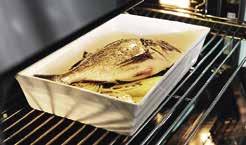
ASA
SELECTION’S 250 °C
PLUS SERIES
This award-winning, multifunctional, all-inone service system takes users from oven to table. The set comprises 36 porcelain dishes, each with a lid and suitable for cooking, serving and eating from.
ASA SELECTION asa-selection.com

COUNTRY ARCHER MINI STICKS AND
SMOKED SAUSAGES
Country Archer Provisions has unveiled its Beef & Cheese Mini Sticks and CheeseInfused Smoked Sausages. Crafted for convenience and high-protein snacking, they offer 4g and 8g of protein per serving, respectively. Made with grass-fed beef, pork and real cheddar cheese, they’re also preservative-free.
COUNTRY ARCHER PROVISIONS countryarcher.com
NEW PRODUCTS PRODUCT ZONE
HOSPITALITY NEWS ME | MAY-JUL 2024 60
THE HOME OF BRANDS TOGETHER WE SHAPE A DYNAMIC ECONOMY
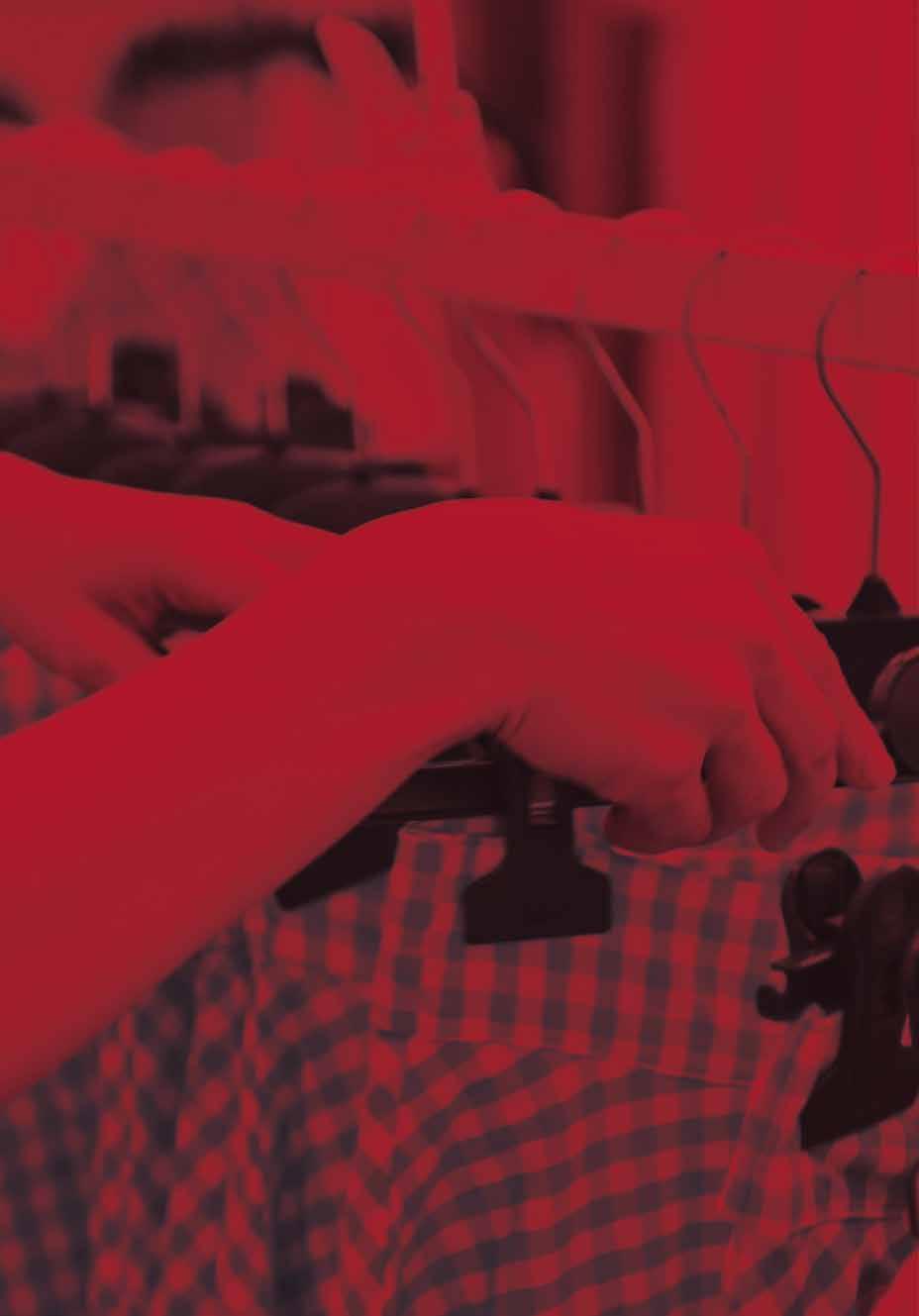
MEET THE MEMBERS JOIN THE FAMILY
ESSENTIAL KIT FOR THE KITCHEN:
MUST-HAVES AND ONES TO WATCH

In today’s high-pressure professional kitchens, chefs are looking for smart, top quality equipment that checks several boxes. We asked five culinary experts to share their essential equipment checklists and tell us about the industry innovations that have caught their eye.

YOUSSEF AKIKI
Chef-owner at Brût, managing partner at Butler’s Table of Kitchen Backstage Board member of The Syndicate of Owners of Restaurants in Lebanon, Lebanon youssefakiki.com Chefyoussefakiki
A cut above
When it comes to selecting essential kitchen equipment, I’m a big fan of the Japanese mandoline slicer. Not only is its blade set diagonally, allowing for greater control and a cleaner cut, but these versions are also lighter in weight. Investing in a good set of knives is also essential for any chef looking to optimize performance. Each knife has a designated use for a certain ingredient, so the full set provides precision, efficiency, safety and versatility.
Checking all the boxes
Selecting the right equipment and tools has a huge impact on overall kitchen operations. Key points to look out for when choosing equipment include:
• Quality - invest in high-quality utensils from reputable manufacturers to ensure durability, performance and safety.
• Functionality - choose utensils that are suitable for the specific tasks and cooking techniques in your kitchen to maximize efficiency and productivity.
• Compliance - ensure that utensils meet relevant food safety and hygiene regulations and standards.
It’s also critical to thoroughly clean tools after each use and maintain and inspect them regularly.
Tech benefits
Smart equipment, especially ovens, is increasingly being viewed as essential among many professionals. This is due to awareness growing about how integrating technology into the kitchen can help to increase efficiency and control over cooking time, temperature and saving energy. Wi-Fi connectivity is also boosting uptake of remote control and AI-powered cooking assistance. These appliances offer convenience, efficiency and precision in cooking tasks. Other innovations that are current talking points across the industry include compact and modular designs, which help to save space, and precision cooking tools, such as sous-vide machines, precision cookers and digital thermometers. These allow chefs to achieve precise cooking temperatures and consistency, resulting in perfectly cooked dishes every time.
Brands of choice
MKN ovens are my go-to make and for knives, I opt for the Kuto Japanese variety. When it comes to molds, my preferred brand is MoldBrothers.
EQUIPMENT PRODUCT ZONE
HOSPITALITY NEWS ME | MAY-JUL 2024 62

FAISAL AHMED ALDELEIGAN
CEO at Chef Faisal Consultancy, Bahrain and Saudi Arabia
cheffaisal.com
cheffaisalco

Quality is key
My culinary journey has taught me that the key to a successful kitchen lies in the quality of the tools used. Durable, high-quality tools not only save money longer term, but also ensure even cooking and consistent results, which are crucial in my kitchen. For me, essential tools include:
• Cookware - I prefer high-grade pots, pans and baking sheets made from materials like stainless steel, cast iron and non-stick surfaces.
• Blenders/food processors - these are lifesavers for creating smooth sauces and pureeing ingredients.
• Thermometers - a reliable thermometer ensures food safety and precision.
• Quality knives: a set of top-notch chef’s knives, including paring knives and serrated knives, is at the core of my culinary creations for precise and efficient cutting and slicing.
Prioritizing efficiency and safety
When selecting utensils, my key criteria are durability, ease of cleaning, material safety and ergonomic design. These aspects are crucial for efficiency and safety. Well-maintained utensils help to ensure consistent food preparation and prevent contamination and unwanted flavors. Regular cleaning is also critical in this regard to avoid food-borne illnesses.
Keeping up to date
Staying abreast of the latest trends and innovations is vital. Some of the innovations currently on my radar are:
• IoT-enabled appliances - with features like remote monitoring and recipe optimization.
• Sous-vide cooking - offering extraordinary precision in temperature control.
• Energy-efficient equipment - reducing operating costs and environmental impact, without compromising on performance.
• Automatic cleaning systems - reducing labor and ensuring top-notch hygiene.
• Alternative cooking methods – exciting innovations for exploring flavors and textures, like induction cooking, steam ovens and combi-ovens.
Go-to companies
MKN stands out as a personal favorite for professional cooking technology, with its blend of classic and innovative solutions. Products like FlexiChef, FlexiCombi and MasterLine from MKN have revolutionized how I combine traditional cooking methods with modern technology. I particularly like the company’s commitment to enhancing kitchen productivity, efficiency and comprehensive customer care and support.

LUCAS GLANVILLE
Senior executive chef at Four Seasons
Hotel Riyadh, KSA fourseasons.com
cheflucasglanville
Essential equipment
Must-have kitchen tools that can elevate a chef’s culinary skills include high-quality knives, a reliable set of pots and pans, precision measuring tools, a quality cutting board and versatile utensils, like spatulas and whisks. Specialized tools such as a mandoline slicer, immersion circulator and a digital meat thermometer, can also enhance a chef’s performance in the kitchen.
Right tools for the job
Commercial kitchen utensils play a crucial role in impacting the taste, quality and safety of food. The selection of utensils should prioritize materials that are safe for food contact, easy to clean and durable. Regular cleaning and proper maintenance are essential to prevent cross-contamination and ensure optimal performance. Stainless steel utensils are often preferred for their durability, resistance to corrosion and ease of sanitization. However, it is important to ensure the equipment is appropriate to the cuisine you are preparing to ensure authenticity and taste.
Smart and green
Emerging trends in kitchen equipment include smart appliances that offer connectivity and automation, sustainable and eco-friendly kitchen tools, and innovations in food preservation techniques. Chefs should also stay informed about advances in precision-cooking technology, such as sous-vide equipment, and explore tools to assist with on-trend methods of pickling and fermenting.
Personal preferences
There are many great brands of kitchen equipment. Key popular and reputable kitchen equipment brands include Marrone for custom-made kitchens, All-Clad and Staub for cookware, KitchenAid and Vitamix for equipment, and hand-crafted Japanese cooks’ knives. However, the choice of a favorite brand often depends on individual preferences, specific needs and the type of cuisine a chef specializes in.
MAY-JUL 2024 | HOSPITALITY NEWS ME 63


FAISAL AL NASHMI
Culinary director at Almakan United Company, Kuwait almakan-kw.com zubaskitchen
Perfect for prep
A high-quality chef’s knife is an essential tool, since it enables users to become more efficient when working on their prep. Presenting food in an attractive manner always includes placing some sort of garnish on a plate which makes tweezers another must-have item. Much better than fingers, tweezers are ideal for delicately controlling the placement and movement of a garnish.
Made to last
Stainless steel and high-quality, hard plastic

ROBERTO SAGLIMBENE
Executive chef at Saadiyat Rotana Resort and Villas, Abu Dhabi, UAE rotana.com saadiyatrotana
Culinary checklist
In the culinary world, having the right kitchen tools is essential for chefs to excel in their craft. Key must-have kitchen tools that can significantly elevate a chef’s culinary skills are:
• A high-quality chef’s knife
• A rubber spatula
• A probe
• An immersion blender
• A kitchen scale
• A Microplane grater
• A Thermomix multi-functional kitchen appliance.
have great qualities that make them ideal for the pressures that we have to deal with daily in a kitchen. They are long-lasting, do not rust, are heavy duty and easy to clean. A utensil must also be the right size and material for its role; for example, using a small whisk in a big saucepan would not be especially effective, while a rubber spatula is unlikely to work when creating a choux pastry, which needs to be vigorously beaten.
Cutting edge cookers
New trends emerge every year and we’re always looking for the latest gadgets to help us with efficiency in our preparation or elevate the textural elements of our dishes. One product that caught my eye last year was the air cooker. The technology controls cooking through steam, due to the tight rubber lock on the oven, which acts as an insulator, ensuring ultimate moistness for proteins or a very high steam injection for baked goods. Another oven which stood out was the Forza STi. Merging the turbo chef speedy cooking with your average deck, this oven cooks a pizza in around three minutes max.
Masterful and multi-functional
Staub is a French, enameled cast-iron pan renowned for its sturdiness and quality. It is highly popular in French kitchens, where it is used as a frying pan and also performs many other functions, including being placed in high heat environments, like ovens, for baking, frying and searing.
Wise buys
I advise choosing utensils that are made of high-quality materials, such as stainless steel or heat-resistant silicone, which are durable, non-reactive and easy to clean. Ergonomics is also important. I suggest opting for utensils with comfortable handles and ergonomic designs, which improve the grip and reduce fatigue. For safety, look for utensils with features like heat-resistant handles, non-slip grips and thumb rests to ensure safe handling and prevent accidents. Once in use, utensils should be regularly cleaned with hot water and mild detergent, and sanitized to prevent bacteria.
High-tech trends
As chefs, it is important to stay updated on emerging trends and innovations in kitchen equipment. Some notable ones include:
• Sous-vide cooking
• Immersion systems like ImmersaFlex
• Smart kitchen appliances
• Sustainable kitchen equipment
• PathSpot technology, networked with the company's HandScanner technology.
Personal priorities
I prioritize the quality, performance and reliability of kitchen tools over any specific brand. Several reputable brands offer excellent products and my preference may vary depending on the specific tool or equipment required.
CULINARY INNOVATIONS
From prepping to presentation, these new pieces of kit will take your kitchen creations up a level.

ALPINE OUTDOOR COLLECTION SKILLET
A versatile essential for cooking over an open flame. Fits on most grills and is crafted from enameled cast iron.
LE CREUSET lecreuset.com
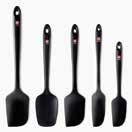
DI ORO SEAMLESS SERIES SPATULA SET
This multiaward-winning spatula set ideally balances strength and flexibility. Comprises: Large; Spoonula; Mini; Long; and Pro 14in.
DI ORO

MEATER PLUS WIRELESS SMART MEAT THERMOMETER
The MEATER Plus Smart Meat thermometer takes the guesswork out of indoor and outdoor cooking.
MEATER meater.us

MILLENIA® WAVY EDGE SLICER
This onepiece, highcarbon Japanese steel slicer offers easy maintenance and rapid sharpening for a razor-sharp edge.
MERCER CULINARY mercerculinary.com
EQUIPMENT PRODUCT ZONE
HOSPITALITY NEWS ME | MAY-JUL 2024 64




PASTA: A STAPLE FOR THE TABLE

Versatile, appealing, nourishing and ideally suited for on-trend vegetarian and plant-based dishes, pasta unsurprisingly continues to place high on lists of favorite dishes across the global restaurant scene. HN asked five experts for their thoughts on all things pasta-related, from go-to varieties and essential tools of the trade to pairing preferences.
FOOD PRODUCT ZONE
HOSPITALITY NEWS ME | MAY-JUL 2024 66

MASSIMO BARTOLINI
Head chef at The Thai Kitchen at Park Hyatt, Dubai leccinoristorante.com chefmassimo90
Rigatoni reigns
I can honestly say that rigatoni is my favorite shape of pasta. Its short, cylindrical shape allows sauces to stick to its ridges and seep into its center, ensuring each bite is packed with flavor. The firm texture holds up well for hearty sauces, like carbonara or meat ragu, while also working beautifully in lighter sauces with vegetables or cream. Rigatoni’s versatility makes it a staple in many dishes. Whether baked in a ‘pasta al forno’ or tossed in a simple Amatriciana or ‘cacio e pepe’ sauce, rigatoni always delivers a satisfying and delicious dining experience.
All about absorption
The thickness and texture of pasta shapes play a crucial role in sauce absorption, influencing both flavor and texture in a dish. Thinner pasta, like angel hair or spaghetti, absorbs less sauce, allowing it to coat each strand lightly for a delicate flavor. In contrast, thicker shapes, such as penne or rigatoni, have more surface area and denser texture, absorbing and holding onto sauces for a more intense flavor experience. This variation allows chefs to tailor dishes to specific culinary needs. Lighter sauces pair well with thinner pasta for a more subtle taste, while heartier sauces cling better to thicker pasta, creating a robust and satisfying meal.

MASSIMILIANO BUGLIOSI
Italian corporate chef at Maillon Group, Lebanon chefmassimilianobugliosi maillongroup
Fresh and artisanal
When making decisions in the kitchen, I generally love cooking fresh pasta, specifically egg tagliatelle or fettuccine. My preference is working with purely artisanal pasta, created from a durum wheat semolina dough.
Targeting the texture
The thickness and texture of pasta shapes have a critical part to play in the dining experience. I believe that this matters most in relation to the consistency that is being sought with the bite and mouthfeel when chewing the food, rather than being linked to the absorption of the condiments, so after the cooking process, rather than during preparation. It is also true that specific varieties of pasta are associated with certain sauces thanks to their thickness and specific shape. One example of this is the 'bucatini' pasta, which is often associated with Amatriciana sauce.
Essential equipment
Pasta can be produced using either the artisanal process or industrially. However the pasta is being made, the roller dough sheeter is certainly one of the essential items needed in the kitchen for production. These can be manual or electric.
A wide appeal
Including pasta dishes on a menu offers several benefits. Firstly, pasta is a versatile ingredient that can be adapted to various cuisines and dietary preferences, appealing to a wide range of customers. Additionally, pasta dishes are often cost-effective to prepare, providing good profit margins for restaurants. They also have a long shelf life, reducing food waste and increasing kitchen efficiency. Pasta is a comfort food for many, providing a satisfying and filling meal option. Dishes can be customized with different sauces, proteins and toppings, allowing chefs to showcase their creativity and keep menus dynamic and exciting. For other alternatives, pasta made from vegetables like spinach or carrots offers added nutrients and colors, while whole wheat pasta is known for its fiber and nutrients. Incorporating a variety of pasta types into a diet can help to ensure a balanced intake of nutrients and flavors.

Versatility a plus point
Pasta is a highly versatile product, which can be served both cold and hot. These and other qualities make it ideal for incorporating creatively into a diverse range of dishes, spanning different cultures and traditions. Another advantage that pasta offers is the numerous shapes and sizes it comes in, from miniature forms to larger pieces. This increases the options for chefs, offering them opportunities to prepare dishes with a variety of consistencies and final presentations.
On-trend options
Pasta is also well placed to accommodate the various food trends currently causing a stir and cater to modern tastes. For example, it can be made with key vegetable and legume ingredients, while other varieties also exist that can support dietary requirements, such as vegan and gluten-free options. On-trend varieties include rice and chickpea pasta. Whole wheat pasta varieties are also popular. In fact, these are my preferred alternatives since I love the health benefits they offer from being high in fiber.
MAY-JUL 2024 | HOSPITALITY NEWS ME 67
 IAIN DICKSON
Head of operations
IAIN DICKSON
Head of operations
Carluccio’s Middle East carluccios.com
carluccios

Pairing for success
When it comes to pasta production, the choice of dye used is significant. For example, utilizing a bronze dye, results in pasta with a textured surface, allowing the pieces to cling more effectively to the pasta. Conversely, using a Teflon dye yields a smooth surface that doesn’t absorb sauce as readily. Consider thin ribbon pasta like tagliolini; these delicate strands pair harmoniously with sauces that complement their lightness. Think of sauces infused with truffles, butter and Parmesan, or perhaps a light and fresh tomato sauce. The thinness of the pasta allows these sauces to coat each strand evenly, enhancing the dining experience. In contrast, thicker, tubeshaped pasta, such as rigatoni, is designed to withstand heartier, longer-cooked sauces like ragùs. The ample surface area and robust structure of rigatoni allow them to hold up well to these rich, deeply flavored sauces, ensuring each bite is packed with deliciousness.
Pasta vs. fillings
Handmade pasta, such as ravioli and tortellini, requires special attention to thickness. Since these types of pasta are often filled and double-layered, starting
with a thin pasta ensures that the final product maintains a delicate balance between pasta and filling. These creations shine brightest when paired with simple, yet luxurious, butter-based sauces that allow their handmade craftsmanship to take center stage.
Streamlining the process
In a professional kitchen, there are specialized tools designed specifically for making pasta with efficiency and precision. One such tool is an extruder machine, which streamlines the pasta-making process by handling tasks like mixing, kneading and shaping the dough. This versatile machine can produce a variety of pasta shapes, from the robust rigatoni to the slender ‘bucatini,’ thanks to its interchangeable dyes.
Opportunities to experiment
The versatility of pasta allows for endless creativity, from experimenting with different sizes to infusing the dough with ingredients like spinach, beetroot or cocoa, adding vibrant colors and enhanced flavors to the final dishes. This approach not only caters to diverse tastes, but also embraces the growing interest in plant-based alternatives, making pasta a dynamic and appealing choice for today’s dining experiences.
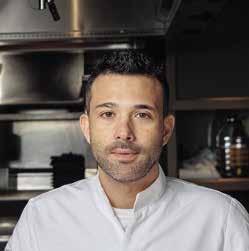
GIUSEPPE PEZZELLA
Group executive chef at Mine and Yours Group, UAE mineandyoursgroup.com giuseppepezzellachef
Homemade memories
My favorite pasta is homemade fresh spaghetti chitarra. Not only does it remind me of the early days in my first restaurant, when I used this shape with crab sauce and Amalfi lemon, but it also goes well with numerous different sauces.
Tools of the trade checklist
There are several specialist tools that professional kitchens often use for making pasta efficiently and with precision. Some of these are: pasta machine; pasta cutter attachment; pasta extruder; pasta drying rack; pasta cooker; pasta tongs; ravioli press; and a pasta rolling pin. These professional kitchen tools streamline the pasta-making process and help chefs produce high-quality pasta dishes consistently.
Creativity at the core
Chefs can create a number of pasta dishes for menus catering to modern tastes and appealing to plant-curious consumers seeking wellness options. These could involve incorporating global flavors into pasta dishes, like creating a Thai-inspired coconut curry pasta with rice noodles. Another idea is using miniature pasta forms, such as orzo, couscous or ditalini, in pasta
salads or side dishes. Hummus pasta, made by tossing cooked pasta with creamy hummus sauce, is a current on-trend alternative, as is the incorporation of plantbased ingredients in pasta dishes, including vegetables, legumes and plant-based proteins like tofu or tempeh. Other ideas to consider are adding creative toppings and garnishes, and customization options, allowing diners to personalize their pasta dishes according to their preferences and dietary restrictions. Rotating seasonal pasta specials featuring fresh, local produce and seasonal ingredients is another tip.
Color and health benefits
Veggie pasta, which is typically made from vegetables like spinach, carrots or beets, blended with flour, often contains added nutrients and fiber, making it a nutritious choice. Whole wheat pasta is made from whole wheat flour, which retains the bran and germ layers of the wheat grain, providing more fiber, vitamins and minerals compared to refined pasta. It has a nuttier flavor and a slightly denser texture and is often recommended for its higher nutritional content and lower glycemic index.
FOOD PRODUCT ZONE
HOSPITALITY NEWS ME | MAY-JUL 2024 68

SAVERIO SBARAGLI
Head chef at Al Muntaha, UAE jumeirah.com chefsaveriosbaragli

Marrying textures and flavors
My top preference is undoubtedly working with fresh stuffed pasta, such as ravioli and ‘plin.’ Thickness and texture are paramount with pasta since they influence the absorption of the sauce and ultimately enhance the overall dining experience. Each pasta shape demands careful consideration of these factors to perfectly complement the accompanying sauce. For example, in my signature dish, ‘ravioli del plin,’ I aim for the thinnest possible dry pasta dough. This delicate thickness allows the pasta to delicately encase the flavorful filling, while ensuring optimal sauce absorption. Understanding the interplay between pasta thickness, texture and sauce absorption, and expertly balancing these elements, is crucial for meeting specific culinary needs.
Professional precision
I rely on a curated selection of essential kitchen tools to craft pasta at a professional level. These include an Italian pasta machine, a pasta wheel cutter and a rolling pin. Other specialized tools I use include emportepièces, also known as pastry or dough cutters, which are invaluable for creating uniform shapes and designs in filled pasta
INSPIRING PASTA PRODUCTS
varieties like tortellini or 'agnolotti.' I also use a cooker specifically designed for cooking pasta perfectly.
Wellness-oriented choices
Plant-based pasta varieties, such as chickpea or lentil pasta, are ideal for catering to modern tastes and growing demand. I am currently experimenting with an eggplant-based ‘ravioli del plin,’ filled with ingredients like burrata, tomato sauce and camel cheese cream, offering a tempting option for plant-curious consumers seeking wellness-oriented choices. This blend of traditional flavors with contemporary twists embodies the essence of modern brunch cuisine, appealing to a diverse range of palates, while showcasing the endless creativity that pasta dishes can inspire.
The wonders of whole wheat
Whole wheat varieties of pasta offer excellent creative opportunities, since they possess a higher starch content, which imparts a delightful texture and thickness to dishes. This added starchiness not only enhances the overall mouthfeel of the pasta, but also contributes to a more robust and satisfying dining experience. For me, the nuanced complexity and hearty texture of whole wheat pasta reign supreme.
From meticulously crafted pasta shapes to flavorsome sauces, these appetizing pasta products will certainly add something special to mealtimes.

ONCE UPON A FARM PASTAS
Once Upon a Farm has introduced new, ready-in-minutes pasta meals in pomodoro, cauli-fredo and spinach varieties, combining nutritious noodles with
farm-fresh veggies and seasonings. ONCE UPON A FARM onceuponafarmorganics.com

SUMA WHOLEFOODS OAT PASTA RANGE
Suma Wholefoods has launched a new range of oat pastas. Available in linguine, rigatoni and casarecce, the pastas are gluten-free and made with organic ingredients.
SUMA WHOLEFOODS suma.coop

BARILLA® CELLENTANI
PASTA
This corkscrew-shaped pasta is ideal for a hearty pasta meal, enhancing refined and simple sauces, and also working well in cold
pasta salads and casseroles. BARILLA barilla.com
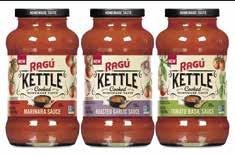
RAGÚ® KETTLE COOKED PASTA SAUCE
These pasta sauces are made using a kettle-cooking process, which brings out the flavors of the premium ingredients and delivers a rich, savory homemade taste. RAGÚ ragu.com

HEINZ’S THE GODFATHER PASTA SAUCE
Inspired by the famous cooking scene in the movie, The Godfather pasta sauce combines sun-ripened tomatoes, olive oil and garlic, with
meatballs, sausage and seasoning. HEINZ heinz.com

PASTINA AND PEPE BUCATO PASTA
Pastene has introduced Pastina and Pepe Bucato, small Italian pasta cuts that are ideal in soups and stews, and made from 100 percent durum semolina. PASTENE pastene.com
MAY-JUL 2024 | HOSPITALITY NEWS ME 69
EXPERTS ON WHAT’S SHAKING UP THE COCKTAIL SCENE
Always dynamic, exciting and pushing boundaries, the world of mixology is forever advancing, driven forward by industry leaders that share a passion for creativity and craftsmanship. Here, four of these experts tell HN what’s in the mix this year, from fresh ingredients to craft spirits and artisanal mixers.


VICTOR DELPIERRE
Gastronomy consultant at VD Consulting, barista and mixologist world champion CIGS 2013, UAE victor_delpierre facebook.com/VictorDelpierre1
Gastronomic inspiration
Cocktail trends vary from one country to another and are also determined by the age of customers, although options like Negroni, Spritz, G&T always remain in demand. Overall, I am delighted to see that the global cocktail industry is really evolving, as evidenced by the following developments:
• Mixologists are increasingly using more high-quality craft spirits created by people who are passionate about what they do and are committed to quality.
• They are also taking inspiration from the gastronomy sector, using pastry techniques and cuisine equipment.
• The non-alcoholic beverage segment has improved beyond recognition and is now growing exponentially.
From my side, I remain focused on experimenting with sustainable chocolate and pastries. Examples include the creations I produced at the St Barth Gourmet Festival Tea Time and Salon du Chocolat de Paris.
Michelin magic
I regard the consultancy and research work I undertake for Michelin chefs as key in my efforts to take my creations to the next level. I am constantly tasting their cuisine to create drinks that align with the DNA of their offerings and this plays a key part in how I set out to elevate my technical skills and creativity. Rather than working with brands, I prefer to seek out new French craft spirits for my creations, produced by people who are passionate about their work. My desire is to help independent producers grow, so that they are able to develop their business and safeguard their expertise.
Something for everyone
When creating cocktail menus, I’ve always found myself drawn to nature, the environment and the history of the establishment and a chef’s DNA for inspiration, rather than looking to current trends. I like to structure a menu so that every single customer will find a cocktail they recognize, but with an additional creative touch. Here, I include non-alcoholic drinks that should be equally imaginative and on par, for customers who are looking for these beverages.
BEVERAGE PRODUCT ZONE
4 HOSPITALITY NEWS ME | MAY-JUL 2024 70

CORALIE DOILLET
Beverage manager at Tashas Group/ Galaxy Bar, UAE galaxy-bar.com, tashasgroup.com galaxybardxb


ANTONIOS RICHMANY
Brand ambassador at Gabriel Bocti, Lebanon gabrielbocti.com richmany.a
Innovation a byword
Several trends have been in evidence so far in 2024. At the beginning of the year, there was a significant surge in the market for non-alcoholic cocktails, notably due to events like Dry January and the upcoming Ramadan. We’ve also witnessed a growing emphasis on sustainability within the beverage and food industry in Dubai, reflecting the city’s demand for it. The other notable trend has been a move toward innovation. Bars and their creative teams are striving to distinguish themselves through innovative techniques, unique glassware and inventive experiences. Our market has experienced rapid growth since last year, showcasing a diverse range of offerings and approaches within Dubai.
Evoking emotions
We elevate our cocktail offering primarily through the experience we provide. We focus on a curated selection of classic cocktails, with our signature offerings drawing inspiration from the traditional cocktail structures. Our aim is for customers to explore our cocktails and discover new ways to enjoy their favorite drinks. We’re committed to evoking emotions through
aromas and flavors, with garnishes playing a significant role in the tasting experience. Our approach involves prioritizing the quality of spirits over specific brands, which allows us to craft menus that are unique and tailored to our own direction. However, we remain open to collaborating with any brand that aligns with our concept and vision. Keeping things fresh Gin and agave-based cocktails have long been popular in Dubai, with G&Ts and Tequila Highballs being top sellers. Currently, there’s a trend toward a healthier lifestyle, leading to increased demand for ‘less-sugar’ and low alcohol-by-volume (ABV) alternatives. In response, bars are continuously innovating and refining their techniques to introduce inventive cocktails to their menus. This innovation often involves techniques such as fermentation, vinegars and cordials, made from fresh ingredients and herbs, and using teas as sodas. In response, we collaborate closely with our partners and suppliers to source the majority of fresh ingredients locally, which also supports our sustainability efforts.
Classic meets modern
The world of cocktails is always buzzing with excitement, and lately, we've seen some thrilling trends shaking up the scene. One development that’s been making waves is the resurgence of classic cocktails with a modern twist. Think innovative riffs on timeless favorites, like the Negroni or the Whiskey Sour. While classics like the Martini and the Old Fashioned will always have their place, there’s no denying the allure of new and exciting creations. Introducing fresh and innovative cocktails to your establishment’s menu is not just about keeping up with the times - it’s about pushing boundaries, sparking curiosity and delighting your guests with unexpected flavor experiences. So my message is go ahead, embrace the new, the bold and the unconventional.
Sustainability is also in the spotlight, with bartenders crafting eco-conscious cocktails using locally sourced ingredients and reducing waste wherever possible. And let’s not forget the rise of low-ABV and alcoholfree options, catering to health-conscious consumers without compromising on flavor.
Selling stories
Elevating your cocktail game is all about creativity, craftsmanship and attention to detail. I believe in starting by sourcing the finest ingredients, from premium spirits to fresh herbs and artisanal mixers. Experiment with unique flavor combinations and innovative techniques to create signature cocktails that leave a lasting impression on your guests. Presentation is key too. And of course, never underestimate the power of storytelling - behind every great cocktail is a captivating narrative waiting to be shared.
Craftsmanship, quality and innovation
As a brand ambassador, I am privileged to collaborate with some of the most iconic names in the spirits industry. William Grant & Sons, Mijenta and the Stoli Group are among my personal favorites, representing a diverse range of spirits that embody craftsmanship, quality and innovation. Working with these brands allows me to explore new horizons, ignite passion and inspire creativity in both myself and others. They are partnerships built on mutual respect, shared values and a shared commitment to excellence.
MAY-JUL 2024 | HOSPITALITY NEWS ME 71

NANA SECHERE
Owner and creative catalyst at Host Masters Consulting (The Host Masters), UAE thehostmasters, nanacoppertone facebook.com/nanacoppertone
Learning from the best
We’ve been fortunate enough to have some incredible trailblazers in bartending and teachers we’re able to follow, such as Kevin Kos and Jordan Hughes (High Proof Preacher) to name just two. These and others are teaching us all some fantastic new techniques. From these, I’d say the biggest talking points in recent years have related to the clarification range of techniques in cocktails and super juices.
Relatable journeys
I’m a firm believer in the old adage ‘If it ain’t broke, don’t fix it’. With that in mind, a great deal of my work is focused on classic cocktail templates and introducing innovative modifiers to enhance the flavors.
I find that starting from this reference point gives me a lot of scope and room to work with. In other words, I can go wild or I can keep it simple and delicious!
FLAVORFUL COCKTAIL CREATIONS
Quench your thirst with these exotic offerings from a selection of the world’s leading beverage producers.

NICHE COCKTAILS RTD COCKTAIL FLAVORS
Niche Cocktails has expanded its ready-to-drink (RTD) premium cocktail selection by introducing two new additions to its lineup: Strawberry Daiquiri, with an 8 percent ABV, and Negroni, with a 14 percent ABV.
NICHE COCKTAILS nichecocktails.co.uk

MALIBU RTD COCKTAILS
Lovers of Malibu can now enjoy three new RTD cocktails from the brand. Available in 1-liter bottles, the cocktails come in Strawberry Daiquiri, Pineapple Bay Breeze and Rum Punch.
MALIBU malibudrinks.com


ABSOLUT BOTTLED COCKTAILS
Absolut Cocktails has launched a new 750ml-bottled line which includes a Vodka Mojito and an alcoholic Raspberry
Lemonade. These cocktails join the brand’s canned range, which launched in 2023. ABSOLUT absolut.com

HORTON READYTO-DRINK CANNED COCKTAILS
Horton RTD canned cocktails are made with real rum,
transporting consumers to tropical climes. The Party Pack includes four individual cans of Diet Kola, Pineapple Soda and Lime Soda, totaling 12 altogether. HORTON drinkhorton.com
BIG SIPZ PURPLE PUNCH
Purple Punch marks a collaboration between the Big Sipz brand and the rapper Waka Flocka. Available in 200-ml primary cups and 330-ml tetras, the new-flavor punch has a 16 percent ABV.
BIG SIPZ bigsipz.com

I’m all for innovation, but I think it’s important to ensure that any application you’re making is one that the average consumer can understand. Sometimes, as drink creators, we get a little too imaginative and it may not always translate particularly well. However, by starting simple, with delicious and easy to understand drinks, then the stage is set to take your customer on a relatable journey of innovation with each menu update. In this way, you’ll land in a great place.
From coconut rum to cordials
As the former ambassador in the region for Beam Suntory, I really love their products, as well as some of the other great Japanese brands. Other brands on my go-to list include Takamaka. I adore this company’s dark spiced rum and Koko (coconut rum liqueur) varieties. Lately, I’ve also been working with ‘Paragon’ by Monin, an amazing single botanical cordial with beautifully complex flavors.

THE COCKTAIL COLLECTION
Diageo has unveiled a new trio of premium ready-to-serve (RTS) cocktails in 500ml bottles. Already available in the UK, the Cocktail Collection comprises Johnnie Walker Old Fashioned; Tanqueray Negroni; and Cîroc Cosmopolitan. DIAGEO diageo.com

MINUTE MAID FLAVORED WINE COCKTAILS
Red Tree Beverages has unveiled three RTS flavored wine cocktails under its Minute Maid brand. Packaged in 1.5-liter, multiserve bottles, the cocktails are available in Lime Margarita, Strawberry Daiquiri and Piña Colada varieties.
COCA COLA coca-cola.com
BEVERAGE PRODUCT ZONE
HOSPITALITY NEWS ME | MAY-JUL 2024 72
4-6 JUN 2024
HORECA OMAN
3
rd Edition
Bringing hospitality professionals and industr y experts together for the only show of its kind in Oman. horecaoman.com
18-20 SEP 2024
SALON DU CHOCOLAT | DUBAI
3rd edition
Salon du Chocolat Dubai is a show dedicated to those passionate about chocolate. Bringing together professional chocolate tasters, chocolatiers and chocolate enthusiasts.
salonduchocolatdubai.com
1-3 OCT 2024
HORECA JORDAN
9th Edition
Bringing together professionals and exhibitors from Jordan and the wider region. horeca-jordan.com
25-27 NOV 2024
SAUDI HOREC A | riyadh 13th Edition
The biggest international food, beverage & hospitality exhibition. saudihoreca.com
25-27 NOV 2024
SAlon du chocolat
2nd Edition
chocolate and pastry held concurrently with Saudi Horeca Riyadh. | RIYADH
The largest event in the world dedicated to salonduchocolat-ksa.com
4-6 DEC 2024
whisky live beirut
7th Edition
A must for whisky enthusiasts and connoisseurs, showcasing the finest and rarest whiskies on the market. whiskylivebeirut.com
HOSPITALITY SERVICES
BUSINESS, FOOD & LIFESTYLE EVENTS
14-16 JAN 2025
HORECA KU WAIT
13th Edition
Kuwait’s annual hospitality and foodser vice event. Horecakuwait.com
8-11 apr 2025
HORECA lebanon
29th Edition
The business meeting place for the hospitality and foodser vice industries. horecashow.com
21-23 APR 2025
TBA BEIRUT COOKING FESTIVAL
9th Edition
The ultimate culinary event highlighting the country’s top chefs, leading food and beverage brands, artisanal products and the art of living. beirutcookingfestival.com
Publications & DIGITAL PLATFORMS
SAUDI JEDDAH
3rd
HOREC A | Edition
KSA's largest food, beverage and hospitality exhibition. saudihoreca.com/jeddah
TBA THE GARDEN SHOW & SPRING FESTIval
17th Edition
An essential destination for outdoor enthusiasts, with plants, flowers and ideas to enhance and decorate outdoor spaces. the-gardenshow.com
TBA
TR AVEL LEBANON
7th Edition
An annual celebration of Lebanon's magnificent beauty spots, travel destinations and the best summer activities. lebanontraveler.com
TBA
SALON DU CHOCOLAT | BEIRUT
6th Edition
HOSPITALITY NEWS MIDDLE EAST
Focusing on the latest news, innovations and trends within the region’s hospitality and foodservice sectors.
Daily news bulletins on hospitalitynewsmag.com
TASTE & FLAVORS
The ultimate English language food and lifestyle reference, packed with recipes, chefs’ picks, gift ideas, home and gardening tips, and lifestyle advice. Daily updates on tasteandflavors.com
LEBANON TRAVELER
Lebanon’s key tourism reference, highlighting the country’s best kept urban and rural secrets, top destinations and activities. Daily updates on lebanontraveler.com
INITIATIVES
A social initiative that reinforces Beirut’s global reputation as a center of excellence, talent and creativity.
the country’s top chocolatiers and hosts the finest chocolate brands and chefs from around the world.
salonduchocolatbeirut.com
Dedicated to chocolate, the salon welcomes COntact us !
Celebrating the finest culinary experiences across Beirut.
valuable
delivering
business
DUBAI +971 0585848018 BEIRUT +961 1 480 081
hosp_services hospitalityservices.me Hospitality Services participate@hospitalityservices.me
CHOCOMANIA
GOLD AND PECAN MOUSSE TARTE
Special get-togethers with families or friends provide a golden opportunity to enjoy this show-stopping pastry treat, which has been shared with HN by Chef Elie Bejjani


Ingredients
For the tart
200g butter
100g icing sugar
250g flour
20g Cacao Barry Extra Brute Cocoa Powder
40g almond powder
1 egg
1 tsp vanilla extract
1g lemon zest
For the pecan paste
70g pecan nuts
35g Callebaut Pure Hazelnut Paste (PNP)
85g Callebaut Gold Chocolate
5g cinnamon powder
For the gold chocolate mousse
240ml milk
40g cream (35% fat)
8g gelatin leaves
400g Callebaut Gold Chocolate
500g half-whipped cream (35% fat)
For the gold chocolate glaze
300g water
250g sugar
300g glucose syrup
20g powdered milk
250g condensed milk
20g gelatin leaves
250g Callebaut Gold Chocolate
50g Callebaut Power 41 Chocolate
To assemble (one tart)
75g ashta paste
4 dates
Preparation
• In a mixing machine, add icing sugar and softened butter. Mix until the texture becomes sandy in color. Add the egg, vanilla and lemon zest and mix until it becomes dough-like. Then add the flour, cocoa powder and almond powder, and mix. Bake at 175°C for 12 minutes.
• Melt the gold chocolate at 35°C. Add the pure hazelnut paste PNP, cinnamon and crushed pecans. Spread onto the baked tart.
• Bring the cream and milk to the boil. Add the gelatin and mix with the gold chocolate to create a ganache. Add the whipped cream and fold. Pour into a silicon mold which is the same in shape as the tart dough. Freeze for 12 hours.
• Bring the water, sugar, glucose and powdered milk to the boil. Add the gelatin and condensed milk. Pour the mixture onto the chocolate. Using a hand blender mix everything until smooth. Leave to rest for at least 12 hours.
• Begin glazing the gold chocolate mousse with the prepared glaze.
• Spread the pecan paste onto the base of the tart. Lay the dates on top of the pecan paste, add the ashta and position the glazed gold mousse.
EMF Middle East t. +961 9 938732 | info@emf-me.com www.emf-me.com
PRODUCT ZONE HOSPITALITY NEWS ME | MAY-JUL 2024 74





Hospitality News ME is powered by: 43 AUTOMATIC BREWERS 11 BURJ ON BAY HOTEL 1-77 CAFE NAJJAR 30-31 CERTIFIED ANGUS BEEF 78 EMF TRADING 59 FUTURE HOSPITALITY SUMMIT KSA 17 HODEMA 75 HORECA NETWORK 61 LEBANESE FRANCHISE ASSOCIATION 22-23 QATAR TOURISM 2 ROTANA HOTELS 76 SIAL FRANCE 65 SYNDICATE OF OWNERS OF RESTAURANTS 55 UNIDO 21 VALRHONA READ MORE ONLINE HOSPITALITYNEWSMAG.COM Contact for more information: middleeast@promosalons.com – Tél : +966 12 6682689 October 19 - 23 2024 PARIS -50% YOUR BADGE AT 39-AP-SIAL-PARIS-2024-205x145-GOLF-ARABIQUE.indd 1 04/04/2024 08:17 HOSPITALITY NEWS ME | MAY-JUL 2024 76
ADVERTISERS

Beyond beans lies a symphony, a masterpiece meticulously crafted with the utmost care and passion. This coffee is a fusion of flavors crafted with expertise to deliver a unique taste in every sip. And when quality, craftmanship and passion blend together, Espresso becomes a masterpiece.
NAJJAR GIA COFFEE offers: The finest blends of beans carefully sourced from the leading suppliers around the world.
Exquisite Collection of Espresso Beans and Capsules.
najjareshop.com
































































 ROAA SAUD SABER
ROAA SAUD SABER
 EVGENIYA SOKOLOVA Founder, chocolatier and general manager of Golden Gazelle Chocolate ggcqatar.com
EVGENIYA SOKOLOVA Founder, chocolatier and general manager of Golden Gazelle Chocolate ggcqatar.com















































































































 IAIN DICKSON
Head of operations
IAIN DICKSON
Head of operations








































